Sites: news | india | latam | brasil | indonesia
Feeds: news | india | latam | brasil | indonesia
topic: Gorillas
Social media activity version | Lean version
Gorilla permit fraud dents community-led conservation efforts in Uganda
- Foreign tourists pay $600-$700 per person for gorilla-tracking permits issued by the Uganda Wildlife Authority, which allow them to track and spend an hour with human-habituated mountain gorilla families.
- A recent audit at the UWA showed that some corrupt officials were issuing fake permits, diverting revenue away from the agency and impacting its conservation work, including project funding for communities at the frontline of gorilla conservation.
- In response, the agency suspended 14 staff members suspected of fraud, initiated a thorough probe, and rolled out a new system for issuing permits and collecting revenue.
- Communities living near the gorilla parks, many of whom have faced restrictions on traditional rights to the forests as a result of their protected status, say they’re aware of the scandal and that it’s only the latest in their litany of grievances against the UWA.
Elephants invade as habitat loss soars in Nigerian forest reserve
- Elephants straying out of Afi River Forest Reserve in the Nigerian state of Cross River are reportedly damaging surrounding farms.
- This uptick in human-wildlife conflict comes as satellite data show continuing and increasing deforestation in the Afi River reserve and other protected areas.
- The habitat in Afi River Forest Reserve provides a crucial corridor that connects critically endangered Cross River gorilla populations in adjacent protected areas.
- As in other Nigerian forest reserves, agriculture, poverty and a lack of monitoring and enforcement resources are driving deforestation in the Afi River reserve.
Camera trap images of rare gorillas with infants bring hope in DRC
- Camera traps in the Tayna Nature Reserve in the Democratic Republic of Congo have recorded two mother-infant pairs of eastern lowland gorillas, confirming the presence of healthy family groups in one of their last strongholds.
- This subspecies is critically endangered, with only 6,800 individuals left in the world, and is threatened by hunting, deforestation and mining activities
- Gorilla Rehabilitation and Conservation Education (GRACE) operates the world’s only sanctuary for rescued eastern lowland gorillas, and employs local communities in a key role in monitoring efforts in Tayna.
Mountain gorilla reproduction slows with female transfers, study shows
- Successful conservation interventions have helped mountain gorilla populations recover from 620 in 1989 to more than 1,000 today.
- However, mountain gorilla habitat is not expanding, and a growing body of research indicates that increasing density comes with a price: More groups sharing territory leads to more frequent intergroup violence.
- A new study finds that when intergroup contact increases, so do transfers of females between groups, leading to delayed reproduction.
- The study also emphasizes that multiple factors, such as delayed reproduction and increased mortality, cascade to create a slowdown in population growth.
Study highlights ‘friends with benefits’ relation between gorillas and chimps
- A new long-term study points to lasting social relationships between chimpanzees and gorillas in the wild.
- The study showed that individuals from both species actively seek out each other in a variety of contexts.
- The benefits of these interactions go beyond protection from predators, and include learning social skills and finding fruiting trees.
- But these social interactions also provide the potential for transmission of deadly diseases like Ebola, which pose as big a threat to the long-term survival of gorillas and chimps as hunting and habitat destruction.
Thai zoos come under scrutiny again as tourism rebounds from COVID-19
- The welfare of rare and often threatened species in Thailand’s tourism and pet trades has long been a concern for animal rights activists.
- The conditions in which many of the animals are kept became even direr during the COVID-19 pandemic, when border shutdowns meant no visitor revenue to care for the animals.
- NGOs are working to rescue and rehabilitate some of the animals from zoos and private owners, but acknowledge that few, if any, of the animals can ever be released back into the wild.
- They add that rescue and rehabilitation is only part of the solution, and that more focus should go on protecting the natural environment and habitats of these animals over the long term.
Study highlights elusive Cameroonian gorillas, and the threats encircling them
- Ebo Forest in southwestern Cameroon hosts a rare and enigmatic population of western gorillas.
- A new study analyzes how gorillas use the forest, finding they primarily inhabit just 2,200 hectares (5,400 acres) within the 200,000-hectare (490,00 acre) forested area, and seem to spend much of their time in small patches of grassland rather than forest.
- Experts say they hope the findings will help guide conservation efforts for the critically endangered species.
- While not directly targeted for hunting, the gorillas face a multitude of threats, including gathering of forest products, a road construction project, and the secondary effects of other species in their habitat being hunted for bushmeat.
Road projects threaten integrity of Uganda’s mountain gorilla stronghold
- Ugandan authorities are considering two road projects through Bwindi Impenetrable National Park, home to half of the world’s population of endangered mountain gorillas.
- The proposed new road will impact connectivity between Bwindi and Sarambwe Nature Reserve in the neighboring Democratic Republic of Congo, says the International Gorilla Conservation Programme.
- Most conservationists don’t dispute the need for improved road infrastructure for nearby communities, but say they’re concerned the government is overlooking less harmful alternatives.
Saving Nigeria’s gorillas was also meant to help communities. It hasn’t (analysis).
- In this analysis, Mongabay contributor Orji Sunday reflects on conversations with people living in and around Nigeria’s Cross River National Park, established in 1991 to protect Cross River gorillas and other threatened species.
- For many people in the area, conservation, whether under British colonial rule or since independence, has been experienced as a loss of autonomy and livelihood, and as a string of broken promises of prosperity.
- With few alternatives and a growing population, people describe becoming ever more dependent on forests and wildlife to survive, regardless of their personal feelings about conservation and apes.
- Well-designed and monitored alternative livelihood initiatives show some chances of success, but scaling them up, and consistently monitoring them, remain challenging.
Call for COVID rules that reduced infections in gorilla parks to remain
- Respiratory infections recorded among mountain gorillas in Rwanda’s Volcanoes National Park dropped from a pre-pandemic average of 5.4 outbreaks among family groups to just 1.6 per year since the start of the COVID-19 pandemic in March 2020.
- Conservation group Gorilla Doctors, whose Rwanda team recorded the decrease in infections, says the decline correlates with lower visitor numbers to the park as well as masking requirements and an increase in the distance tourists must stay from habituated apes.
- In a recent letter in the journal Nature, Gorilla Doctors and the park’s chief warden called for these stricter measures to be kept in place permanently.
Deadly raids are latest case of abuse against Indigenous Batwa in DRC park, groups say
- The number of attacks by security forces on Indigenous Batwa villages in the Democratic Republic of Congo’s Kahuzi-Biega National Park has tripled in the past four weeks, according to the Forest Peoples Programme (FPP).
- DRC soldiers and park rangers are accused of burning several Batwa villages to the ground, killing one man and possibly a pregnant woman, and injuring at least two other women during raids that continued until mid-December.
- Indigenous rights groups have demanded a formal investigation into the reports, and called on park funders to pay attention to alleged crimes committed using their money.
- Park officials have denied that there are any Batwa communities officially living inside the park, and say the target of the raids is an armed man that carried out a deadly attack in the city of Bukavu.
Lockdown underscores Uganda’s overreliance on tourism to fund conservation
- When the COVID-19 pandemic broke out in March 2020, Uganda quickly shut down parks like Bwindi Impenetrable National Park to protect the gorillas and chimpanzees from getting infected.
- Tourism provides up to 60% of the Uganda Wildlife Authority’s operating revenue and is also an important source of income for communities living around Bwindi.
- Poaching in Bwindi rose sharply during lockdown in 2020 as some villagers entered the park to hunt for food or an income.
- One NGO reinforced its programs supporting public health and livelihoods in an attempt to reduce this pressure.
Uganda’s ‘Dr. Gladys’ honored by U.N. for work linking conservation and health
- The United Nations on Dec. 7 recognized Gladys Kalema-Zikusoka as one of its “champions of the Earth” for promoting the One Health approach to conservation in Africa.
- The Ugandan conservationist, a trained wildlife veterinarian, established the NGO Conservation Through Public Health (CTPH) in 2003 to ensure better health care access for communities living around Bwindi Impenetrable National Park and to lower the risk of human pathogens jumping to mountain gorillas.
- UNEP selected Kalema-Zikusoka for its science and innovation category; the other awardees were Barbados Prime Minister Mia Mottley, Kyrgyz youth activist Maria Kolesnikova, and the nonprofit Sea Women of Melanesia.
- “If you make the community feel that you care about them, then there’s less need to fight them,” Kalema-Zikusoka said.
For world’s rarest gorillas, camera traps prove pivotal for protection
- Cross River gorillas are Africa’s rarest and most endangered ape, once thought to have already been driven to extinction.
- Camera traps have emerged as a critical tool for monitoring the health and population sizes of the subspecies.
- Recent images have shown multiple young gorillas, which conservationists take as a sign that protection measures are working, and which have also helped raise awareness and funding for Cross River gorilla conservation.
In rural Nigeria, the magic of cinema builds support for ape conservation
- Since 2006, the Wildlife Conservation Society (WCS) has worked with local groups to screen documentaries about apes in dozens of communities adjoining protected areas where Cross River gorillas are still found.
- The films aim to build knowledge about apes and support for conservation; conservationists say film screenings, which are still a novelty in rural areas, attract a broader audience than radio shows, town hall meetings or other outreach methods.
- Though they live close to ape habitats, for many people in these rural communities, films are as close as they will come to encountering the rare and cryptic animals that live nearby.
Deforestation soars in Nigeria’s gorilla habitat: ‘We are running out of time’
- Afi River Forest Reserve (ARFR), in eastern Nigeria’s Cross River state, is an important habitat corridor that connects imperiled populations of critically endangered Cross River gorillas.
- But deforestation has been rising both in ARFR and elsewhere in Cross River; satellite data show 2020 was the biggest year for forest loss both in the state and in the reserve since around the turn of the century – and preliminary data for 2021 suggest this year is on track to exceed even 2020.
- Poverty-fueled illegal logging and farming is behind much of the deforestation in ARFR. Resource wars have broken out between communities that have claimed the lives of more than 100, local sources say.
- Authorities say a lack of financial support and threats of violence are limiting their ability to adequately protect what forest remains.
On Nigeria-Cameroon border, joint patrols throw a lifeline to threatened apes
- The rugged, isolated forests along the Nigeria-Cameroon border support a vast array of wildlife, including Cross River gorillas, Nigeria-Cameroon chimpanzees, and forest elephants.
- Historically, limited law enforcement in the border zone has left the ecosystem vulnerable to hunting and logging.
- Since the early 1990s, though, NGOs have been working alongside both governments to enhance transboundary conservation efforts, including joint patrols by rangers from both countries.
- This cross-border collaboration faces many obstacles today, including bureaucratic delays, treacherous terrain, armed poachers, and violent conflict in Cameroon, but participants remain optimistic about the potential for cooperation.
COVID could wreak havoc on gorillas, but they social distance better than we do
- A new study models the potential impacts of a COVID-19 outbreak in mountain gorillas using 50 years of population data collected in Rwanda’s Volcanoes National Park with epidemiological variables gathered on COVID-19 infection in humans.
- In most of the scenarios modeled, gorilla populations were found to decline sharply within 50 years of an outbreak.
- Questions remain as to whether the human epidemiological variables used in the analysis are a good fit for gorillas, which spend all of their time outdoors and interact with non-family members far less frequently than humans do.
High risk, low pay for DRC rangers entrusted to guard a gorilla sanctuary
- Marie Jeanne Bora Ntianabo was drawn to the extraordinary commitment of park rangers while she was still a child.
- Now 29, she loves her job as a ranger despite danger of being ambushed by poachers or armed groups operating in Kahuzi-Biega National Park.
- The work doesn’t pay well, especially due to reduced numbers of tourists that the park depends on for revenue, but Ntianabo says she isn’t tempted by the profits others seek while harming the park’s ecosystems and wildlife.
Gorilla baby boom sparks hope in DRC, but threats to great apes persist
- For three years in a row, Virunga National Park in the eastern Democratic Republic of Congo (DRC) has been reporting new births in gorilla families.
- According to park officials, the baby boom is thanks to conservation efforts in Virunga that have promoted wildlife development.
- Conservationists warn that armed groups in the park still pose a threat to gorillas, as do moves to reclassify parts of protected areas for mining.
‘Acts of poaching and other crimes’: Cameroon plans a new road in Lobéké National Park
- Cameroon has notified UNESCO of plans to build a road in Lobéké National Park, part of the World Heritage listed Sangha Tri-National protected area.
- The country’s Minister for Forestry and Wildlife says the road will help to secure the area against cross-border poachers and others engaged in criminal activities, but conservationists are concerned it could facilitate deforestation.
- A study of Gabon’s Minkébé National Park linked heavy poaching in the north of the park to easy access via a highway just across its border with Cameroon.
Causes for celebration, and concern, on World Gorilla Day
- As conservationists across the globe observe World Gorilla Day this Sept. 24, all species and subspecies of the ape remain either endangered or critically endangered.
- It’s not all bad news for gorillas, though, as conservation strategies have led to concrete gains, including growth of some gorilla populations.
- Here, Mongabay reflects on some of the lessons from this year’s news and new research.
For World Gorilla Day 2021, a conservation success story
- The NGO that helped establish World Gorilla Day — the Dian Fossey Gorilla Fund — has learned a few important lessons for the conservation of gorillas and other species over the years.
- Firstly, conservation can’t happen without local support: when community members they work with come to understand the importance of the habitat that surrounds them, the project can succeed. Another lesson is that conservation takes time, money and diversification.
- “By engaging rather than excluding communities and ensuring that local people benefit from conservation, we have found that we can protect wildlife with a footprint that is 15 times smaller than that for mountain gorillas.”
- This article is an analysis for World Gorilla Day 2021 by the chief scientific officer of the Dian Fossey Gorilla Fund, and does not necessarily reflect the views of Mongabay.
Domestic bushmeat consumption an “urgent” threat to migratory mammals, U.N. says
- A recent U.N. report has found that many migratory mammals are in grave danger of being hunted for meat for domestic consumption, which in many cases poses a greater risk to population numbers than international trade.
- There is also strong evidence that wild meat taking and consumption is linked to zoonotic diseases.
- The authors say that while wild meat consumption cannot be eliminated because it is an indispensable source of nutrition and income for rural communities, they call for improved national regulations and international cooperation to safeguard threatened species.
For Africa’s great apes, even ‘best-case’ climate change will decimate habitat
- Africa’s great apes stand to lose up to 94% of their current suitable habitat by 2050 if humanity makes no effort to slow greenhouse gas emissions, a new study warns.
- Even under the “best-case” scenario, in which global warming can be slowed, gorillas, chimpanzees and bonobos would still lose 85% of their range.
- The apes’ habitat is under pressure from human encroachment, clearing of wild areas, and climate change impacts that are rendering existing habitats no longer suitable.
- Researchers say there’s a possibility of “range gain,” where climate change makes currently unsuitable areas habitable for the apes, but warn it could take the slow-adapting animals thousands of years to make the move — much slower than the rate at which their current habitat is being lost.
Overcoming community-conservation conflict: Q&A with Dominique Bikaba
- Kahuzi-Biega National Park in eastern Democratic Republic of Congo (DRC) is renowned for its biodiversity. The area is also home to the Batwa people, who are highly dependent on its forests for their livelihoods and cultural traditions.
- Efforts to protect these forests are challenged by conservation’s mixed record: Kahuzi-Biega’s expansion in the 1970s forced the displacement of thousands of local people, turning them into conservation refugees and sowing distrust in conservation initiatives.
- One of the local organizations leading efforts to overcome these challenges is Strong Roots Congo, which was co-founded by Dominique Bikaba in 2009. Strong Roots Congo puts the needs of local people at the center of its strategy to protect endangered forests and wildlife in eastern DRC.
- “Strong Roots’ approach to conservation is bottom-up, collaborative, and inclusive,” Bikaba said during a recent conversation with Mongabay founder Rhett A. Butler.
In DRC, community ownership of forests helps guard the Grauer’s gorilla
- The Congolese government has officially recognized community ownership of a conservation area linking two national parks in the Democratic Republic of Congo, giving hope for the survival of the Grauer’s gorilla, a critically endangered species.
- The gorilla, found only in DRC, faces threats from habitat loss, poaching for bushmeat, and the effects of lingering civil unrest in the region.
- The Nkuba Conservation Area is co-managed by local communities and the Dian Fossey Gorilla Fund, with the latter providing jobs and training initiatives for women.
- The years-long effort to develop the conservation area and now to maintain it points to the importance of engaging local communities in conservation.
New survey nearly doubles Grauer’s gorilla population, but threats remain
- A recent survey led by the Wildlife Conservation Society has revised the population estimate for Grauer’s gorillas to 6,800, up from a 2016 estimate of 3,800.
- The survey includes data from the Oku community forests in the eastern Democratic Republic of Congo, which could not be surveyed in 2016 due to security issues.
- Endemic to the eastern DRC, Grauer’s gorillas are still classed as critically endangered, and face threats due to mining and bushmeat hunting.
- The large numbers of gorillas observed in the community forests surrounding Kahuzi-Biéga National Park underscore the importance of engaging local communities in conservation.
For Africa’s great apes, a post-pandemic future looks beyond tourism
- From the beginning of the COVID-19 pandemic, primatologists assumed great apes would be susceptible to the virus and took measures to avoid transmission to captive and wild populations.
- Precautionary measures like closing parks and sanctuaries to visitors have so far prevented an outbreak in wild apes, but have had a massive impact on the ability of conservation groups and government agencies to fund themselves via tourism.
- A year into the pandemic, the revenue shortfall is prompting a serious rethink of funding models for ape conservation that don’t rely on tourism.
Caring for those ‘just like us’: Q&A with vet and great ape advocate Rick Quinn
- Veterinarian Rick Quinn is the founder of Docs4GreatApes, a charitable organization that supports health care for great apes while also helping the communities surrounding them and the environment they share.
- His new book, with an introduction by Jane Goodall, chronicles the lessons he learned about ape conservation in Africa and Asia, accompanied by his own photos of gorillas, bonobos, chimpanzees and orangutans; all proceeds go back into supporting his foundation’s work.
- He emphasizes the importance of community well-being and empowerment as part of effective conservation, pointing to initiatives where building trust and creating goodwill led to communities becoming willing partners in gorilla conservation.
- In an interview with Mongabay, Quinn discusses his new book, his discomfort with the kind of selfie tourism that puts great apes at potential risk, the COVID-19 pandemic, and his role as an activist veterinarian.
First COVID-19 cases in zoo gorillas raise alarm about wild populations
- Gorillas at San Diego Zoo in California have tested positive for COVID-19, the first cases of the novel coronavirus infecting great apes.
- Gorillas, chimpanzees, bonobos and orangutans share more than 95% of the human genome and are known to be at risk from certain human diseases.
- Zoo authorities said an asymptomatic staff member might have infected the gorillas.
- The news is likely to send alarm bells ringing, especially in Africa, home to the only wild populations of gorillas, chimpanzees and bonobos.
Conservation must be primary goal of great ape tourism, despite COVID-driven recessions (commentary)
- The months-long closure of national parks and continued travel restrictions due to COVID-19 has disrupted a critical revenue source for great ape conservation: sustainable tourism.
- Countries which rely on tourism as a significant source of their GDP must continue to place biodiversity principles at the heart of recovery efforts, and explore alternative livelihood options for local communities.
- Where great ape tourism is concerned, conservation must always be the primary goal of any endeavor.
- This article is a commentary, the views expressed are not necessarily those of Mongabay.
Podcast: A radio program is helping save critically endangered gorillas in Nigeria
- Community-based conservation measures are key to protecting the Cross River gorilla, and a radio program that reaches as many as 4 million listeners in Nigeria is encouraging local community members to become active participants in conservation.
- On today’s episode of the Mongabay Newscast, we speak with Hillary Chukwuemeka, host of the radio program, which is called “My Gorilla My Community.” Chukwuemeka talks about why radio is an effective medium for community engagement in Nigeria and the impacts he’s seen from time spent in local communities on the front lines of conservation.
- We’re also joined by Inaoyom Imong, program director for the Cross River landscape with Wildlife Conservation Society Nigeria and a member of the IUCN Primate Specialist Group, who discusses the major threats to Cross River gorillas, the main barriers to their conservation, and why community-based conservation measures are so important in this context.
Beyond tourism: A call for business ideas that protect African wildlife, ecosystems
- The African Leadership University has launched an innovation challenge to develop new commercial ideas for rural livelihoods that protect biodiversity.
- Wildlife tourism is the best-known “conservation business,” but it’s unclear how much it directly contributes to funding conservation, even if it recovers from the COVID-19 pandemic.
- Applicants to the innovation challenge will develop non-tourism business ideas that will protect ecosystems, empower communities, and convince investors they are both scalable and financially sustainable.
Podcast: Great ape ‘forest gardeners of Africa’ benefit from conservation victory
- Great ape conservation in Africa relies on forest protection, and vice versa.
- On this episode of the Mongabay Newscast, we take a look at two stories that illustrate how conservation of Africa’s Great Apes — chimpanzees and gorillas — often goes hand in hand with forest conservation efforts.
- We welcome to the program Ekwoge Abwe, head of the Ebo Forest Research Project in Cameroon. Abwe tells us the story of how he became the first scientist to discover Nigeria-Cameroon chimpanzees using tools to crack open nuts and discusses ongoing efforts to safeguard Ebo Forest against the threats of oil palm expansion and logging.
- We also speak with Alex Chepstow-Lusty, an associate researcher at Cambridge University who shares how chimpanzees were among the seed-dispersing species that helped central Africa’s rainforests regenerate after they collapsed some 2,500 years ago.
Cameroon halts logging plans in Ebo Forest, home to tool-using chimps
- The Cameroon government announced that a logging concession for Ebo Forest, which was approved three weeks ago, has been cancelled.
- Ebo Forest is a large, intact forest system in southwestern Cameroon that is a refuge for a number of endangered and critically endangered species, including a population of Nigeria-Cameroon chimpanzees with a unique repertoire of tool use.
- While conservationists are optimistic about this news, they are also concerned that the future of the forest still remains uncertain.
For tool-wielding chimps of Ebo Forest, logging plan is a ‘death sentence’
- Ebo Forest is the largest intact forest system in southwestern Cameroon, spanning more than 200,000 hectares (500,000 acres), and providing refuge to a multitude of rare species, including Nigeria-Cameroon chimpanzees, drills, and a tiny and enigmatic population of western gorillas.
- The Cameroon government recently approved a logging concession for Ebo Forest, which would allow trees in 68,385 hectares (169,000 acres) of the region to be harvested, despite opposition from conservationists and local communities.
- Ebo Forest was previously slated to be transformed into a national park, an effort spearheaded by WWF, but plans were dashed in 2013, reportedly because of lack of funding.
- Conservationists worry that logging, and any concomitant activities, such as illegal forest destruction and poaching, will place considerable pressure on endangered and critically endangered species, and that the biodiversity of the forest would be compromised.
Nigeria’s wildlife traders, who weathered Ebola, eye post-COVID-19 boom
- Restrictions imposed by the Nigerian government to slow the spread of COVID-19 have hampered field operations of conservation agencies and NGOs, who are turning to creative and high-tech solutions to maintain operations.
- Conservationists fear that a reduction in patrols and enforcement leaves Nigeria’s biodiversity — already under pressure due to a vast wildlife trade — extremely vulnerable.
- In Nigeria’s wildlife markets, some traders report a downturn due to a generally slow economy, and to movement restrictions on customers. However, they say a ban on interstate travel has not stopped the flow of wildlife products between forests and cities.
For the world’s rarest gorillas, a troubled sanctuary
- Afi Mountain Wildlife Sanctuary (AMWS), near the Nigeria-Cameroon border, was established in 2000 to serve as a refuge for endangered primates including Cross River gorillas.
- Of an estimated 300 Cross River gorillas, around 100 live in a patchwork of adjoining protected areas: AMWS, Mbe Mountains, and the Okwangwo division of Cross River National Park.
- Though officially protected, the AMWS suffers from encroachment for hunting, logging and agriculture. Conservationists say rangers and resources are too few to effectively protect the sanctuary.
- Without a major commitment from the Cross River state government, the sanctuary “may very well be doomed,” one expert says.
Camera snaps first ever glimpse of a troop of the world’s rarest gorilla
- A camera in Nigeria’s Mbe Mountains captured the first known images of a large group of Cross River gorillas, including adults, juveniles and babies, according to the Wildlife Conservation Society (WCS).
- It’s estimated that there are about 300 Cross River gorillas left in the world, with about a third of the population living in three contiguous sites in Nigeria, and 30 to 35 individuals based in the Mbe Mountains.
- Due to conservation efforts, no Cross River gorillas have been reported poached since 2012, according to WCS.
Loss, resilience and community amid an outbreak: Q&A with gorilla researcher Magdalena Bermejo
- Magdalena Bermejo, a prominent expert on western lowland gorillas, experienced the loss of thousands of the great apes to Ebola, including two groups she and her team were studying and had worked to habituate.
- Having remained in the Republic of Congo, Bermejo is now facing the arrival of a new epidemic that could potentially spread between humans and gorillas.
- In this interview, Bermejo discusses her ongoing work in the Congo, the importance of working with communities, parallels between Ebola and COVID-19, and how researchers can find the strength to persevere and rebuild in the aftermath of catastrophe.
For Freedom the gorilla, a months-long journey back to the wilds of Cameroon
- In August 2019, a lone male gorilla wandered into a primate sanctuary in Cameroon, likely in search of a mate.
- Because the sanctuary is in a heavily populated area, Ape Action Africa, which operates the Mefou Park, felt an immediate release would not be safe for the gorilla or the surrounding communities.
- After a painstaking search for a suitable release site, the ape, named Freedom, became the first rescued gorilla to be returned to the wild in Cameroon.
Twelve rangers killed in latest Virunga Park incident
- Virunga National Park officials say 17 people were killed in a sustained attack not far from the park’s headquarters.
- Armed rebel groups involved in poaching and illegal charcoal production are believed to be responsible.
- Virunga National Park was closed for 8 months from May 2018 following a spate of attacks on visitors by armed groups.
For great apes at risk of infection, COVID-19 is also an economic threat
- With flights grounded, parks closed and countries on lockdown, COVID-19 has dealt a major blow to great ape-focused ecotourism operations in Africa and Asia.
- Many conservation activities rely directly on revenue from tourism, and the money tourism brings in also provides a financial incentive for governments and local communities to protect wildlife.
- If lockdowns persist for months, the consequences could be devastating for fragile ape populations and the communities that surround them.
- The situation has re-emphasized the need for conservation groups to diversify their fundraising strategies, experts say.
National parks in Africa shutter over COVID-19 threat to great apes
- Wildlife authorities in some parts of Africa have effectively locked down parks that are home to gorillas, chimpanzees and bonobos, amid concerns that the COVID-19 pandemic could make the jump to great apes.
- Humans and great apes share more than 95% of the same genetic material, and are susceptible to many of the same infectious diseases, ranging from respiratory ailments to Ebola.
- Virunga National Park in the Democratic Republic of the Congo shut its doors to tourists this week, while in Rwanda all parks hosting gorillas and chimpanzees were also shut; Uganda is considering doing the same, with its parks de facto closed because of a drop in tourist arrivals.
- Even if the apes avoid COVID-19, the loss of tourism revenue for the parks and potential loss of income for people who work to protect these species could cause enduring damage to conservation efforts, experts say.
Keeping gorillas safe amid COVID-19 concerns
- Gorillas are vulnerable to human diseases, including respiratory illnesses, and may be susceptible to infection by COVID-19.
- Researchers and trackers working for the Dian Fossey Gorilla Fund, a conservation nonprofit in Rwanda, are taking special precautions to prevent the spread of COVID-19 to the gorillas they study and protect in the wild.
- Economic turmoil from COVID-19, including loss of tourism revenue, could spell trouble for gorilla conservation.
To save Cross River gorillas, EU-funded program aims to empower communities
- The Cross River gorilla, which lives in the mountainous border area of Nigeria and Cameroon, is Africa’s most threatened ape, with a population estimated at fewer than 300 individuals.
- The European Union will provide 2 million euros ($2.19 million) over four years to help support programs aimed at protecting Cross River gorillas by supporting sustainable livelihoods for people living near gorilla habitat.
- The funding will support work led by the Wildlife Conservation Society and Nigeria National Park Service.
- It will allow existing WCS livelihood programs in Cross River state to be expanded to more areas and communities, aimed at preventing locals from deforesting the area in search of a livelihood.
Western lowland gorillas may be territorial, a new study finds
- A new study presents evidence of territoriality among western lowland gorilla groups in the Republic of Congo.
- Camera trap images revealed that groups avoided one another and also stayed away from the central area of each other’s home ranges — evidence that the species may be more territorial than previously thought.
- An estimated 80% of western lowland gorillas live outside of protected areas, where shrinking territory due to forest loss and habitat fragmentation is a big problem.
- This new information on their territoriality, combined with their shrinking habitat, means gorillas may experience increased competition for food as well as for the limited space.
Camera traps confirm presence of lowland gorillas in central mainland Equatorial Guinea for first time in over a decade
- Images of wild western lowland gorillas have been captured by camera traps deep in the jungles of central mainland Equatorial Guinea, marking the first time that the region’s gorillas have been caught on film in more than a decade.
- Camera traps deployed by conservationists with the Bristol Zoological Society (BZS) and the University of West of England (UWE) took the photos in Monte Alén National Park, which is located in central Rio Muni, the mainland region of Equatorial Guinea. Local communities had reported gorilla sightings in the region, but conservationists hadn’t seen the animals for themselves until now.
- The photographs were taken in Monte Alén National Park and are significant because they confirm the gorillas’ continued existence despite heavy hunting pressure.
Mountain gorilla census reveals further increase in numbers
- A census of one of the two populations of mountain gorillas living in eastern Africa revealed an increase from 400 to at least 459 individuals, bringing the total count for the subspecies to 1,069 gorillas.
- Teams conducted the survey in the Bwindi-Sarambwe ecosystem straddling the border between Uganda and the Democratic Republic of Congo in 2018.
- An earlier survey of the other population living in the Virunga Mountains of DRC, Uganda and Rwanda showed that gorilla numbers there are also on the rise.
- That led to a change in the subspecies status on the IUCN Red List from critically endangered to endangered.
Female gorillas recognize and respond to contagious disease
- An infectious skin disease causing bright red facial lesions affects how female gorillas decide to change social groups, researchers have shown.
- Decade-long observations of nearly 600 gorillas in the Republic of the Congo revealed females are more likely to leave groups with severely diseased females or an infected silverback male.
- By reducing contact with sick individuals, females can decrease the risk of being contaminated and prevent further spread of the infection in the population.
Agriculture, mining, hunting push critically endangered gorillas to the brink
- Maiko National Park is one of the most logistically challenging parks in the DRC and one of the most biodiverse. It is one of just two national parks in the world known to contain Grauer’s gorilla, a highly endangered and poorly understood eastern gorilla subspecies, and is also home to the endemic okapi and Congo peafowl, as well as forest elephants, leopards, chimpanzees, and giant pangolins.
- The most major threat to gorillas and other wildlife in Maiko is the bushmeat trade, but this is significantly exacerbated by another threat: artisanal mining. The Second Congo War coincided with a demand spike for a mineral called coltan that forms an essential component of all phones, computers, solar panels, and other electronics.
- Outside of the park, however, there is another threat to wildlife: increasing pressure from rising populations. As villages expand, they require more resources and begin to cut into primary forest to make way for subsistence crops. Satellite imagery show that trees are being cut down near Maiko. As the population expands, such habitat degradation will edge closer to the park itself—bringing even more pressure from the bushmeat trade.
- Villages can be a major threat to wildlife, but they also serve as essential allies to conservation work in the DRC. NGOs working to protect wildlife near Maiko are working closely with local communities to help achieve local buy-in and ensure the long-term sustainable development of the region.
In Nigeria, a highway threatens community and conservation interests
- Activists and affected communities in Nigeria’s Cross River state continue to protest plans to build a major highway cutting through farmland and forest that’s home to threatened species such as the Cross River gorilla.
- The federal government ordered a slew of measures to minimize the impact of the project, but two years later it remains unclear whether the developers have complied, even as they resume work.
- Environmentalists warn of a “Pandora’s box” of problems ushered in by the construction of the highway, including illegal deforestation, poaching, land grabs, micro-climate change, erosion, biodiversity loss and encroachment into protected areas.
- They’ve called on the state government to pursue alternatives to the new highway, including investing in upgrading existing road networks.
Primates lose ground to surging commodity production in their habitats
- “Forest risk” commodities, such as beef, palm oil, and fossil fuels, led to a significant proportion of the 1.8 million square kilometers (695,000 square miles) of forest that was cleared between 2001 and 2017 — an area almost the size of Mexico.
- A previous study found that 60 percent of primates face extinction and 75 percent of species’ numbers are declining.
- The authors say that addressing the loss of primate habitat due to the production of commodities is possible, though it will require a global effort to “green” the international trade in these commodities.
Why more women should be included in the leadership of Virunga National Park (commentary)
- Since 2014, the number of female park guards serving in Virunga National Park, located in war-ridden eastern Democratic Republic of the Congo, has been gradually increasing. Today, 29 women serve in the ranks of this 731-strong force.
- There has been a flurry of international media attention to the women who chose the ranger profession. But so far, nobody has looked at how the presence of these women affects the functioning of the ranger force, and the relations between the park and the population living in its vicinity.
- While gender equality is not a guarantee for improving park-people relations, we believe the integration of women in Virunga’s administrative and security structures needs to be reinforced, in particular at the higher echelons. Gender equality is not only of inherent importance, but — as our research indicates — also corresponds to a strong demand among the population living around the park.
- This post is a commentary. The views expressed are those of the author, not necessarily Mongabay.
What is magic without ape parts? Inside the illicit trade devastating Nigeria’s apes
- Beliefs regarding the spiritual powers of apes drive a thriving trade in ape body parts in Nigeria and beyond.
- In many cultures within Nigeria, chimpanzee and gorilla parts are believed to provide protection from evil spirits and curses, or allow communication with ancestors.
- Due to a lack of data, the trade in ape body parts is sometimes viewed as simply a by-product of the much larger trade in bushmeat. Mongabay’s reporting suggests that the body part trade is, in its own right, a complex, well-organized and far more lucrative business.
Salt fiends: Search for sodium puts Rwanda’s gorillas in harm’s way
- A recent study has identified a craving for sodium as the likely reason that mountain gorillas in Rwanda’s Volcanoes National Park raid eucalyptus plantations outside the park.
- Eucalyptus bark contains 100 times more sodium than the gorillas’ normal diet and accounts for up to two thirds of their total sodium intake.
- A proposed buffer zone of nutritionally unattractive plants could help deter gorillas from crop raiding, which is the primary cause of human-gorilla conflict in the area.
In Nigeria, hunters turn into guardians of the rarest gorilla on Earth
- The Cross River gorilla was thought to be extinct by the 1980s, even though people living and hunting in remote areas along the Nigeria-Cameroon border knew the apes were still present deep in the forest.
- After the ape was formally rediscovered in the late 1980s, conservation groups and the Nigerian government worked to protect its habitat.
- In one part of the Cross River gorilla landscape, the Mbe Mountains, traditional landowners organized themselves into a community conservation association, keeping the forest under their stewardship.
- The association faces ongoing challenges, but with the support of NGOs like the Wildlife Conservation Society, it works to protect gorillas while improving the livelihoods of local people.
In the Congo Basin, a road cuts through once-untouched ape wilderness
- The TRIDOM landscape, encompassing forests in Cameroon, Gabon and the Republic of Congo, is home to more than 40,000 great apes as well as Central Africa’s largest elephant population.
- TRIDOM is in the path of a planned road link between Cameroon and Congo. Associated projects include a hydropower dam.
- While the project’s environmental impact assessment estimated only 750 hectares (1,850 acres) of woodland would be cleared for the road, on-the-ground observation of work in progress indicates the impact will be much greater.
- In addition to the direct impact of forest clearing, conservationists fear the road will increase habitat fragmentation, facilitate hunting and mining, and encourage human migration into the area — something that is already happening.
DRC’s Virunga to welcome visitors again after 8-month closure
- Escalating violence in mid-2018, resulting in the deaths of seven park rangers, forced the closure of Virunga National Park to visitors.
- The park is known for its diverse wildlife, especially its mountain gorillas, as well as its active volcano, but its location in eastern DRC is one of the most volatile regions on earth.
- After assessing the security of the park, officials will reopen stable areas for visitors on Feb. 15 interested in trekking to see the gorillas and to visit the rim of the volcano.
Gorilla radio: Sending a conservation message in Nigeria
- The Cross River gorilla, the rarest great ape subspecies with only 300 individuals believed to survive in the wild, is found only in highland forests along the Nigeria-Cameroon border.
- A 2014 survey of people living near Cross River gorilla habitat found that while the majority understood that gorillas are endangered and killing them is illegal, few supported measures to protect the gorilla or its habitat.
- The Wildlife Conservation Society is working to build support for conservation via an educational and entertaining radio program called “My Gorilla My Community.”
Wildlife rangers in DRC park report waning motivation, job satisfaction
- Surveys of more than 60 rangers in Kahuzi-Biega National Park in eastern Democratic Republic of Congo cite poor salaries, few chances for advancement, and security concerns as reasons for their low satisfaction with their jobs.
- The authors of the study, published in the journal Oryx, believe that the rangers’ discontentment leads to waning motivation in protecting the park and its wildlife, which includes the critically endangered Grauer’s gorilla.
- Improved conditions, in the form of better salaries, opportunities for promotion, and better support from the judicial and legal authorities, could translate into improved protections for the park, the researchers write.
To tackle great ape trafficking, follow the money, report says
- Critically endangered great apes in Africa and Asia are hunted to be sold as pets, for bushmeat, or for their body parts.
- A recent study of the financial aspect of the trade in great apes reveals a complex system of multi-layered supply chains, embedded corruption, and soaring profits for those at the very top of these illicit networks.
- Money connected to ape trafficking runs through the global financial system, often across multiple jurisdictions, opening a potential avenue for legal sanctions against traders.
A sociological approach to global biodiversity loss (commentary)
- The connections between social processes and environmental processes that generate biodiversity loss are very unclear compared to climate change, or even other environmental problems like oil spills or the clear-cutting of forests.
- In our recent article published in the journal Social Currents, we show that, because of these difficulties, the global crisis of anthropogenic biodiversity loss should, first and foremost, be explained historically. This means paying attention to how large scale social processes, for instance the increasing commodification of global agriculture or changes in international banking, interact with large scale environmental processes, for example the entire size of a species’ habitat.
- Overall, we believe that sociology can become an important contributor to research on biodiversity loss. For this to happen, however, it should be based on analysis of how broad social and environmental structures contribute to biodiversity loss, as well as the ways in which actual species extinctions are dependent upon a specific historical context.
- This post is a commentary. The views expressed are those of the author, not necessarily Mongabay.
Cellphones are still endangering gorillas, but recycling old ones can help
- The Congo Basin, key habitat for gorillas and chimpanzees, is rich in minerals such as coltan, gold and tin that are used in electronics.
- Mining is a major factor in the decline of species like the Grauer’s gorilla, which have lost habitat to the industry and are also hunted when forest is opened up for mining.
- Participating in cellphone recycling programs helps reduce the demand for mining in gorilla habitat.
Rapid population drop weakened the Grauer’s gorilla gene pool
- The loss of 80 percent of all Grauer’s, or eastern lowland, gorillas in the past two decades has led to a severe reduction in the subspecies’ genetic diversity, new research has found.
- That slide could make it more difficult for the fewer than 4,000 remaining Grauer’s gorillas to adapt to changes in their environment.
- Scientists look for signs of hope in the animal’s sister subspecies, the mountain gorilla, which, studies suggest, has adapted to its own low levels of genetic diversity.
‘Conservation never ends’: 40 years in the kingdom of gorillas
- While studying Rwanda’s critically endangered mountain gorillas in the 1970s, newlywed graduate students Amy Vedder and Bill Weber learned that the government was considering converting gorilla habitat into a cattle ranch.
- At the time, conventional wisdom held that the mountain gorillas would inevitably go extinct. But Vedder and Weber believed the species could be saved, and proposed a then-revolutionary ecotourism scheme to the Rwandan government.
- Forty years later, that scheme has proved its worth. Mountain gorilla populations have rebounded, and tourism generates hundreds of millions of dollars per year. Vedder and Weber now work to inspire the next generation of conservationists both in Rwanda and abroad.
- In a series of interviews with Mongabay, Vedder and Weber reflect on a life in conservation.
For Ugandan villagers, tradition and tourism help keep the peace with gorillas
- Uganda is home to around half of the world’s remaining mountain gorillas; thanks to conservation efforts the global population is now slightly above 1,000 and the species has recently been re-graded by the IUCN as “endangered’ rather than “critically endangered.”
- Many indigenous groups in Uganda have traditional beliefs that encourage ape conservation. However, rapid population growth in the 20th century increasingly brought humans and gorillas into conflict.
- Today, conservation groups are working to harness traditional knowledge to protect apes, and to develop new techniques that allow humans and gorillas to peacefully coexist.
Plan to ship gorillas from DRC to Zimbabwe raises alarm
- The head of Zimbabwe’s wildlife authority says the agency plans to receive a donation of gorillas and okapis from the Democratic Republic of Congo (DRC), part of a wildlife exchange program that recently saw 10 white rhinos sent to the DRC from Zimbabwe.
- The plan, officials say, is still being worked out. But the prospect has raised alarm over the welfare of the animals, the impact on the local ecosystem, and the possibility that animals from the DRC could be infected with Ebola.
- Zimbabwe has previously sold wild animals for display in China, leading some activists to fear the gorillas and okapis could ultimately end up in that country — an allegation Zimbabwean authorities strongly deny.
Republic of Congo names new national park, home to gorillas, elephants
- The new Ogooué-Leketi National Park is the Republic of Congo’s fifth national park.
- It borders Batéké Plateau National Park in neighboring Gabon, and together the two parks form a transboundary protected area covering more than 5,500 square kilometers (2,120 square miles).
- The official designation of Ogooué-Leketi National Park comes after three logging concessions that overlapped with the proposed park area were finally closed down.
- All of the rights-holding communities that live close to the Ogooué-Leketi National Park were involved in the process of creating the protected area, according to the Wildlife Conservation Society’s Congo program.
Can social media save great apes?
- Bonobos, gorillas, orangutans and chimpanzees face a fight for survival, and social media offers a new tool to help people connect with these endangered great apes.
- Conservation groups say that, handled correctly, social media can help raise awareness — and funds.
- What’s good for social media isn’t always good for apes. Experts caution that posts featuring interactions between humans and animals or unusual animal behavior should be accompanied by explanations that put the images into context.
Deforestation surges in Virunga National Park in the wake of violence
- In the DRC’s Virunga National Park, rangers and wildlife are caught in the crosshairs of a brutal civil conflict.
- Forest monitoring platform Global Forest Watch detected more than 1,100 hectares (2,718 acres) of tree cover loss from May to September.
- The recent uptick coincides with the temporary closure of the Virunga after rebel forces killed a park ranger and kidnapped two British tourists.
- The primary driver deforestation is likely charcoal production. Illegal logging and land clearing for agriculture are also presumed to play a role.
Audio: How an African bat might help us prevent future Ebola outbreaks
- On this episode, we look at research into an African bat that might be the key to controlling future Ebola outbreaks.
- Our guest is Sarah Olson, an Associate Director of Wildlife Health for the Wildlife Conservation Society. With Ebola very much in the news lately due to a recent outbreak in the Democratic Republic of Congo, Olson is here to tell us how research into hammer-headed fruit bats might help us figure out how Ebola is transmitted from animals to humans — and potentially control or prevent future outbreaks of the viral disease.
- The bats don’t contract the disease, but there is evidence that they carry the virus. Olson is part of a study in the Republic of the Congo that seeks to understand how the Ebola virus is transmitted from carriers like hammer-headed fruit bats to other wildlife and humans.
Ape sanctuaries in the DRC brace themselves as Ebola hits the country
- The Democratic Republic of Congo’s most recent Ebola outbreak, which has already claimed 105 human lives, is making great-ape conservation more challenging in an already volatile region.
- The disease can be transmitted between humans and apes, so conservation groups in the country need to take extra precautions to keep the animals in their sanctuaries safe.
- Most at risk is the GRACE gorilla sanctuary, situated four and a half hours from a city where Ebola has been confirmed.
- Researchers say the outbreak is not currently a significant threat to wild ape populations.
World Gorilla Day: good news and grave threats
- September 24 marks World Gorilla Day, when humanity celebrates one of its closest relatives.
- All species of gorillas are critically endangered, but that does not mean there’s no hope for these animals.
- New populations have recently been discovered, and programs to care for orphaned and injured ones are growing.
DRC set to reclassify national parks for oil, open rainforest to logging
- An investigation by Greenpeace finds that since February, DRC’s environment ministry has handed over control of three logging concessions in Congo Basin rainforest to Chinese-owned logging companies. Two of these concessions are located in a massive peatland – the largest in the tropics – that was discovered last year.
- Fourteen more concessions are expected to be awarded to companies in the coming months.
- The DRC government is also reportedly planning to declassify large portions of Salonga and Virunga national parks to allow oil exploration. Virunga is one of the last bastions of critically endangered mountain gorillas.
- These moves threaten a long-standing logging moratorium in the country, as well as forest protection agreements between the DRC and other countries.
Rwandan people and mountain gorillas face changing climate together
- The Critically Endangered mountain gorilla (Gorilla beringei beringei), has been brought back from extinction’s brink in Rwanda, with numbers in the Virunga Mountains around Volcanoes National Park estimated at 604 individuals in 2016, up from 480 in 2010. But long-time observers say climate change is bringing new survival challenges to the area.
- Longer and deeper droughts in recent years have caused serious water shortages, which impact both local farmers and the mountain gorillas. People now must often go deep into the park to find clean water, which increases the likelihood of contact with the great apes, which increases the likelihood for the transfer of human diseases to the animals.
- Hotter temps and dryer conditions could also pressure farmers to move into gorilla habitat in future, as they seek more productive cropland at higher altitudes. Also, as the climate changes, bamboo availability may be decreasing, depriving gorillas of a favorite food. This could force troops to forage outside the park in croplands, possibly leading to conflict.
- Forced changes in diet could impact gorilla nutrition, making the great apes more susceptible to disease. A major disease outbreak could be disastrous due to low population numbers. Scientists urge more research to understand how climate change affects human behavior, which then affects gorillas, and how the fate of the two primates intertwines.
Audio: How soundscapes are helping us better understand animal behavior and landscape ecology
- On today’s episode, we take a look at soundscape phenology and the emerging role it’s playing in the study of animal behavior and landscape ecology.
- The Mongabay Newscast previously looked at how soundscapes are being used in phenological studies when we talked about the great Sandhill crane migration on the Platte River in the US state of Nebraska. Today, we take a deeper dive into soundscape phenology with researcher Anne Axel, a landscape ecologist and professor at Marshall University in the US state of West Virginia.
- Axel tells us all about this new field of study and plays a few of the recordings that have informed her research in this Field Notes segment.
East Africa’s mountain gorilla population now numbers more than 1,000
- According to the results of a census released last week, the mountain gorilla population in East Africa’s Virunga Mountains numbered 604 as of June 2016, up from from 480 in 2010. The population hit an all-time low of 242 individuals in 1981.
- The mountain gorilla (Gorilla beringei beringei) is a subspecies of the eastern gorilla with two distinct sub-populations: one in the Virunga Mountains and another in Uganda’s Bwindi Impenetrable National Park. A census conducted in 2011 found approximately 400 gorillas living in Bwindi Impenetrable National Park, meaning that the total number of mountain gorillas is now believed to be more than 1,000 individuals.
- Conservationists were quick to celebrate the increasing mountain gorilla population as a much-needed instance of good news, even if they remain wary of the many persistent and looming threats the subspecies must still contend with.
TV host Ellen DeGeneres to visit Rwanda in mountain gorilla conservation effort
- Talk show host Ellen DeGeneres earlier this year established a fund that will finance the building of a campus in Rwanda to support conservation and protection efforts for the critically endangered mountain gorilla.
- The campus is being built in collaboration with the Dian Fossey Gorilla Fund, and DeGeneres is scheduled to visit the site in the Virunga Mountains next week.
- The initiative has been welcomed by conservationists and Rwandan government officials, and has received financial support and endorsements from prominent figures in Hollywood.
More gorillas and chimpanzees living in Central Africa’s forests than thought
- A study led by WCS researchers pulled together wildlife survey data collected between 2003 and 2013 at 59 sites in five countries across western Central Africa.
- They then developed mathematical models to understand where the highest densities of gorillas and chimpanzees are and why, as well as broader trends in the populations.
- They found that more than 361,000 western lowland gorillas (Gorilla gorilla gorilla) and almost 129,000 central chimpanzees (Pan troglodytes troglodytes) inhabit these forests — about 30 percent more gorillas and 10 percent more chimpanzees than previously estimated.
- The team’s analyses also demonstrate that western lowland gorilla numbers are slipping by 2.7 percent a year.
Six staff killed in deadliest attack at Congo’s Virunga National Park
- Suspected members of an armed militia ambushed and killed five park rangers and a driver in Virunga National Park in the Democratic Republic of Congo (DRC) on April 9, park authorities said
- The attack, the deadliest in the park’s history, brings to 175 the toll of Virunga rangers who have been killed while guarding the park to date.
- Virunga, Africa’s oldest national park and a UNESCO World Heritage Site, is home to rare mountain gorillas, but continues to be plagued by the long-running armed conflict wracking the eastern DRC.
Video: Rare newborn western lowland gorilla filmed in the wild
- The baby gorilla was born on Feb. 17 in the rainforests of Nouabalé-Ndoki National Park in the Republic of Congo, according to WCS.
- The infant is the offspring of a female gorilla named Mekome and a male silverback named Kingo, who has been studied by the WCS Congo researchers of the Mondika Gorilla Project for about two decades.
- Mekome’s newest baby is her fifth offspring, and represents hope for the species, researchers say.
Oil palm, rubber could trigger ‘storm’ of deforestation in the Congo Basin
- Earthsight documented approximately 500 square kilometers (193 square miles) of deforestation to clear the way for new rubber and oil palm plantations in Central Africa’s rainforest countries in the past five years.
- The team also found that companies in five Central African countries hold licenses for industrial agriculture on another 8,400 square kilometers (3,243 square miles) of land.
- The investigators warn that thousands of hectares of forest could fall to industrial agriculture in the COngo Basin, the world’s second-largest rainforest, if governance of the forest doesn’t improve.
East Africa’s Albertine Rift needs protection now, scientists say
- The Albertine Rift in East Africa is home to more than 500 species of plants and animals found nowhere else on the planet.
- Created by the stretching apart of tectonic plates, the unique ecosystems of the Albertine Rift are also under threat from encroaching human population and climate change.
- A new report details a plan to protect the landscapes that make up the Rift at a cost of around $21 million per year — a bargain rate, scientists argue, given the number of threatened species that could be saved.
New study: Gorillas fare better in logged forests than chimps
- A study in the northern Republic of Congo found that gorillas and chimpanzees both became scarcer at the onset of logging.
- However, gorillas move backed into logged areas more readily, while chimpanzees were more likely to stay away.
- The researchers believe that gorillas are better able to cope with logging because they’re not as territorial as chimps and they seem to be more flexible in their eating habits.
As Grauer’s gorillas cling to survival, new population found
- Since 1994, civil war has left over 5 million people dead and wildlife decimated in the Democratic Republic of Congo (DRC). Today, heavily armed militia and illegal miners prospect for “conflict minerals” needed for modern electronic devices made and sold in the U.S. and around the globe.
- Hunters have targeted Grauer’s gorillas to feed miners and militias: in just two decades, these great apes have declined by 77 percent. A 2016 survey found only 3,800 Grauer’s gorillas, the world’s largest primates, still hanging on in the most rugged parts of eastern DRC.
- The good news: a bold group of scientists, under the protection of armed rangers, has found 50 previously uncounted Grauer’s gorillas in DRC’s Maiko National Park. And more may exist within the 4,000 square-mile park.
- The bad news: the US House of Representatives voted last month to defund the “Conflict Mineral Rule,” which required US companies to report where conflict minerals, such as coltan used in cell phones and computers, were sourced. The Senate has yet to take action on the legislation.
Big forests, big ag: Are rainforests the right place for industrial agriculture? (commentary)
- Gabon remains a relative stronghold for endangered wildlife like chimpanzees and forest elephants.
- Singapore-based Olam International, one of the world’s largest agribusinesses, has agreed not to plant palm oil in protected wetlands, and also set aside conservation areas and corridors for wildlife in its concessions in Gabon.
- But there is only so much that can be done to minimize the impact of clearing 26,000 hectares in the middle of one of the world’s most forested countries.
- This post is a commentary. The views expressed are those of the author, not necessarily Mongabay.
African great ape bushmeat crisis intensifies; few solutions in sight
- Gorillas, chimpanzees and bonobos are all Critically Endangered or Endangered, and continue to decline toward extinction due to habitat loss and degradation, disease, and illegal hunting.
- Great ape poaching, which supplies growing urban and rural bushmeat markets, is now at crisis levels across Central Africa, and despite conservationists’ efforts, is showing no sign of slowing down.
- Vast networks of logging roads, modern weapons, cell phones, cheap motorized transportation, and high demand for wild meat in urban centers is driving the booming bushmeat market.
- Africa’s great ape sanctuaries rescue some survivors, and active outreach to local communities offer a partial solution. Educational programs for children and adults, teaching the value of great apes, are seen as essential.
Gabon pledges ‘massive’ protected network for oceans
- The network of marine protected areas covers some 53,000 square kilometers (20,463 square miles) of ocean, an area larger than Costa Rica.
- The marine parks and reserves could also draw tourists eager to catch a glimpse of the humpback whales (Megaptera novaeangliae), olive ridley sea turtles (Lepidochelys olivacea) and leatherback sea turtles (Dermochelys coriacea) that all shuttle through Gabonese waters.
- Government officials are in the process of overhauling how they manage fisheries, and they hope the move to protect Gabon’s territorial waters will improve the country’s food security and give its citizens a better chance to earn a living from fishing.
Not out of the woods: Concerns remain with Nigerian superhighway
- The six-lane highway was shifted in April to the west so that it no longer cuts through the center of Cross River National Park, a ‘biological jewel’ that is home to 18 primate species.
- In a new study, scientists report that multiple alternative routes exist that would still provide the intended economic connections and avoid harming the environment in the area.
- However, Nigerian conservation and community rights group worry that the state government won’t follow through on its promises.
Going viral: How advancements in Ebola disease detection in wild apes can help to prevent dangerous outbreaks
- Research using a non-invasive method of detecting Ebola virus antibodies from wild ape dung has shown that non-human great apes can survive the disease.
- Early detection and disease monitoring in wildlife populations can prevent the transmission of zoonotic diseases such as Ebola from being transmitted to humans.
- A more comprehensive assessment of health threats to wild great apes can help to determine whether the Ebola virus is of primary concern in a given gorilla or chimpanzee population.
Cross River superhighway changes course in Nigeria
- The 260-kilometer (162-mile) highway is slated to have six lanes and would have run through the center of Cross River National Park as originally designed.
- The region is a biodiversity hotspot and home to forest elephants, drills, Nigeria-Cameroon chimpanzees and Cross River gorillas.
- The proposal shifts the route to the west, out of the center of the national park, which garnered praise from the Wildlife Conservation Society.
- The route still appears to cut through forested areas and protected lands.
Women could be a key to great ape conservation in the Congo
- The Bonobo Conservation Initiative (BCI), Gorilla Rehabilitation and Conservation Education Center (GRACE), Jane Goodall Institute (JGI), and Coopera are all organizations working with women in and around the Democratic Republic of the Congo to help advance great ape conservation through education, empowerment, healthcare and food security access.
- Some examples: BCI helps fund pilot micro-credit projects for women who want to launch business enterprises, including soap and garment making. GRACE employs women as surrogate mothers for newly orphaned gorillas during an initial 30-day quarantine period.
- GRACE also provides women and their families with bushmeat alternatives by teaching them to care for and breed alternative protein sources. Coopera helps provide alternative food sources through ECOLO-FEMMES, an organization that trains women in livestock breeding and agriculture to reduce great ape hunting in Kahuzi-Biega National Park.
- Coopera, working with Jane Goodall’s Roots and Shoots, engages young rape victims in tree planting to provide food sources to wild chimpanzees. JGI’s women’s programs in Uganda and Tanzania keep girls in school through peer support, scholarship programs and sanitary supply access. Educated women have smaller families, reducing stress on the environment.
Illegal bushmeat trade threatens human health and great apes
- Hunting for bushmeat impacts over 500 wild species in Africa, but is particularly harmful to great apes — gorillas, chimpanzees and bonobos — whose small, endangered populations struggle to rebound from over-hunting. Along with other major stressors including habitat loss, trafficking and climate change.
- Bushmeat brings humans into close contact with wildlife, creating a prime path for the transmission of diseases like Ebola, as well as new emerging infectious diseases. Disease spread is especially worrisome between humans and closely related African great ape species.
- Bushmeat consumption today is driven by an upscale urban African market, by illegal logging that offers easy access to remote great ape habitat, plus impoverished rural hunters in need of cash livelihoods.
- If the bushmeat problem is to be solved, ineffective enforcement of hunting quotas and inadequate endangered species protections must be addressed. Cultural preferences for bushmeat must also change. Educational programs focused on bushmeat disease risk may be the best way to alter public perceptions.
Ebo forest great apes threatened by stalled Cameroon national park
- Cameroon’s Ebo forest is home to key populations of tool-wielding Nigeria-Cameroon chimpanzees, along with an unspecified subspecies of gorilla, drills, Preuss’s Red Colobus, forest elephants, and a great deal more biodiversity.
- The forest is vulnerable, unprotected due to a drawn-out fight to secure its status as a national park. Logging and hunting threaten Ebo’s biodiversity. The Cameroonian palm oil company Azur recently began planting a 123,000 hectare plantation on its boundary.
- The Ebo Forest Research Project (EFRP) has been working successfully to change the habits of local people who have long subsisted on the forest’s natural resources — turning hunters into great ape guardians. But without the establishment of the national park and full legal protection and enforcement, everyone’s efforts may be in vain.
Audio: Meet the ‘Almost Famous Animals’ that deserve more conservation recognition
- The Almost Famous series was created in the hope that familiarity will help generate concern and action for under-appreciated species. Glenn tells us all about how species get selected for coverage and his favorite animals profiled in the series.
- We also feature another installment of our Field Notes segment on this episode of the Newscast.
- Luca Pozzi, an evolutionary primatologist at the University of Texas, San Antonio, recently helped establish a new genus of galagos, or bushbabies, found in southeastern Africa. We play some of the calls made by galagos in the wild, and Luca explains how those recordings aid in our scientific knowledge about wildlife.
Discovering the Congo carbon sink
- Cuvette Centrale, as it is known, stores as much carbon as has been emitted by the U.S. over the last 20 years.
- The peatland ecosystem is home to wetland birds, forest elephants, and western lowland gorillas.
- Threats to the vast carbon sink include climate change and conversion to agriculture.
The Republic of Congo: on the cusp of forest conservation
- The Republic of Congo’s high forest cover and low annual deforestation rates of just over 0.05 percent have led to the country being named as a priority country by the UN’s REDD+ program.
- The country has numerous protected areas and has signed agreements to certify the sustainability and legality of its timber industry.
- Skeptics caution that more needs to be done to address corruption and protect the country’s forests, a third of which are still relatively untouched.
Scrapping Nigerian superhighway buffer isn’t enough, say conservation groups
- The superhighway project, intended to stimulate the Cross River state economy, will no longer include a 20-kilometer-wide buffer zone along its 260-kilometer length.
- The NGO Wildlife Conservation Society said minimizing the destruction necessary for the buffer zone was an important step, but that it will still disrupt communities and wildlife.
- Representatives of the Cross River governor, Ben Ayade, told the media that they intended to move forward with the superhighway despite the criticism.
Proposed Trump policy threatens Critically Endangered Grauer’s gorilla
- The largest great ape, Grauer’s gorilla (Gorilla beringei graueri) has nearly disappeared in the past two decades. Numbers have plummeted by 77 percent; perhaps 3,800 remain. This animal, dubbed “the forgotten gorilla” because it was so little studied and was absent from most zoos, is in serious danger of extinction.
- Their slaughter was precipitated by the Democratic Republic of the Congo’s bloody civil war and by mining for coltan and tin ore, “conflict minerals” used in cell phones, laptops and other electronics. Gorillas are heavily poached by armed militias, miners, and less often, by refugees: the animals are being eaten nearly to extinction.
- The gorillas could suffer greater harm from warlords and miners if President Trump signs a proposed presidential memorandum leaked to Reuters. It would allow US companies to buy conflict minerals freely without public disclosure, likely increasing mining in the Congo basin — and poaching.
- Trump’s plan would nullify the current US Conflict Mineral Rule, passed with bipartisan support in 2010 and enacted as part of the Securities and Exchange Commission’s Dodd Frank Act. Meanwhile, conservationists are hopeful that the Grauer’s gorilla can be saved — but only with a DRC and planet-wide response.
World’s largest tropical peatlands discovered in swamp forests of Congo Basin
- The peatlands, which weren’t even known to exist as recently as five years ago, were revealed to cover 145,500 square kilometres (or more than 17,500 square miles), an area larger than England, and to sequester some 30 billion metric tons of carbon.
- That makes them one of the most carbon-rich ecosystems on Earth, according to the researchers who made the discovery and subsequently mapped the peatlands.
- Professor Simon Lewis and Dr. Greta Dargie, who are both affiliated with the University of Leeds and University College London, first discovered the peatlands’ existence while doing fieldwork in the region in 2012.
NGO takes action to save great apes in Cameroon’s Lebialem Highlands
- The Lebialem Highlands, in Cameroon’s southwest, is a rugged mountainous and plateaued region still inhabited by the Critically Endangered Cross River gorilla, the Endangered Nigeria-Cameroon chimpanzee and the Vulnerable African forest elephant.
- While the Cameroon government has taken action by protecting swathes of forest in the region, they admit to being unable to fully protect this habitat from incursions by surrounding communities, who go to the protected lands to farm, harvest bushmeat, hunt, log and mine.
- The Environment and Rural Development Foundation (ERuDeF), an NGO, has stepped in to help protect Highlands conserved areas — including the Tofala Hills Wildlife Sanctuary and the still to be created Mak-Betchou Wildlife Sanctuary.
- Supported by the Rainforest Trust-USA, ERuDeF is also working to improve local village economies and livelihoods in order to take pressure off of wildlife.
Indigenous traditional knowledge revival helps conserve great apes
- Deforestation and hunting continue to put Africa’s great apes at risk. National parks and other top down strategies have met with limited success. Many conservationists are trying alternative strategies, especially harnessing the power of indigenous taboos and other traditional knowledge to motivate local communities to protect great apes.
- In remote parts of Africa, taboos against hunting have long helped conserve gorilla populations. However, those ancient traditions are being weakened by globalization, modernization and Christianity, with anti-hunting taboos and other traditional beliefs being abandoned at a time when they are most needed to conserve great apes.
- Primatologist Denis Ndeloh Etiendem suggests a unique approach to reviving indigenous taboos and traditional beliefs — the creation of videos and films in which these beliefs are presented as a prime reason for conserving wildlife. He also urges that African environmental and general educational curricula focus not on endangered dolphins or whales, but on wildlife found in interior Africa.
- Development specialist Dominique Bikaba emphasizes the importance of moving away from top down federal management, and to local management of community forests by indigenous communities, whose leaders mesh traditional beliefs with modern conservation strategies. Prime examples are successes seen at Burhinyi Community Forest in the Democratic Republic of Congo.
‘Running out of time’: 60 percent of primates sliding toward extinction
- The assessment of 504 primate species found that 60 percent are on track toward extinction, and the numbers of 75 percent are going down.
- Agricultural expansion led to the clearing of primate habitat nearly three times the size of France between 1990 and 2010, impinging on the range of 76 percent of apes and monkeys.
- By region, Madagascar and Southeast Asia have the most species in trouble. Nearly 90 percent of Madagascar’s more than 100 primates are moving toward extinction.
- Primates also face serious threats from hunting, logging and ranching.
Trade in skulls, body parts severely threatens Cameroon’s great apes
- Primatologists in Cameroon have been heartened in recent years by the discoveries of new great ape populations scattered around the country. Unfortunately for these gorillas and chimpanzees, their numbers are being rapidly diminished by deforestation and human exploitation.
- Cameroon’s gorillas and chimps have long fallen victim to the bushmeat trade, but they are now being hunted vigorously to feed a national and international illegal trade in skulls and other body parts which are being exported to Nigeria, other West African coastal states, and especially to the US and China, either as trophies or for use in traditional medicine.
- Great ape trafficking operations in Cameroon are starting to resemble the ivory trade: International trafficking networks are financing hunters, providing them with motorbikes and sophisticated weapons. A spreading network of logging and agribusiness roads and a porous border between Cameroon and Nigeria are further facilitating the trade.
- The seriousness of this poaching hits home when one considers that during a four-month period in 2015, anti-poaching and anti-trafficking squads in Cameroon arrested 22 dealers and seized 16 great ape limbs, 24 gorilla heads and 34 chimpanzee skulls in separate operations around the country. Law enforcement is likely only detecting 10 percent of the trade.
Great apes and greater challenges: Trafficking in Cameroon
- Cameroon is home to four great ape species and sub-species: the Western Lowland gorilla, Cross River gorilla, Central chimpanzee and Nigeria-Cameroon chimpanzee. Scientists still don’t fully understand these species and the secrets they may hold, especially for medical science, but those secrets will be lost if the animals are not conserved.
- A thriving trade in ape skulls, bushmeat, and live animal trafficking is threatening to wipe out ape populations already stressed by habitat loss and fragmentation. The Last Great Ape Organization (LAGA) is an NGO that is tackling the traffickers behind the African trade, but they are up against widespread government corruption that is hindering their efforts.
- While confiscations of trafficked great apes is important, estimates put the total of traded animals being detected by law enforcement along trafficking routes at a mere 10 percent. That’s why many conservationists argue that trafficking needs to be stopped not at national borders and airports, but nipped in the bud at the source, in the wild.
Protecting gorillas at all costs: park rangers of the Congo
- The Democratic Republic of the Congo’s Kahuzi-Biega National Park is home to a rare subspecies, Grauer’s gorilla, which has just been classified as critically endangered.
- In October, one of the hundreds of rangers employed to patrol the park and protect the gorillas was ambushed and killed by armed gunmen. It was the third such attack in six months – two of which were fatal.
- Thomas Nicolon reports from inside Kahuzi-Biega for Mongabay mere hours before the latest ranger death.
Nigerian superhighway project draws international attention over threats to local communities and wildlife
- The Ekuri Initiative, a forest stewardship organization run by one of the indigenous communities whose land lies in the path of the Cross River Superhighway, has already delivered 253,000 signatures to the federal government asking for their ancestral forests to be protected.
- Several protected areas, including the Afi Mountain Wildlife Sanctuary, the Afi River Forest Reserve, Cross River National Park, Cross River South Forest Reserve, and Ukpon River Forest Reserve, would also be impacted by development of the highway, WCS notes.
- A number of threatened species live in these protected areas, including forest elephants, Nigeria-Cameroon chimpanzees, drills, Preuss’s red colobus monkeys, pangolins, slender-snouted crocodiles, African gray parrots, and many others.
Mongabay Newscast episode 4: Inside scoop on new Netflix documentary “The Ivory Game;” orangutan habitat under threat in Indonesia
- Crosta discusses how Chinese demand is driving the multi-billion dollar trade in ivory, as well as EAL’s project WildLeaks and the undercover investigations in mainland China and Hong Kong that have helped expose the illegal ivory being laundered through legal ivory markets.
- We also speak with Mongabay contributor and Borneo Futures founder Erik Meijaard, who recently wrote a piece entitled, “Company poised to destroy critical orangutan habitat in breach of Indonesia’s moratorium.”
- And of course we cover the top news on Mongabay.com for the past two weeks!
Hunted to the brink: Mammals in crisis
- A study pulling together information on threatened land mammals found that hunting for meat and medicine is driving 301 toward extinction.
- The authors raise concerns about food security for humans and ecosystem collapse if we don’t prevent this crisis for mammals.
- Proposed solutions include shoring up international markets for bushmeat and animal body parts, investments in laws and enforcement to protect wildlife, and increased education about the scale of the problem.
Park ranger murdered while trying to protect rare gorillas
- On October 4, a park ranger, Munganga Nzonga Jacques, was killed in the Democratic Republic of Congo’s Kahuzi Biega National Park while trying to protect the park’s rare Grauer’s gorillas.
- Jacques is the second ranger to be killed in Kahuzi Biega in the last six months.
- Kahuzi Biega National Park is believed to be the last stronghold of Grauer’s gorillas, so the murder of Jacques has conservationists worried about the future of the rangers, their families, as well as the gorillas.
From paper to tablet: A new way to record animal behavior
- Animal Observer is a free, new iPad app that helps researchers collect animal behavior data such as activity, diet and social interactions.
- Developed by the Fossey Fund and initially designed for gorillas, the app is now customizable to a variety of observation types and species.
- GPS capabilities allow the app to record spatial positions of the animals being observed, providing critical data for social network and spatial analyses.
- Animal Observer is perhaps best applied for studying species that have a strong group dynamic or social structure.
Mountain gorillas & Tree lions: experiencing nature’s biggest and baddest with Gryphon Productions
- Gryphon Productions’ “Tree Lions” and “Mountain Gorillas” will be screened at the 2016 Wildlife Conservation Film Festival (WCFF) in New York, NY.
- Peter Von Puttkamer’s first mission is to entertain and captivate an audience–achieved with Gryphon Productions’ stunning shots of legendary, often dangerous creatures in their natural habitats.
- Puttkamer’s films exist to send an important message to the audience about human relationships with animals, and how the reach of our actions and our conflicts transcends species.
World’s largest gorilla now Critically Endangered
- The change in the eastern lowland gorilla’s conservation status was announced yesterday at the ongoing IUCN World Conservation Congress in Hawaii.
- The revised listing of the Grauer’s gorilla is based on recent surveys by the Wildlife Conservation Society (WCS) and Fauna & Flora International (FFI), which showed that gorilla numbers in eastern DRC have declined by more than 77 percent in the last 20 years.
- Fewer than 3,800 individuals remain in the wild today, down from 16,900 individuals in 1994.
A dangerous, illegal necessity: charcoal reform comes to Virunga
- Like elsewhere in Africa, charcoal has become a big problem for Virunga National Park. Illegal production in the park has been high in recent years as producers try to meet the demand from the millions of impoverished people who depend on charcoal as their only source of fuel.
- This demand has led to the destruction of vast swaths of Virunga’s forest – as well as the deaths of gorillas and other wildlife that depend on it.
- Eco-Makala, a project funded through REDD+, is seeking to reduce the impact of charcoal on the park by establishing tree plantations around it and distributing cookstoves that burn charcoal more efficiently. In the process, the project hopes to ease deforestation-driven CO2 emissions.
Chew on this new way to detect disease in primates
- Researchers have found they can detect viruses in mountain gorilla and golden monkey populations using saliva from remnants of bark, leaves and fruit the animals chewed.
- This is a simple, noninvasive alternative to existing sampling options that could help monitor and prevent outbreaks in zoonosis-vulnerable threatened primates.
- Chewed material could also be used to identify pathogens in other wildlife populations for whose survival health monitoring is critical.
Reserve with rare gorillas finally protected
- The Itombwe massif is home to more than 750 species of terrestrial vertebrates and over 1,000 plants, including the Grauer’s gorilla and at least 52 other globally threatened species.
- To protect the massif’s rich biodiversity, the Itombwe reserve was created in 2006, but with undefined legal boundaries and management, leading to conflicts between various stakeholders.
- On Thursday, the Provincial Governor of South Kivu, Marcellin Cishambo Ruhoya, and the Executive Director of ICCN, Mr. Cosma Wilungula, signed the formal agreement approving the boundaries of the reserve.
Disease prevention a boost to human health and great ape conservation
- Africa’s booming agribusiness — especially oil palm production — and tourism are bringing people into ever-closer contact with gorillas, chimpanzees and bonobos, creating greater chances for diseases to cross between species.
- A “One Health” approach is helping human communities in Africa improve public health and sanitation to decrease infectious diseases, which in turn helps protect neighboring great apes. Thus, the reduction of rural poverty also enhances great ape conservation.
- Researchers are also regularly monitoring the world’s apes to identify viruses harbored by great apes that might jump to humans the way that simian immunodeficiency virus crossed species and evolved into human AIDS viruses.
The hidden toll of war: world’s largest ape plummets 77% in 20 years
- Grauer’s gorilla is the largest primate subspecies in the world, and lives only in eastern DRC.
- Mining, war, and poaching for bushmeat has taken a big toll on the gorillas, with recent surveys indicating a 77 percent decline in their numbers since 1995.
- Researchers who conducted the surveys urge raising the subspecies’ IUCN status to Critically Endangered and increasing protection through more effective government management of the embattled region.
CyberTracking for Africa’s most endangered ape
- Protected area staff use the handheld tool CyberTracker to collect data and produce spatial and statistical analyses to guard gorillas in Cross River reserves.
- The system aids the conservation of the critically endangered Cross River gorilla, improving law enforcement by facilitating the monitoring of wildlife, human interferences and patrols.
- CyberTracker use is expanding to other reserves in West Africa and around the globe, both on its own and, in places like the Cross River landscape, in combination with SMART analysis software.
Gorillas in threatened Cameroon forest caught on film for first time
- Ebo Forest covers nearly 2,000 square kilometres (about 770 square miles) of lowland and montane forest in southwestern Cameroon.
- Camera traps deployed by the Clubs des Amis des Gorilles (Gorilla Guardian Clubs), a community-based conservation program launched by the Ebo Forest Research Project, captured three individual gorillas in new footage.
- Hunting and the bushmeat trade is a major threat to the Ebo Forest gorilla population, while palm plantations are encroaching on the forest itself.
Study gauges use of tea as buffer crop to curb mountain gorilla raids
- Bwindi Impenetrable National Park in Uganda is home to an estimated 400 mountain gorillas, nearly half of the global population.
- The park is surrounded by agricultural plots which the gorillas raid, making gorilla-human conflict a continual problem that threatens conservation efforts.
- Tea plantations — widely regarded as good gorilla buffer crops — were planted on Bwindi borders, but failed to end the raids. A study found the problem: gorilla-attracting herbaceous plants interspersed with the tea. A tea mono-crop reduces crop raids.
Focus on great apes, draws attention from other species, finds study
- Study found that in African and Asian countries with great apes, scientists tend to focus on few big national parks while ignoring many others.
- Researchers found that 71 percent of published studies focused on mammals, while 31 percent focused on great apes alone.
- Such bias could mean that knowledge of conservation today could become less applicable in the future, researchers say.
Republic of Congo awards two million hectares of timber concessions
- The Republic of the Congo recently announced 2 million hectares in new logging concessions. Those awards, some occurring ahead of government bid deadlines, should be seen as a warning bell of possible political corruption, said a number of NGO watchdog groups.
- The large new concessions come shortly after a constitutional re-write that allows longstanding President Nguesso to run for a third term in upcoming elections, causing critics to wonder if the forest sell-off could have been prompted by a political campaign shortfall.
- Several of the companies who were granted large concessions have spotty legal records, including environmental and social violations. Critics say that Congo’s forestry laws need to be reformed, and that penalties against rampant logging violations need to be enforced.
DRC mulls changing Virunga’s boundaries for oil
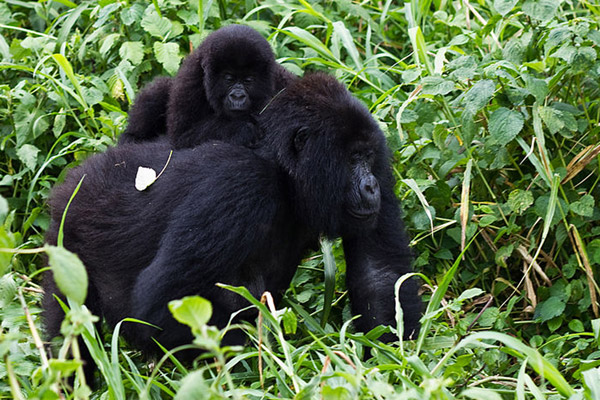 Mountain gorillas in Virunga National Park. Photo by: Cai Tjeenk Willink/Creative Commons 3.0. Last Friday, the government of the Democratic Republic of Congo (DRC) announced it was considering changing the boundaries of Virunga National Park to accommodate oil exploitation. Africa’s oldest park, Virunga is home to around a quarter of the world’s mountain gorillas (Gorilla […]
Mountain gorillas in Virunga National Park. Photo by: Cai Tjeenk Willink/Creative Commons 3.0. Last Friday, the government of the Democratic Republic of Congo (DRC) announced it was considering changing the boundaries of Virunga National Park to accommodate oil exploitation. Africa’s oldest park, Virunga is home to around a quarter of the world’s mountain gorillas (Gorilla […]
World’s rarest gorilla gets a new protected home
 Tofala Wildlife Sanctuary will help protect 20-30 Cross River gorillas – about 10 percent of the subspecies The Cross River Gorilla (Gorilla gorilla diehli), the rarest and most threatened of gorilla subspecies, has reason to cheer. Last month, on September 29, the Prime Minister of Cameroon, Philemon Yang, signed a decree to officially create a […]
Tofala Wildlife Sanctuary will help protect 20-30 Cross River gorillas – about 10 percent of the subspecies The Cross River Gorilla (Gorilla gorilla diehli), the rarest and most threatened of gorilla subspecies, has reason to cheer. Last month, on September 29, the Prime Minister of Cameroon, Philemon Yang, signed a decree to officially create a […]
Forest restoration commitments: driven by science or politics?
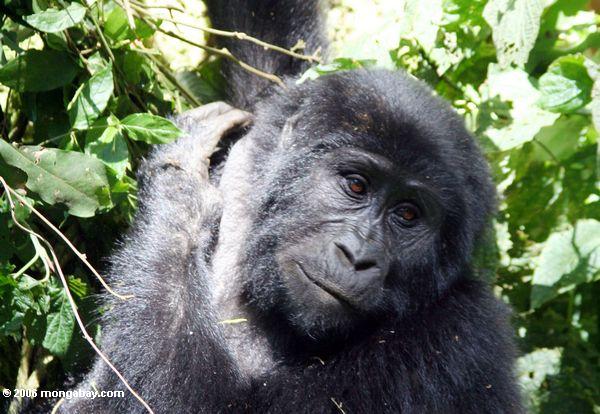 Uganda, Ethiopia, and the DRC made lofty forest restoration pledges Forest during the UN Climate Summit last month. Will they follow through? The United Nations Climate Summit at the end of September saw a host of governments, agencies and organizations rally around an international agreement aimed at stopping deforestation called the New York Declaration on […]
Uganda, Ethiopia, and the DRC made lofty forest restoration pledges Forest during the UN Climate Summit last month. Will they follow through? The United Nations Climate Summit at the end of September saw a host of governments, agencies and organizations rally around an international agreement aimed at stopping deforestation called the New York Declaration on […]
The Zanaga iron ore mine – a test of best laid plans for preserving wildlife
 Logging companies threaten to undermine the mining industry’s efforts to leave biodiversity better off One of the largest iron ore deposits in Africa is located in a strip 47 kilometers long and three kilometers wide in the Republic of the Congo (RoC), bordering Gabon. A core section of the Guineo-Congolian Forest rises above this vast […]
Logging companies threaten to undermine the mining industry’s efforts to leave biodiversity better off One of the largest iron ore deposits in Africa is located in a strip 47 kilometers long and three kilometers wide in the Republic of the Congo (RoC), bordering Gabon. A core section of the Guineo-Congolian Forest rises above this vast […]
Why are great apes treated like second-class species by CITES?
 CITES has responded to this commentary, refuting certain points: Information on CITES and great apes, including on the outcomes of Standing Committee 65, can be found on the CITES website. The author found baby chimpanzees offered for sale on Facebook as pets for children. The seller, a woman in Cameroon, promised to provide all necessary […]
CITES has responded to this commentary, refuting certain points: Information on CITES and great apes, including on the outcomes of Standing Committee 65, can be found on the CITES website. The author found baby chimpanzees offered for sale on Facebook as pets for children. The seller, a woman in Cameroon, promised to provide all necessary […]
How did Ebola Zaïre Get to Guinea?
 Is the great ape trade responsible for the current outbreak of Ebola? The vicious Ebola virus outbreak that has already killed more than 800 people this year, in addition to sowing panic, fear and confusion throughout West Africa, was not a strain endemic to the region as initially believed. Instead the University of Edinburgh found […]
Is the great ape trade responsible for the current outbreak of Ebola? The vicious Ebola virus outbreak that has already killed more than 800 people this year, in addition to sowing panic, fear and confusion throughout West Africa, was not a strain endemic to the region as initially believed. Instead the University of Edinburgh found […]
Ndoki Forest, charmed or cursed? Conservationists admit sustainable logging wilting in naïve chimp habitat
 “You come across that crest, and … you’re going from forest that has already been exploited to this kind of no-man’s land… It just felt like you were going into this vast unknown wilderness” – Mike Fay from Eating Apes by Dale Peterson and Karl Ammann. Mike Fay, famed explorer and conservationist, said this of […]
“You come across that crest, and … you’re going from forest that has already been exploited to this kind of no-man’s land… It just felt like you were going into this vast unknown wilderness” – Mike Fay from Eating Apes by Dale Peterson and Karl Ammann. Mike Fay, famed explorer and conservationist, said this of […]
Invasion of the oil palm: western Africa’s native son returns, threatening great apes
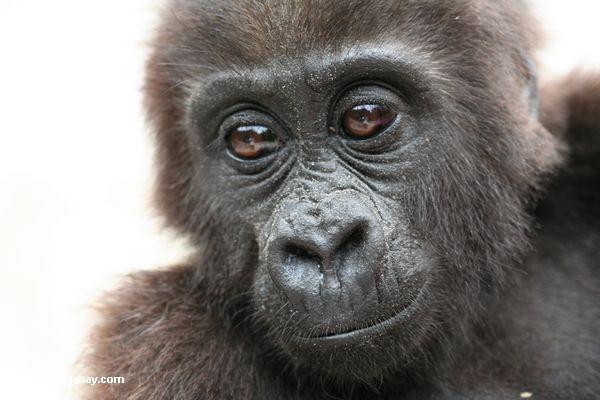 New research shows African apes likely to be affected by palm oil, but there’s hope, says the author As palm oil producers increasingly look to Africa’s tropical forests as suitable candidates for their next plantations, primate scientists are sounding the alarm about the destruction of ape habitat that can go hand in hand with oil […]
New research shows African apes likely to be affected by palm oil, but there’s hope, says the author As palm oil producers increasingly look to Africa’s tropical forests as suitable candidates for their next plantations, primate scientists are sounding the alarm about the destruction of ape habitat that can go hand in hand with oil […]
Surrounded by deforestation, critically endangered gorillas hang on by a thread
 Is there hope for Africa’s most threatened ape subspecies? The mountain forests at the Nigeria-Cameroon border are home to one of the rarest and most threatened subspecies of African apes – the Cross River gorilla (Gorilla gorilla diehli). Today, fewer than 300 individuals survive in the wild. These occur in 14 small, fragmented populations spread […]
Is there hope for Africa’s most threatened ape subspecies? The mountain forests at the Nigeria-Cameroon border are home to one of the rarest and most threatened subspecies of African apes – the Cross River gorilla (Gorilla gorilla diehli). Today, fewer than 300 individuals survive in the wild. These occur in 14 small, fragmented populations spread […]
Oil, wildlife, and people: competing visions of development collide in Virunga National Park
 What does SOCO’s withdrawal really mean for the future of Virunga National Park? – Part II. Read part I here. “SOCO is pleased that we were able to work together with WWF to hopefully find a way to jointly improve conditions in Virunga National Park and for its inhabitants,” said Roger Cagle, Deputy CEO of […]
What does SOCO’s withdrawal really mean for the future of Virunga National Park? – Part II. Read part I here. “SOCO is pleased that we were able to work together with WWF to hopefully find a way to jointly improve conditions in Virunga National Park and for its inhabitants,” said Roger Cagle, Deputy CEO of […]
What’s an environmental journalist to do with so much good news?
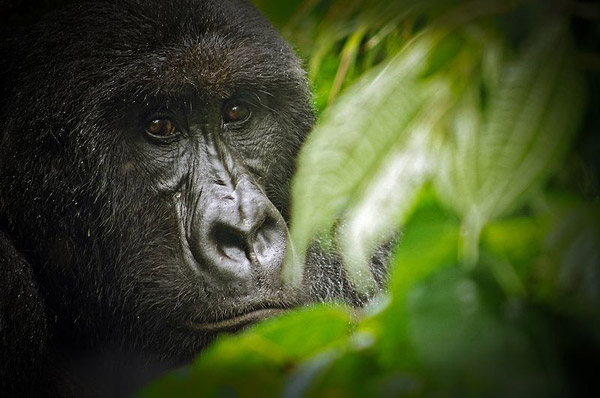 As an environmental journalist covering stories from the great Arctic ice melt to the rhino poaching crisis in Africa, you’ll forgive me if sometimes in the morning—before I turn my computer on—I have a sudden desire to spend a few extra minutes in bed or have a leisurely breakfast with my daughter or just sit […]
As an environmental journalist covering stories from the great Arctic ice melt to the rhino poaching crisis in Africa, you’ll forgive me if sometimes in the morning—before I turn my computer on—I have a sudden desire to spend a few extra minutes in bed or have a leisurely breakfast with my daughter or just sit […]
Oil overthrow: Soco to suspend operations in Virunga National Park after sustained campaign by WWF
 Mountain gorillas in Virunga National Park. Photo by: Cai Tjeenk Willink/Creative Commons 3.0. In a surprise announcement, British oil company Soco International has said it will suspend exploratory operations in Virunga National Park, home to half the world’s Critically Endangered mountain gorillas (Gorilla beringei beringei) as well as thousands of other species. The announcement follows […]
Mountain gorillas in Virunga National Park. Photo by: Cai Tjeenk Willink/Creative Commons 3.0. In a surprise announcement, British oil company Soco International has said it will suspend exploratory operations in Virunga National Park, home to half the world’s Critically Endangered mountain gorillas (Gorilla beringei beringei) as well as thousands of other species. The announcement follows […]
Big data shows tropical mammals on the decline
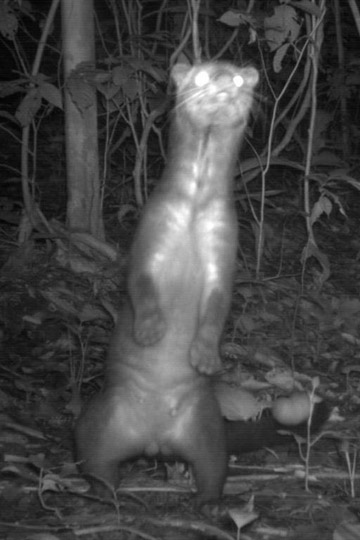 Harnessing big data for conservation. The world’s largest remote camera trap initiative—monitoring 275 species in 17 protected areas—is getting some big data assistance from Hewlett-Packard (HP). To date, the monitoring program known as the Tropical Ecology Assessment and Monitoring (TEAM) Network has taken over 1.5 million photos of animals in 14 tropical countries, but conservationists […]
Harnessing big data for conservation. The world’s largest remote camera trap initiative—monitoring 275 species in 17 protected areas—is getting some big data assistance from Hewlett-Packard (HP). To date, the monitoring program known as the Tropical Ecology Assessment and Monitoring (TEAM) Network has taken over 1.5 million photos of animals in 14 tropical countries, but conservationists […]
Orphaned gorillas successfully reintroduced where apes had been hunted to extinction
 The reintroduction of captive gorillas to areas where they have been hunted to extinction appears to working, suggesting a possible new front in efforts to save great apes, finds a new study published in the journal Oryx. The study, conducted by researchers at the Aspinall Foundation, looked at long-running reintroduction projects in Gabon and the […]
The reintroduction of captive gorillas to areas where they have been hunted to extinction appears to working, suggesting a possible new front in efforts to save great apes, finds a new study published in the journal Oryx. The study, conducted by researchers at the Aspinall Foundation, looked at long-running reintroduction projects in Gabon and the […]
Art, education, and health: holistic conservation group embarks on new chapter
- It’s unlikely conservation organizations can survive if they are unwilling to embrace change: as an endeavor, conservation requires not just longterm planning, but also an ability to move proactively and fluidly to protect species and safeguard ecosystems.
- Environmental and education NGO, the Art of Conservation, is currently embarking on its biggest change since its foundation in 2006: moving away from its base in Rwanda, while leaving a legacy behind.
Making movies to save Uganda’s great apes
 The 2013 Zoos and Aquariums: Committing to Conservation (ZACC) conference runs from July 8th—July 12th in Des Moines, Iowa, hosted by the Blank Park Zoo. Ahead of the event, Mongabay.com is running a series of Q&As with presenters. For more interviews, please see our ZACC feed. Ajani and his friends are caught trespassing in the […]
The 2013 Zoos and Aquariums: Committing to Conservation (ZACC) conference runs from July 8th—July 12th in Des Moines, Iowa, hosted by the Blank Park Zoo. Ahead of the event, Mongabay.com is running a series of Q&As with presenters. For more interviews, please see our ZACC feed. Ajani and his friends are caught trespassing in the […]
Why responsible tourism is the key to saving the mountain gorilla
 The sunlight poured through the canopy, casting dappled shade over Makara, a large silverback mountain gorilla, as he cast his eyes around the forest clearing, checking on the members of his harem. A female gorilla reclined on a bank of dense vegetation of the most brilliant green, clutching her three day old infant close to […]
The sunlight poured through the canopy, casting dappled shade over Makara, a large silverback mountain gorilla, as he cast his eyes around the forest clearing, checking on the members of his harem. A female gorilla reclined on a bank of dense vegetation of the most brilliant green, clutching her three day old infant close to […]
Featured video: If I were a panda…
A new powerful video by the conservation program, APES, highlights the threat faced by many species: not being cute enough. The creative short video was produced pro bono by Ogilvy & Mather Chicago. “The mission of APES is to raise awareness around all endangered animals, versus putting the emphasis on just one particular species,” said […]
Gorilla paradise: new park safeguards 15,000 western lowland gorillas
 The newly created Ntokou-Pikounda National Park spans some 4,572 square kilometers (1,765 square miles) and will safeguard western lowland gorillas as well as elephants and chimpanzees. Photo credit: Thomas Breuer/Wildlife Conservation Society-Max Planck Institute for Evolutionary Anthropology. In 2008 the Wildlife Conservation Society (WCS) announced a jaw-dropping discovery: remote swamp forests in northern Republic of […]
The newly created Ntokou-Pikounda National Park spans some 4,572 square kilometers (1,765 square miles) and will safeguard western lowland gorillas as well as elephants and chimpanzees. Photo credit: Thomas Breuer/Wildlife Conservation Society-Max Planck Institute for Evolutionary Anthropology. In 2008 the Wildlife Conservation Society (WCS) announced a jaw-dropping discovery: remote swamp forests in northern Republic of […]
Mountain gorilla population up by over 20 percent in five years
 Mountain gorilla family in Virunga National Park. Photo by: Martin Harvey/WWF. A mountain gorilla census in Uganda’s Bwindi Impenetrable National Park has a population that continues to rise, hitting 400 animals. The new census in Bwindi means the total population of mountain gorillas (Gorilla beringei beringei) has reached 880—up from 720 in 2007—and marking a […]
Mountain gorilla family in Virunga National Park. Photo by: Martin Harvey/WWF. A mountain gorilla census in Uganda’s Bwindi Impenetrable National Park has a population that continues to rise, hitting 400 animals. The new census in Bwindi means the total population of mountain gorillas (Gorilla beringei beringei) has reached 880—up from 720 in 2007—and marking a […]
NASA satellites catch vast deforestation inside Virunga National Park
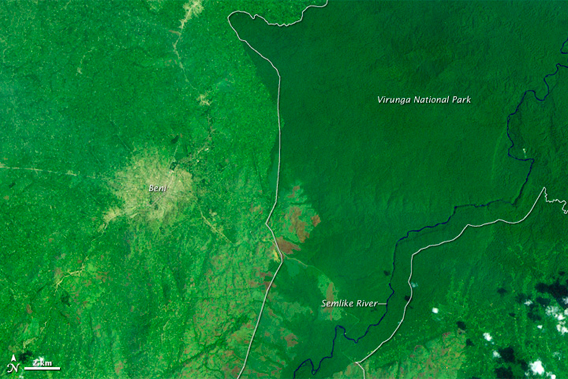 Two satellite images by NASA, one from February 13, 1999 and the other from September 1, 2008 (see below), show that Virunga National Park is under assault from deforestation. Located in the eastern edge of the Democratic Republic of Congo (DRC) the park has been assailed by entrenched conflict between rebels and government forces, as […]
Two satellite images by NASA, one from February 13, 1999 and the other from September 1, 2008 (see below), show that Virunga National Park is under assault from deforestation. Located in the eastern edge of the Democratic Republic of Congo (DRC) the park has been assailed by entrenched conflict between rebels and government forces, as […]
Cute animal picture of the day: new gorilla baby and mom
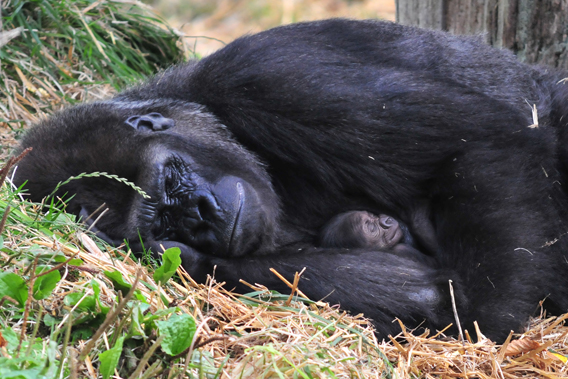 his the Durrell Wildlife Conservation Trust’s (DWCT) first gorilla baby in nine years. Keepers have yet to establish if its a male or female. Photo courtesy of DWCT. Click to enlarge. A baby western lowland gorilla (Gorilla gorilla gorilla) was born recently at the Durrell Wildlife Conservation Trust’s (DWCT) to mother, Hlala Kahilli and first-time […]
his the Durrell Wildlife Conservation Trust’s (DWCT) first gorilla baby in nine years. Keepers have yet to establish if its a male or female. Photo courtesy of DWCT. Click to enlarge. A baby western lowland gorilla (Gorilla gorilla gorilla) was born recently at the Durrell Wildlife Conservation Trust’s (DWCT) to mother, Hlala Kahilli and first-time […]
British government comes out against drilling in Virunga National Park by UK company
 NASA Landset image of Lake Edward in Virunga National Park. Photo by: NASA. The British government has come out in opposition against oil drilling plans by UK-based, SOCO International, in Virunga National Park, reports Reuters. The first national park established on the continent, Virunga is home to one of only two populations of mountain gorillas […]
NASA Landset image of Lake Edward in Virunga National Park. Photo by: NASA. The British government has come out in opposition against oil drilling plans by UK-based, SOCO International, in Virunga National Park, reports Reuters. The first national park established on the continent, Virunga is home to one of only two populations of mountain gorillas […]
Rarest gorillas lose half their habitat in 20 years
 Lowland gorilla in Gabon. Photo by Rhett A. Butler. Cross River gorillas and eastern gorillas lost more than half their habitat since the early 1990s due to deforestation, logging, and other human activities, finds a comprehensive new assessment across great apes’ range in West and Central Africa. The study, published in the journal Diversity and […]
Lowland gorilla in Gabon. Photo by Rhett A. Butler. Cross River gorillas and eastern gorillas lost more than half their habitat since the early 1990s due to deforestation, logging, and other human activities, finds a comprehensive new assessment across great apes’ range in West and Central Africa. The study, published in the journal Diversity and […]
Cute animal pictures of the day: gorilla toddler saved from illegal pet trade
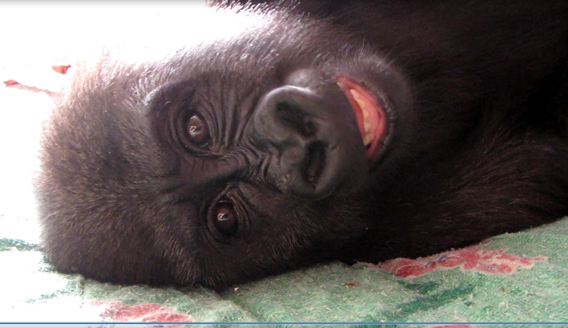 Named Afangui this gorilla toddler now resides in a gorilla sanctuary in Cameroon. Photo courtesy of the Zoological Society of London (ZSL). A two-year-old western lowland gorilla female was recently confiscated from a beach restaurant, popular with expats, in Equatorial Guinea. “The oil boom in Equatorial Guinea has resulted in an influx of expatriate workers […]
Named Afangui this gorilla toddler now resides in a gorilla sanctuary in Cameroon. Photo courtesy of the Zoological Society of London (ZSL). A two-year-old western lowland gorilla female was recently confiscated from a beach restaurant, popular with expats, in Equatorial Guinea. “The oil boom in Equatorial Guinea has resulted in an influx of expatriate workers […]
Turning gorilla poachers into conservationists in the Congo [warning: graphic photos]
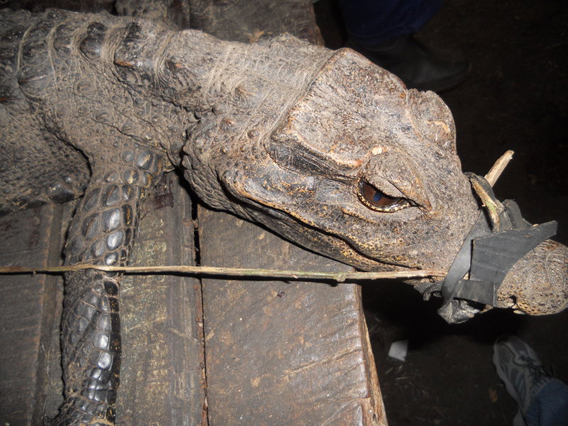 African slender-snouted crocodile caught by hunters. Photo courtesy of ESI. Although founded only four years ago, Endangered Species International-Congo, has ambitious plans to protect dwindling Western gorilla populations and aid local people in the Republic of the Congo (Brazzaville). The organization, an offshoot of Endangered Species International (ESI), has been spending the last few years […]
African slender-snouted crocodile caught by hunters. Photo courtesy of ESI. Although founded only four years ago, Endangered Species International-Congo, has ambitious plans to protect dwindling Western gorilla populations and aid local people in the Republic of the Congo (Brazzaville). The organization, an offshoot of Endangered Species International (ESI), has been spending the last few years […]
First camera trap video of world’s rarest gorilla includes shocking charge
.568.jpg) Captive Cross River gorilla at Limbe Wildlife Center, Limbe, Cameroon. Photo by: Julie Langford. Ever wonder what it would be like to be charged by a male gorilla? A new video (below) released by the Wildlife Conservation Society (WCS), gives one a first hand look. Shot in Cameroon’s Kagwene Gorilla Sanctuary, the video is the […]
Captive Cross River gorilla at Limbe Wildlife Center, Limbe, Cameroon. Photo by: Julie Langford. Ever wonder what it would be like to be charged by a male gorilla? A new video (below) released by the Wildlife Conservation Society (WCS), gives one a first hand look. Shot in Cameroon’s Kagwene Gorilla Sanctuary, the video is the […]
Bigger is better for gorillas
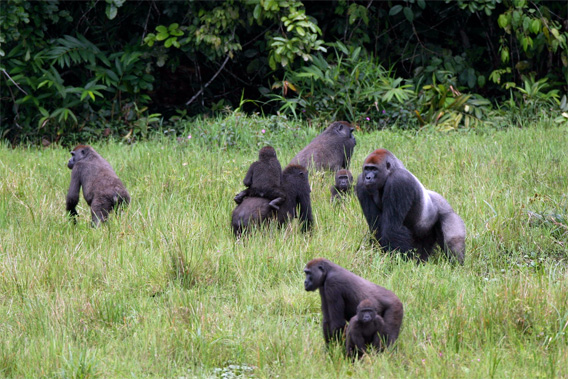 An adult male gorilla—also known as a “silverback” (far right)—with a family group in Nouabalé-Ndoki National Park in the Republic of Congo. Conservationists from WCS and the Max Planck Institute for Evolutionary Anthropology recently discovered that larger male gorillas are more successful than smaller ones at attracting mates and raising young. Photo credit: Thomas Breuer/WCS. […]
An adult male gorilla—also known as a “silverback” (far right)—with a family group in Nouabalé-Ndoki National Park in the Republic of Congo. Conservationists from WCS and the Max Planck Institute for Evolutionary Anthropology recently discovered that larger male gorillas are more successful than smaller ones at attracting mates and raising young. Photo credit: Thomas Breuer/WCS. […]
Oil exploration approved in Africa’s oldest park, Virunga National Park
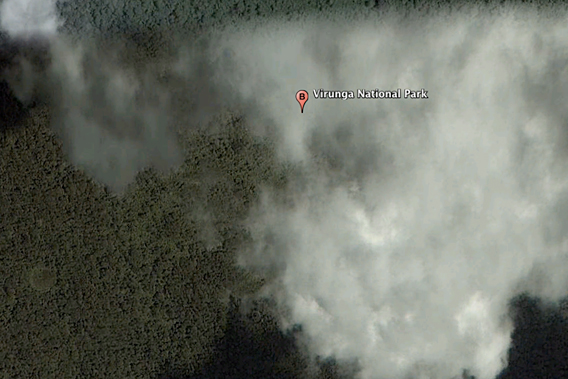 A portion of Virunga National Park swaddled in clouds as seen by Google Earth. Permits for controversial oil exploration in Virunga National Park have been released after request by NGO Global Witness. Oil company, SOCO International, has confirmed it has received two permits to undertake preliminary exploration, including seismic tests, in the UNESCO World Heritage […]
A portion of Virunga National Park swaddled in clouds as seen by Google Earth. Permits for controversial oil exploration in Virunga National Park have been released after request by NGO Global Witness. Oil company, SOCO International, has confirmed it has received two permits to undertake preliminary exploration, including seismic tests, in the UNESCO World Heritage […]
Without data, fate of great apes unknown
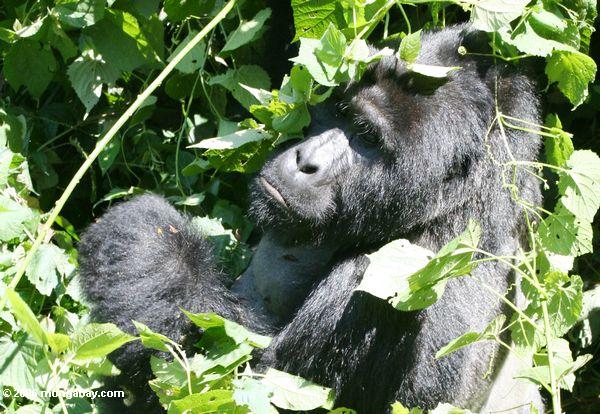 Improving the evidence base for African great ape conservation: An interview with Sandra Tranquilli. Silverback gorilla in Bwindi Impenetrable National Park, Uganda. Photo by: Rhett A. Butler. Our closest nonhuman relatives, the great apes, are in mortal danger. Every one of the six great ape species is endangered, and without more effective conservation measures, they […]
Improving the evidence base for African great ape conservation: An interview with Sandra Tranquilli. Silverback gorilla in Bwindi Impenetrable National Park, Uganda. Photo by: Rhett A. Butler. Our closest nonhuman relatives, the great apes, are in mortal danger. Every one of the six great ape species is endangered, and without more effective conservation measures, they […]
Republic of the Congo expands park to protect fearless chimps
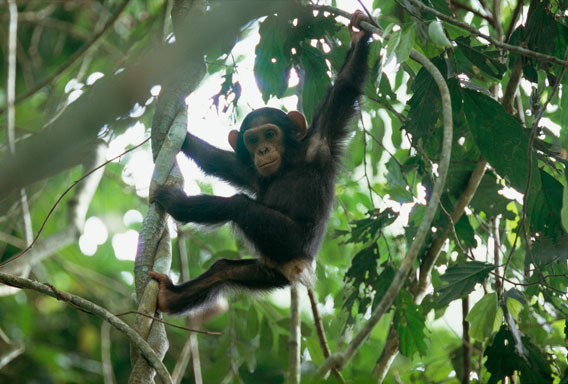 A young “naive” chimp from the Goualougo Triangle. Photo by: Michael Nichols, National Geographic. The Republic of the Congo has expanded its Nouabalé-Ndoki National Park by 37,295 hectares (144 square miles) to include a dense swamp forest, home to a population of chimpanzees (Pan troglodytes) that show no fear of humans. Known as the Goualougo […]
A young “naive” chimp from the Goualougo Triangle. Photo by: Michael Nichols, National Geographic. The Republic of the Congo has expanded its Nouabalé-Ndoki National Park by 37,295 hectares (144 square miles) to include a dense swamp forest, home to a population of chimpanzees (Pan troglodytes) that show no fear of humans. Known as the Goualougo […]
Price of gorilla permit increases to $750/day
 Mountain gorillas in Uganda’s Bwindi Impenetrable National Park. The price of a daily gorilla permit has more than doubled since this photo was taken in 2006. Rwanda has raised the price of a permit to see mountain gorillas to $750 per day starting June 1, 2012, up from $500. While the price is steep, the […]
Mountain gorillas in Uganda’s Bwindi Impenetrable National Park. The price of a daily gorilla permit has more than doubled since this photo was taken in 2006. Rwanda has raised the price of a permit to see mountain gorillas to $750 per day starting June 1, 2012, up from $500. While the price is steep, the […]
Gorilla poachers brutally murder forest ranger
 Female western lowland gorilla with infant in captivity. Photo by: Rhett A. Butler. Forest ranger, Zomedel Pierre Achille, was brutally murdered by gorilla poachers near Lobéké National Park in Cameroon, according to the World Wide Fund for Nature (WWF). Achille and another ranger, Jean Fils Mamendji, attempted to take poachers into custody after discovering the […]
Female western lowland gorilla with infant in captivity. Photo by: Rhett A. Butler. Forest ranger, Zomedel Pierre Achille, was brutally murdered by gorilla poachers near Lobéké National Park in Cameroon, according to the World Wide Fund for Nature (WWF). Achille and another ranger, Jean Fils Mamendji, attempted to take poachers into custody after discovering the […]
Photo: Population of world’s biggest gorilla increases in Congo
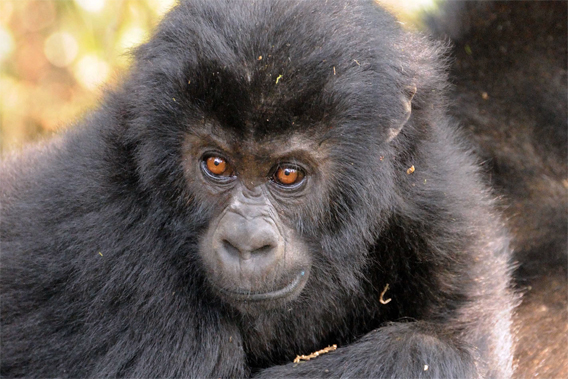 Grauer’s gorilla is the world’s largest gorilla. Photo copyright A. Plumptre/Wildlife Conservation Society. A population of the world’s largest gorilla subspecies has increased despite ongoing human conflict, reports the Wildlife Conservation Society (WCS). A survey of Kahuzi-Biega National Park in the Democratic Republic of Congo turned up 181 Grauer’s gorillas, up from 168 in 2004 […]
Grauer’s gorilla is the world’s largest gorilla. Photo copyright A. Plumptre/Wildlife Conservation Society. A population of the world’s largest gorilla subspecies has increased despite ongoing human conflict, reports the Wildlife Conservation Society (WCS). A survey of Kahuzi-Biega National Park in the Democratic Republic of Congo turned up 181 Grauer’s gorillas, up from 168 in 2004 […]
Oil company charged after allegedly forcing entry into Virunga National Park
The Democratic Republic of Congo’s (DRC) national parks authority, ICCN, has filed a suit against oil company, SOCO International, for allegedly forcing entry into Virunga National Park. The legal row comes amid revelations that two oil companies, SOCO and Dominion Petroleum, are exploring the park for oil. According to park director Emmanuel de Merode rangers […]
After another ranger killed, Virunga National Park requests UN peacekeepers
Less than a week after 3 wildlife rangers and 5 soldiers were killed in Virunga National Park by the rebel group Democratic Forces for the Liberation of Rwanda (FDLR), another ranger has been killed and a driver put in the hospital in critical condition. The situation has pushed park authorities to request UN peacekeepers for […]
Eight rangers, soldiers killed in Virunga National Park
Yesterday morning, 3 wildlife rangers and 5 soldiers working in Virunga National Park were killed by the rebel group Democratic Forces for the Liberation of Rwanda (FDLR). These 8 were killed and 3 more wounded when their vehicle was fired on by FDLR rebels with rocket launchers. Park director Emmanuel de Merode told the AFP […]
UN and conservation organizations condemn big oil’s plan to drill in Virunga National Park
WWF, the International Union for the Conservation of Nature (IUCN), and the UN have all recently expressed concerns about two oil companies’ plan to explore for oil in Africa’s oldest and famed Virunga National Park. Home to a quarter of the world’s mountain gorillas, as well as chimpanzees, hippos, lions, forest elephants, and rare birds […]
Primatologists: the best hope for apes is the best hope for us
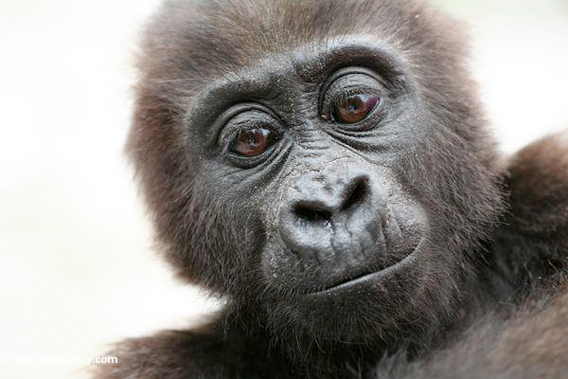 Lowland gorilla in Gabon. Photo by Rhett A. Butler. Distinguished conservation luminaries, eminent primate experts, ape-suited bucket wielders, a group of African drummers and nearly 1,500 people gathered in London last week for an evening of talks to shine the spotlight on the plight of apes and the forests in which they live, sending a […]
Lowland gorilla in Gabon. Photo by Rhett A. Butler. Distinguished conservation luminaries, eminent primate experts, ape-suited bucket wielders, a group of African drummers and nearly 1,500 people gathered in London last week for an evening of talks to shine the spotlight on the plight of apes and the forests in which they live, sending a […]
Mountain gorilla population up by 100 individuals
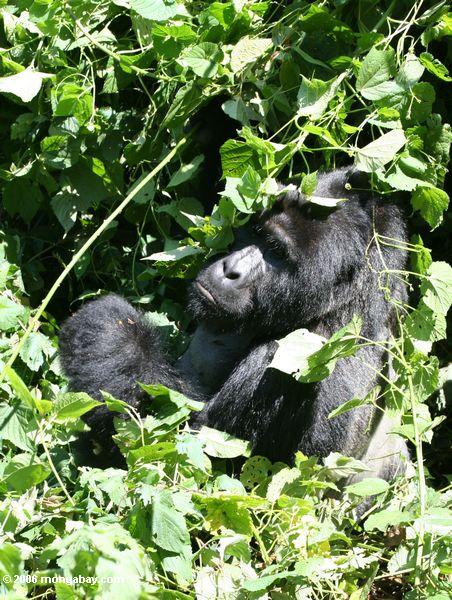 Conservation appears to be working for the Critically Endangered mountain gorilla (Gorilla beringei beringei) in the Virunga massif region, as a new census shows an additional 100 individuals from the last census in 2003, an increase of over a quarter. The Virunga massif is a region in three nations—Rwanda, the Democratic Republic of Congo, and […]
Conservation appears to be working for the Critically Endangered mountain gorilla (Gorilla beringei beringei) in the Virunga massif region, as a new census shows an additional 100 individuals from the last census in 2003, an increase of over a quarter. The Virunga massif is a region in three nations—Rwanda, the Democratic Republic of Congo, and […]
African apes threatened by rising temperatures
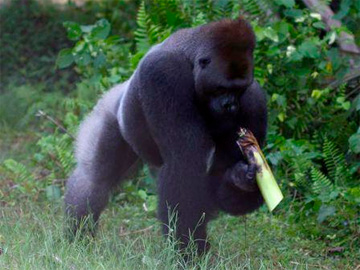 Most people wish each day had more than 24 hours. But as the planet heats up, that limited number of hours might push endangered African apes even closer to extinction by making their current habitats unsuitable for their lifestyle, according to a controversial study published on 23 July in the Journal of Biogeography. Researchers from […]
Most people wish each day had more than 24 hours. But as the planet heats up, that limited number of hours might push endangered African apes even closer to extinction by making their current habitats unsuitable for their lifestyle, according to a controversial study published on 23 July in the Journal of Biogeography. Researchers from […]
Environmentalists must recognize ‘biases and delusions’ to succeed
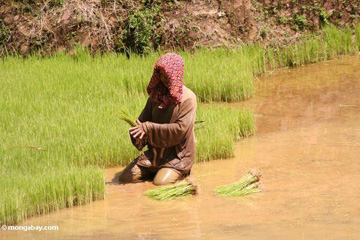 As nations from around the world meet at the Convention on Biological Diversity in Nagoya, Japan to discuss ways to stem the loss of biodiversity worldwide, two prominent researchers argue that environmentalists and conservationists need to consider paradigm shifts if biodiversity is to be preserved, especially in developing countries. Writing in the journal Biotropica, Douglas […]
As nations from around the world meet at the Convention on Biological Diversity in Nagoya, Japan to discuss ways to stem the loss of biodiversity worldwide, two prominent researchers argue that environmentalists and conservationists need to consider paradigm shifts if biodiversity is to be preserved, especially in developing countries. Writing in the journal Biotropica, Douglas […]
Financial crisis pummels wildlife and people in the Congo rainforest
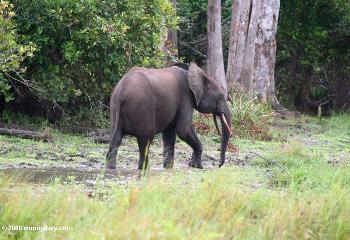 Spreading over three central African nations—Cameroon, Central African Republic, and Republic of Congo—the Sangha tri-national landscape is home to a variety of actors: over 150,000 Bantu people and nearly 20,000 pygmies; endangered species including forest elephants and gorillas; and, not least, the Congo rainforest ecosystem itself, which here remains largely intact. Given its interplay of […]
Spreading over three central African nations—Cameroon, Central African Republic, and Republic of Congo—the Sangha tri-national landscape is home to a variety of actors: over 150,000 Bantu people and nearly 20,000 pygmies; endangered species including forest elephants and gorillas; and, not least, the Congo rainforest ecosystem itself, which here remains largely intact. Given its interplay of […]
Protected areas vital for saving elephants, chimps, and gorillas in the Congo
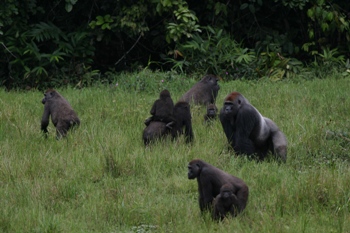 In a landscape-wide study in the Congo, the Wildlife Conservation Society (WCS) found that core protected areas and strong anti-poaching efforts are necessary to maintain viable populations of forest elephants, western lowland gorillas, and chimpanzees—all of which are threatened with extinction. Evaluating various land-uses in the Republic of Congo’s Ndoki-Likouala Conservation Landscape—including a national park, […]
In a landscape-wide study in the Congo, the Wildlife Conservation Society (WCS) found that core protected areas and strong anti-poaching efforts are necessary to maintain viable populations of forest elephants, western lowland gorillas, and chimpanzees—all of which are threatened with extinction. Evaluating various land-uses in the Republic of Congo’s Ndoki-Likouala Conservation Landscape—including a national park, […]
Farming snails to save the world’s rarest gorillas
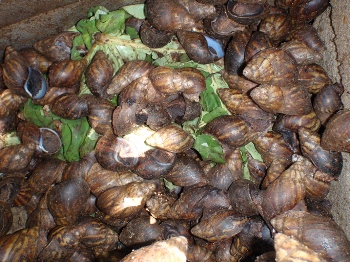 In a place of poverty and hunger, how do you save a species on the edge of extinction? A difficult question that conservationists have long-been working to tackle, the Wildlife Conservation Society (WCS) has come up with a new plan to protect the world’s most endangered gorilla, the Cross River gorilla, from poachers by providing […]
In a place of poverty and hunger, how do you save a species on the edge of extinction? A difficult question that conservationists have long-been working to tackle, the Wildlife Conservation Society (WCS) has come up with a new plan to protect the world’s most endangered gorilla, the Cross River gorilla, from poachers by providing […]
Guerrillas could drive gorillas toward extinction in Congo, warns UN
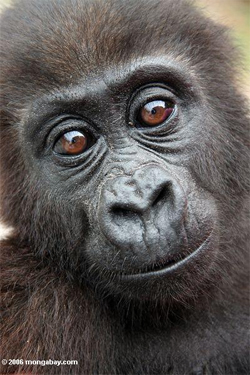 Gorillas may disappear across much of the Congo Basin by the mid 2020s unless action is taken to protect against poaching and habitat destruction, warns a new report issued by United Nations and INTERPOL. The Last Stand of the Gorilla – Environmental Crime and Conflict in the Congo Basin — released at the CITES meeting […]
Gorillas may disappear across much of the Congo Basin by the mid 2020s unless action is taken to protect against poaching and habitat destruction, warns a new report issued by United Nations and INTERPOL. The Last Stand of the Gorilla – Environmental Crime and Conflict in the Congo Basin — released at the CITES meeting […]
Humans push half of the world’s primates toward extinction, lemurs in particular trouble
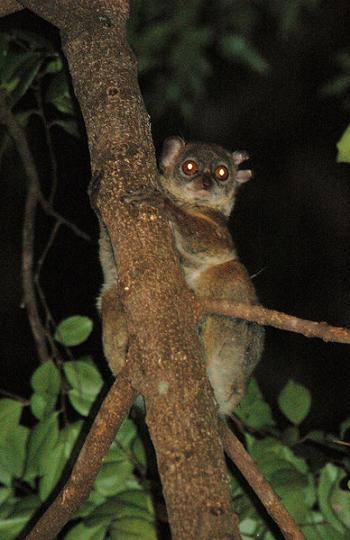 Experts release list of the world’s top 25 most endangered primates. Of the known 634 primate species in the world 48 percent are currently threatened with extinction, making mankind’s closes relatives one of the most endangered animal groups in the world. In order to bring awareness to the desperate state of primates, a new report […]
Experts release list of the world’s top 25 most endangered primates. Of the known 634 primate species in the world 48 percent are currently threatened with extinction, making mankind’s closes relatives one of the most endangered animal groups in the world. In order to bring awareness to the desperate state of primates, a new report […]
World’s rarest gorilla caught on film
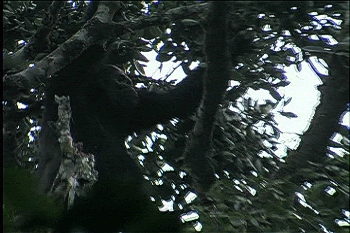 The first ever professional footage of the world’s rarest gorilla, the Cross River gorilla ( Gorilla gorilla diehli), has been shot deep in the forested mountains of Cameroon. The only other existing footage of this Critically Endangered subspecies was taken from far away by a field researcher in 2005. After weeks of effort, the Hamburg-based […]
The first ever professional footage of the world’s rarest gorilla, the Cross River gorilla ( Gorilla gorilla diehli), has been shot deep in the forested mountains of Cameroon. The only other existing footage of this Critically Endangered subspecies was taken from far away by a field researcher in 2005. After weeks of effort, the Hamburg-based […]
African children on ‘gorilla warfare’ mission in run-up to COP15
 Seven poor African children fly to Paris on dream-of-a-lifetime trip to be crowned ‘Young Ambassadors of the Great Apes’ “It’s the gorillas I’ve got to thank for bringing me here,” said Sephora Binet-Mboti, (13), as she gazed up, wide-eyed, at the Eiffel Tower in Paris. She was a long way from her in home in […]
Seven poor African children fly to Paris on dream-of-a-lifetime trip to be crowned ‘Young Ambassadors of the Great Apes’ “It’s the gorillas I’ve got to thank for bringing me here,” said Sephora Binet-Mboti, (13), as she gazed up, wide-eyed, at the Eiffel Tower in Paris. She was a long way from her in home in […]
Disney commits $4 million to rainforest conservation in the Amazon, Congo
The Walt Disney Company will invest $7 million in forest conservation projects in the U.S., the Congo Basin, and the Amazon in an effort to reduce its greenhouse gas emissions. Disney’s investment is being made in partnership with three conservation groups: Conservation International, The Nature Conservancy and The Conservation Fund. Working with Conservation International, Disney […]
‘Greening’ logging concessions could help save great apes
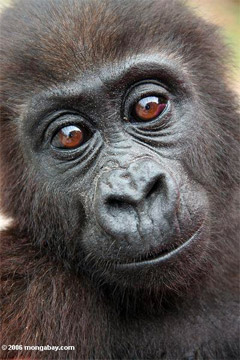 Promoting reduced impact logging in forest areas already under concession could help protect populations of endangered great apes, argues a new report published by WWF. Analyzing scientific studies on the consequences of different types of logging on great apes, Arnold van Kreveld and Ingrid Roerhorst found that logging concessions certified by the Forest Stewardship Council […]
Promoting reduced impact logging in forest areas already under concession could help protect populations of endangered great apes, argues a new report published by WWF. Analyzing scientific studies on the consequences of different types of logging on great apes, Arnold van Kreveld and Ingrid Roerhorst found that logging concessions certified by the Forest Stewardship Council […]
Saving gorillas by bringing healthcare to local people in Uganda, an interview with Dr. Gladys Kalema-Zikusoka
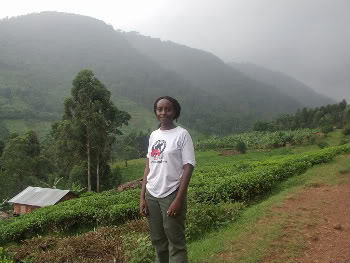 How can bringing healthcare to local villagers in Uganda help save the Critically Endangered mountain gorilla? The answer lies in our genetics, says Dr. Gladys Kalema-Zikusoka, wildlife veterinarian and director of Conservation through Public Health (CTPH). “Because we share 98.4% genetic material with gorillas we can easily transmit diseases to each other.” Therefore, explains Kalema-Zikusoka […]
How can bringing healthcare to local villagers in Uganda help save the Critically Endangered mountain gorilla? The answer lies in our genetics, says Dr. Gladys Kalema-Zikusoka, wildlife veterinarian and director of Conservation through Public Health (CTPH). “Because we share 98.4% genetic material with gorillas we can easily transmit diseases to each other.” Therefore, explains Kalema-Zikusoka […]
Examining monkey tools: archaeology expands to include non-human primates
 Primate archaeology: old science gets new members Archaeology, the study of ancient cultures and their artifacts, has always been confined to the technology of humans and direct human ancestors. However, a new study recently published in the journal Nature examines the benefits of expanding the field of archaeology to include non-human primates. Until a half-century […]
Primate archaeology: old science gets new members Archaeology, the study of ancient cultures and their artifacts, has always been confined to the technology of humans and direct human ancestors. However, a new study recently published in the journal Nature examines the benefits of expanding the field of archaeology to include non-human primates. Until a half-century […]
Gorillas orphaned by bushmeat trade set free on island
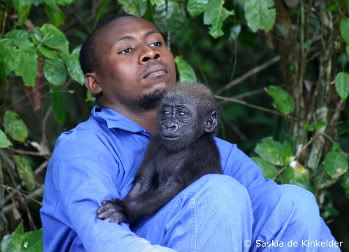 The Africa’s Eden. Video showing release of gorillas on the island. Related articles More than 300 gorillas butchered each year in the Republic of Congo (03/27/2009) During 2008 and early 2009, Endangered Species International (ESI) conducted monitoring activities using undercover methods at key markets in the city of Pointe Noire, the second biggest city in […]
The Africa’s Eden. Video showing release of gorillas on the island. Related articles More than 300 gorillas butchered each year in the Republic of Congo (03/27/2009) During 2008 and early 2009, Endangered Species International (ESI) conducted monitoring activities using undercover methods at key markets in the city of Pointe Noire, the second biggest city in […]
Cameroon rainforest given 30 days to be conserved or sold off for logging
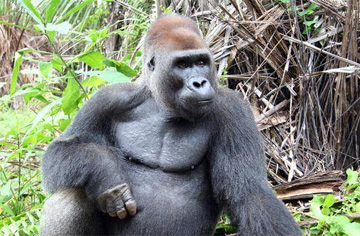 An 830,000-hectare tract of rainforest in Cameroon has been granted a 30-day reprieve from logging following a 4-week exploratory expedition that turned up large populations of lowland gorillas, forest elephants, mandrills, and chimpanzees, according to expedition leader Mike Korchinsky, founder of the conservation group Wildlife Works. The Cameroonian government has given Wildlife Works, which pioneered […]
An 830,000-hectare tract of rainforest in Cameroon has been granted a 30-day reprieve from logging following a 4-week exploratory expedition that turned up large populations of lowland gorillas, forest elephants, mandrills, and chimpanzees, according to expedition leader Mike Korchinsky, founder of the conservation group Wildlife Works. The Cameroonian government has given Wildlife Works, which pioneered […]
Range extended for world’s most mysterious gorilla
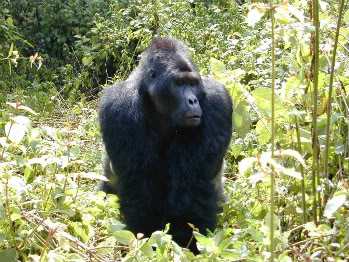 The Wildlife Conservation Society (WCS) announced yesterday the discovery of eastern lowland gorilla nests in an unexplored area of the Democratic Republic of Congo (DRC), expanding the range of this little-known subspecies by 30 miles (50 kilometers). The eastern lowland gorilla, also known as Grauer’s gorilla, is currently listed as Endangered in the IUCN Red […]
The Wildlife Conservation Society (WCS) announced yesterday the discovery of eastern lowland gorilla nests in an unexplored area of the Democratic Republic of Congo (DRC), expanding the range of this little-known subspecies by 30 miles (50 kilometers). The eastern lowland gorilla, also known as Grauer’s gorilla, is currently listed as Endangered in the IUCN Red […]
More than 300 gorillas butchered each year in the Republic of Congo
 During 2008 and early 2009, Endangered Species International (ESI) conducted monitoring activities using undercover methods at key markets in the city of Pointe Noire, the second biggest city in Congo. Findings reveal that 95 percent of the illegal bushmeat sold originates from the Kouilou region about 100-150 km northwest to Pointe Noire where primary and […]
During 2008 and early 2009, Endangered Species International (ESI) conducted monitoring activities using undercover methods at key markets in the city of Pointe Noire, the second biggest city in Congo. Findings reveal that 95 percent of the illegal bushmeat sold originates from the Kouilou region about 100-150 km northwest to Pointe Noire where primary and […]
After seizure, gorilla receives MRI scan free of charge
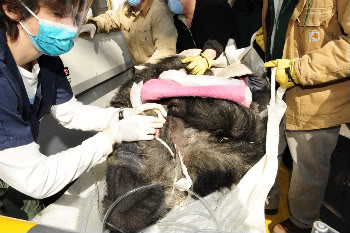 The Wildlife Conservation Society announced today that a 42-year-old western lowland gorilla named Fubo received a free MRI scan after suffering a seizure at his home in the Bronx Zoo’s Congo Gorilla Forest exhibit. The MRI was provided by The Brain Tumor Foundation, which sent a 48-foot-long moveable MRI facility to the zoo. Overseen by […]
The Wildlife Conservation Society announced today that a 42-year-old western lowland gorilla named Fubo received a free MRI scan after suffering a seizure at his home in the Bronx Zoo’s Congo Gorilla Forest exhibit. The MRI was provided by The Brain Tumor Foundation, which sent a 48-foot-long moveable MRI facility to the zoo. Overseen by […]
Cameroon may liquidate rainforest reserve if conservationists don’t step forward
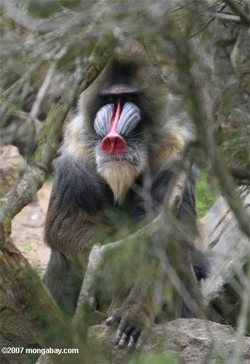
Cameroon gets gorilla park
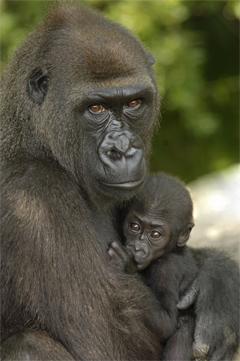
Mountain gorilla population in DR Congo increases 12.5%
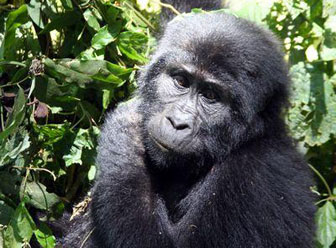
Gorilla ranger killed in Congo
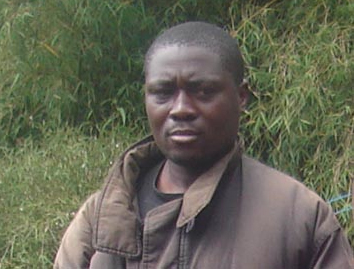
Rangers return to Virunga and begin gorilla census
 Rangers return to Virunga and begin gorilla census Rangers return to Virunga and begin gorilla census mongabay.com December 1, 2008
Rangers return to Virunga and begin gorilla census Rangers return to Virunga and begin gorilla census mongabay.com December 1, 2008
Cameroon moves to protect rarest gorilla
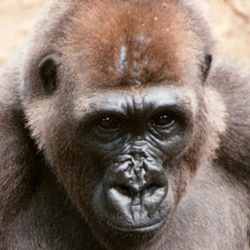 Cameroon moves to protect rarest gorilla Cameroon moves to protect rarest gorilla mongabay.com November 26, 2008
Cameroon moves to protect rarest gorilla Cameroon moves to protect rarest gorilla mongabay.com November 26, 2008
Missing gorilla rangers return safely in Congo, one dies of cholera in camp
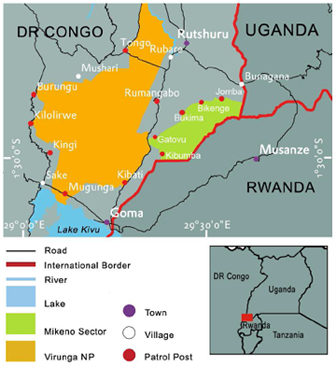 Update: Missing gorilla rangers return safely in Congo, one dies of cholera in camp Update: Missing gorilla rangers return safely in Congo, one dies of cholera in camp Jeremy Hance, mongabay.com November 6, 2008
Update: Missing gorilla rangers return safely in Congo, one dies of cholera in camp Update: Missing gorilla rangers return safely in Congo, one dies of cholera in camp Jeremy Hance, mongabay.com November 6, 2008
39 rangers missing in Virunga Park after headquarters overtaken by rebels
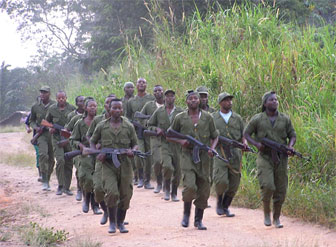 39 rangers missing in Virunga Park after headquarters overtaken by rebels 39 rangers missing in Virunga Park after headquarters overtaken by rebels Jeremy Hance, mongabay.com October 30, 2008
39 rangers missing in Virunga Park after headquarters overtaken by rebels 39 rangers missing in Virunga Park after headquarters overtaken by rebels Jeremy Hance, mongabay.com October 30, 2008
Gorilla refuge falls into rebel hands in Congo; Park HQ seized
 Gorilla refuge falls into rebel hands in Congo; Park HQ seized Gorilla refuge falls into rebel hands in Congo; Park HQ seized mongabay.com October 26, 2008 Rebels in Democratic Republic of Congo seized the headquarters of Virunga National Park — a refuge home to 200 of the world’s 700 remaining endangered mountain gorillas — according […]
Gorilla refuge falls into rebel hands in Congo; Park HQ seized Gorilla refuge falls into rebel hands in Congo; Park HQ seized mongabay.com October 26, 2008 Rebels in Democratic Republic of Congo seized the headquarters of Virunga National Park — a refuge home to 200 of the world’s 700 remaining endangered mountain gorillas — according […]
New rainforest sanctuary in Cameroon already at risk from plantations, hunting
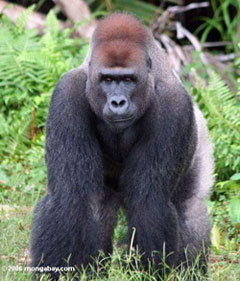 New rainforest sanctuary in Cameroon already at risk from plantations, hunting New rainforest sanctuary in Cameroon already at risk from plantations, hunting mongabay.com September 15, 2008 The forests of southern Cameroon bordering Gabon are biodiversity-rich and harbor important populations of gorillas, chimpanzees, and elephants. In 1998 the government of Cameroon established the Mengamé Gorilla Sanctuary […]
New rainforest sanctuary in Cameroon already at risk from plantations, hunting New rainforest sanctuary in Cameroon already at risk from plantations, hunting mongabay.com September 15, 2008 The forests of southern Cameroon bordering Gabon are biodiversity-rich and harbor important populations of gorillas, chimpanzees, and elephants. In 1998 the government of Cameroon established the Mengamé Gorilla Sanctuary […]
Cameroon and Nigeria to protect world’s rarest gorilla
 Cameroon and Nigeria to protect world’s rarest gorilla Cameroon and Nigeria to protect world’s rarest gorilla mongabay.com September 5, 2008 Cameroon and Nigeria have agreed to protect the the Cross River gorilla, world’s most endangered gorilla, reports the Wildlife Conservation Society, which helped broker the deal. The two West African nations will cooperate to protect […]
Cameroon and Nigeria to protect world’s rarest gorilla Cameroon and Nigeria to protect world’s rarest gorilla mongabay.com September 5, 2008 Cameroon and Nigeria have agreed to protect the the Cross River gorilla, world’s most endangered gorilla, reports the Wildlife Conservation Society, which helped broker the deal. The two West African nations will cooperate to protect […]
Reduced impact logging can save 160 m tons of carbon emissions per year
Reduced impact logging can save 160 m tons of carbon emissions per year Reduced impact logging can save 160 m tons of carbon emissions per year mongabay.com August 6, 2008 Improving inefficient logging practices could significantly reduce greenhouse gas emissions from forest degradation, argues a new study published in the open-access journal PLoS. Francis E. […]
48% of primates threatened with extinction
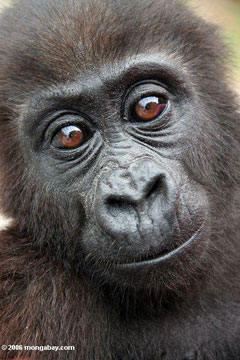 48% of primates threatened with extinction 48% of primates threatened with extinction mongabay.com August 5, 2008 48 percent of the world’s primate species are at risk of extinction, according to the first comprehensive review of the world’s primates since 2003. The results were released as an update to the IUCN Red List at the 22nd […]
48% of primates threatened with extinction 48% of primates threatened with extinction mongabay.com August 5, 2008 48 percent of the world’s primate species are at risk of extinction, according to the first comprehensive review of the world’s primates since 2003. The results were released as an update to the IUCN Red List at the 22nd […]
Massive gorilla population discovered in the Congo
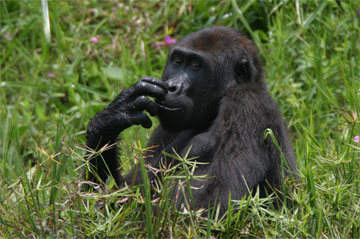 Photos of massive gorilla population discovered in the Congo Massive gorilla population discovered in the Congo mongabay.com August 5, 2008 The world’s known population of critically endangered western lowland gorillas has more than doubled following a new census that revealed some 125,000 in the Republic of Congo. The survey, conducted across conducted in an area […]
Photos of massive gorilla population discovered in the Congo Massive gorilla population discovered in the Congo mongabay.com August 5, 2008 The world’s known population of critically endangered western lowland gorillas has more than doubled following a new census that revealed some 125,000 in the Republic of Congo. The survey, conducted across conducted in an area […]
Planet of the Apes Has Arrived, and It Is Spain
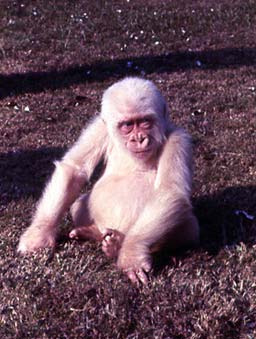 Planet of the Apes Has Arrived, and It Is Spain Planet of the Apes Has Arrived, and It Is Spain An editorial Nikolas Kozloff, special to mongabay.com July 3, 2008 Visiting Spain’s Barcelona zoo as a child, I was greeted to a memorable sight. In one of the cages sat a gorilla, but not just […]
Planet of the Apes Has Arrived, and It Is Spain Planet of the Apes Has Arrived, and It Is Spain An editorial Nikolas Kozloff, special to mongabay.com July 3, 2008 Visiting Spain’s Barcelona zoo as a child, I was greeted to a memorable sight. In one of the cages sat a gorilla, but not just […]
Does logging contribute to AIDS deaths in Africa?
 Does logging contribute to AIDS deaths in Africa? Does logging contribute to AIDS deaths in Africa? Rhett Butler, mongabay.com June 14, 2008 Human-widlife interactions are an important vector for emerging diseases, especially in the tropics Logging activities in tropical Africa may pose hidden health risks to wildlife and humans according to a veterinary pathobiologist speaking […]
Does logging contribute to AIDS deaths in Africa? Does logging contribute to AIDS deaths in Africa? Rhett Butler, mongabay.com June 14, 2008 Human-widlife interactions are an important vector for emerging diseases, especially in the tropics Logging activities in tropical Africa may pose hidden health risks to wildlife and humans according to a veterinary pathobiologist speaking […]
World’s rarest gorilla gets its own forest reserve
 World’s rarest gorilla gets its own forest reserve World’s rarest gorilla gets its own forest reserve mongabay.com April 18, 2008 The government of Cameroon has established the first sanctuary exclusively for the world’s rarest type of ape: the Cross River gorilla, according to the Wildlife Conservation Society (WCS), which helped support the project. The Kagwene […]
World’s rarest gorilla gets its own forest reserve World’s rarest gorilla gets its own forest reserve mongabay.com April 18, 2008 The government of Cameroon has established the first sanctuary exclusively for the world’s rarest type of ape: the Cross River gorilla, according to the Wildlife Conservation Society (WCS), which helped support the project. The Kagwene […]
Mobile game to help save embattled gorillas in the Congo
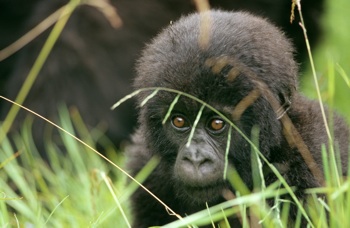 Mobile game to help save embattled gorillas in the Congo Mobile game to help save embattled gorillas in the Congo Jeremy Hance, mongabay.com April 16, 2008 For mobile users a new mobile game hopes to raise awareness of the plight of the mountain gorilla and funds for their conservation. Silverback takes gamers through eight levels, […]
Mobile game to help save embattled gorillas in the Congo Mobile game to help save embattled gorillas in the Congo Jeremy Hance, mongabay.com April 16, 2008 For mobile users a new mobile game hopes to raise awareness of the plight of the mountain gorilla and funds for their conservation. Silverback takes gamers through eight levels, […]
Carbon traders, not conservationists, could save Cameroon rainforest
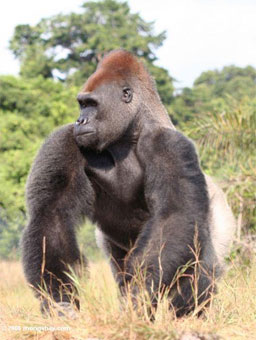 Carbon traders, not conservationists, could save Cameroon rainforest Carbon traders, not conservationists, could save Cameroon rainforest Rhett A. Butler, mongabay.com February 15, 2008 The government of Cameroon is looking to lease 830,000 hectares of biodiverse tropical forest to conservationists for an annual sum of $1.6 million. The problem? No conservation groups are interested. Apparently the […]
Carbon traders, not conservationists, could save Cameroon rainforest Carbon traders, not conservationists, could save Cameroon rainforest Rhett A. Butler, mongabay.com February 15, 2008 The government of Cameroon is looking to lease 830,000 hectares of biodiverse tropical forest to conservationists for an annual sum of $1.6 million. The problem? No conservation groups are interested. Apparently the […]
First photos of face-to-face mating by gorillas in the wild
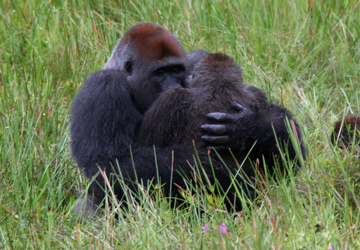 Scientists have taken the first photos of face-to-face copulation by wild gorillas. The images were captured in Nouabalé-Ndoki National Park in the Republic of Congo. “Understanding the behavior of our cousins the great apes sheds light on the evolution of behavioral traits in our own species and our ancestors,” said Thomas Breuer, a researcher at […]
Scientists have taken the first photos of face-to-face copulation by wild gorillas. The images were captured in Nouabalé-Ndoki National Park in the Republic of Congo. “Understanding the behavior of our cousins the great apes sheds light on the evolution of behavioral traits in our own species and our ancestors,” said Thomas Breuer, a researcher at […]
Rare gorillas use weapons to attack forest-intruding humans
 Rare gorillas use weapons to attack forest-intruding humans Rare gorillas use weapons to attack forest-intruding humans mongabay.com December 5, 2007 Following the first documented cases of the Cross River gorillas — world’s most endangered gorilla — throwing sticks and clumps of grass when threatened by people, the Wildlife Conservation Society (WCS) has announced new research […]
Rare gorillas use weapons to attack forest-intruding humans Rare gorillas use weapons to attack forest-intruding humans mongabay.com December 5, 2007 Following the first documented cases of the Cross River gorillas — world’s most endangered gorilla — throwing sticks and clumps of grass when threatened by people, the Wildlife Conservation Society (WCS) has announced new research […]
16,306 species threatened with extinction
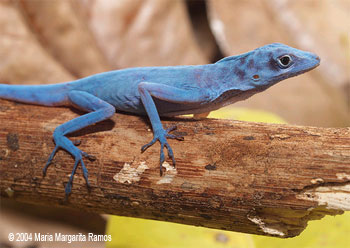 16,306 species threatened with extinction 16,306 species threatened with extinction mongabay.com September 12, 2007 40% of species assessed by IUCN are threatened with extinction. New tally represents a 1.2 percent increase (187 species) in listed species since 2006 update 16,306 of 41,415 species on the IUCN Red List are threatened with extinction, reports the World […]
16,306 species threatened with extinction 16,306 species threatened with extinction mongabay.com September 12, 2007 40% of species assessed by IUCN are threatened with extinction. New tally represents a 1.2 percent increase (187 species) in listed species since 2006 update 16,306 of 41,415 species on the IUCN Red List are threatened with extinction, reports the World […]
Rebels invade Congo gorilla sanctuary, park rangers evacuated
 Rebels invade Congo gorilla sanctuary, park rangers evacuated Rebels invade Congo gorilla sanctuary, park rangers evacuated mongabay.com September 4, 2007 Guerillas have invaded Virunga National Park in the Democratic Republic of Congo, causing park rangers to flee, and leaving critically endangered mountain gorillas at great risk, reports Wildlife Direct, a group that promotes wildlife protection […]
Rebels invade Congo gorilla sanctuary, park rangers evacuated Rebels invade Congo gorilla sanctuary, park rangers evacuated mongabay.com September 4, 2007 Guerillas have invaded Virunga National Park in the Democratic Republic of Congo, causing park rangers to flee, and leaving critically endangered mountain gorillas at great risk, reports Wildlife Direct, a group that promotes wildlife protection […]
Photo: newborn mountain gorilla born in Congo
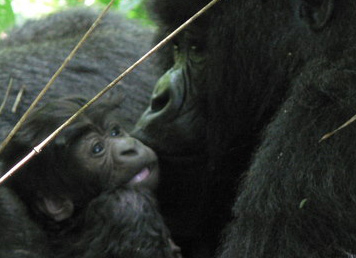 Photo: newborn mountain gorilla born in Congo Photo: newborn mountain gorilla born in Congo mongabay.com August 23, 2007 Conservationists announced the birth of a critically endangered mountain gorilla in the Democratic Republic of Congo’s Virunga National Park. The newborn marked a positive development for the embattled apes in the park — nine out of its […]
Photo: newborn mountain gorilla born in Congo Photo: newborn mountain gorilla born in Congo mongabay.com August 23, 2007 Conservationists announced the birth of a critically endangered mountain gorilla in the Democratic Republic of Congo’s Virunga National Park. The newborn marked a positive development for the embattled apes in the park — nine out of its […]
U.N. sends team to investigate gorilla killings
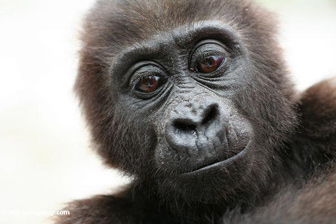 U.N. sends team to investigate gorilla killings U.N. sends team to investigate gorilla killings mongabay.com August 10, 2007 The U.N. said it will send a team of experts to probe the killings of critically endangered mountain gorillas in the Democratic Republic of the Congo (DRC). Four gorillas were shot “execution-style” last month, while three others […]
U.N. sends team to investigate gorilla killings U.N. sends team to investigate gorilla killings mongabay.com August 10, 2007 The U.N. said it will send a team of experts to probe the killings of critically endangered mountain gorillas in the Democratic Republic of the Congo (DRC). Four gorillas were shot “execution-style” last month, while three others […]
Rare gorillas slaughtered in mass killing
 Rare gorillas slaughtered in mass killing Rare gorillas slaughtered in mass killing mongabay.com July 24, 2007 At least four critically endangered gorillas have been killed in Democratic Republic of Congo’s Virunga National Park. National Geographic News reports they were shot “execution-style”. Illegal charcoal harvesters are leading suspects in the slaying. Two other gorillas are missing […]
Rare gorillas slaughtered in mass killing Rare gorillas slaughtered in mass killing mongabay.com July 24, 2007 At least four critically endangered gorillas have been killed in Democratic Republic of Congo’s Virunga National Park. National Geographic News reports they were shot “execution-style”. Illegal charcoal harvesters are leading suspects in the slaying. Two other gorillas are missing […]
Time running out for world’s rarest gorilla
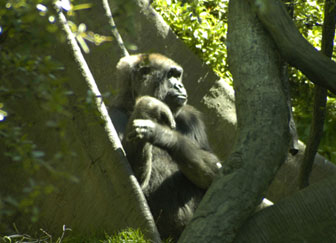 Time running out for world’s rarest gorilla Time running out for world’s rarest gorilla mongabay.com June 21, 2007 Time is running out for the world’s rarest subspecies of gorilla, the Cross River gorilla (Gorilla gorilla diehli) from the mountainous border region between Cameroon and Nigeria. With less than 300 individuals remaining, conservationists have drawn up […]
Time running out for world’s rarest gorilla Time running out for world’s rarest gorilla mongabay.com June 21, 2007 Time is running out for the world’s rarest subspecies of gorilla, the Cross River gorilla (Gorilla gorilla diehli) from the mountainous border region between Cameroon and Nigeria. With less than 300 individuals remaining, conservationists have drawn up […]
Congo guerillas threaten to kill rare gorillas
 Congo guerillas threaten to kill rare gorillas Congo guerillas threaten to kill rare gorillas mongabay.com May 21, 2007 Fresh off killing a park ranger, a group of Congo guerillas said they will slaughter highly endangered mountain gorillas in Congo’s Virunga National Park if their demands for immunity aren’t met, says WildlifeDirect, a wildlife conservation organization […]
Congo guerillas threaten to kill rare gorillas Congo guerillas threaten to kill rare gorillas mongabay.com May 21, 2007 Fresh off killing a park ranger, a group of Congo guerillas said they will slaughter highly endangered mountain gorillas in Congo’s Virunga National Park if their demands for immunity aren’t met, says WildlifeDirect, a wildlife conservation organization […]
Rare mountain gorillas in Uganda on the increase
 Rare mountain gorillas in Uganda on the increase Rare mountain gorillas in Uganda on the increase Rhett A. Butler, mongabay.com April 20, 2007 Juvenile gorilla in Bwindi (top), in search in gorillas in Bwindi (middle), adult male silverback gorilla (second middle), border of Bwindi Impenetrable National Park. Photos by Rhett A. Butler Highly endangered mountain […]
Rare mountain gorillas in Uganda on the increase Rare mountain gorillas in Uganda on the increase Rhett A. Butler, mongabay.com April 20, 2007 Juvenile gorilla in Bwindi (top), in search in gorillas in Bwindi (middle), adult male silverback gorilla (second middle), border of Bwindi Impenetrable National Park. Photos by Rhett A. Butler Highly endangered mountain […]
Congo guerrillas agree to protect rare gorillas
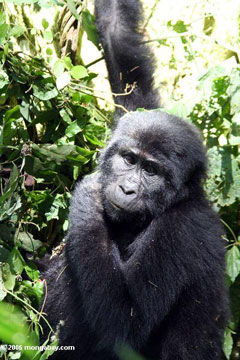 Congo guerrillas agree to protect rare gorillas Congo guerrillas agree to protect rare gorillas mongabay.com January 24, 2007 Rebels in eastern Congo have agreed to stop hunting mountain gorillas according to a report from the Associated Press. The agreement comes after two endangered silverback mountain gorillas were killed and eaten by rebel forces in Congo’s […]
Congo guerrillas agree to protect rare gorillas Congo guerrillas agree to protect rare gorillas mongabay.com January 24, 2007 Rebels in eastern Congo have agreed to stop hunting mountain gorillas according to a report from the Associated Press. The agreement comes after two endangered silverback mountain gorillas were killed and eaten by rebel forces in Congo’s […]
Ebola kills thousands of gorillas in African park
 Ebola outbreaks kill 25% of world’s gorillas Ebola outbreaks kill 25% of world’s gorillas Disease hits African parks, $35M could save apes from hemorrhagic fever mongabay.com December 7, 2006 The Ebola virus, a nasty hemorrhagic fever that causes massive organ failure and bleeding, is killing thousands of endangered gorillas across Central African forests according to […]
Ebola outbreaks kill 25% of world’s gorillas Ebola outbreaks kill 25% of world’s gorillas Disease hits African parks, $35M could save apes from hemorrhagic fever mongabay.com December 7, 2006 The Ebola virus, a nasty hemorrhagic fever that causes massive organ failure and bleeding, is killing thousands of endangered gorillas across Central African forests according to […]
Orangutans and chimps are smarter than monkeys and lemurs
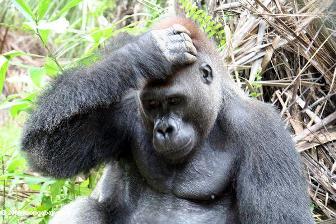 Orangutans and chimps are smarter than monkeys and lemurs Orangutans and chimps are smarter than monkeys and lemurs mongabay.com August 1, 2006 The great apes are the smartest of all nonhuman primates according to scientists at Duke University Medical Center. The researchers found that orangutans and chimpanzees consistently outperformed monkeys and lemurs on a variety […]
Orangutans and chimps are smarter than monkeys and lemurs Orangutans and chimps are smarter than monkeys and lemurs mongabay.com August 1, 2006 The great apes are the smartest of all nonhuman primates according to scientists at Duke University Medical Center. The researchers found that orangutans and chimpanzees consistently outperformed monkeys and lemurs on a variety […]
Bushmeat from African apes sold in American markets
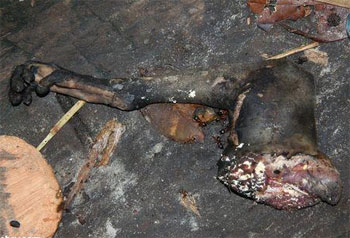 Bushmeat from African apes sold in American markets Bushmeat from African apes sold in American markets mongabay.com July 6, 2006 Bushmeat from wild primates in Africa is ending up on plates in North America and western Europe according to an article published in the current issue of New Scientist. Justin Brashares, a wildlife biologist at […]
Bushmeat from African apes sold in American markets Bushmeat from African apes sold in American markets mongabay.com July 6, 2006 Bushmeat from wild primates in Africa is ending up on plates in North America and western Europe according to an article published in the current issue of New Scientist. Justin Brashares, a wildlife biologist at […]
Pictures of Gabon: gorillas, rainforest and white sand beaches
 Pictures of Gabon: gorillas, rainforest and white sand beaches Pictures of Gabon: gorillas, rainforest and white sand beaches mongabay.com June 26, 2006 Mongabay.com, a leading rainforest and environmental web site, today announced the availability of new photos from the Central African country of Gabon. The pictures are available at travel.mongabay.com/gabon/ Site founder Rhett A. Butler […]
Pictures of Gabon: gorillas, rainforest and white sand beaches Pictures of Gabon: gorillas, rainforest and white sand beaches mongabay.com June 26, 2006 Mongabay.com, a leading rainforest and environmental web site, today announced the availability of new photos from the Central African country of Gabon. The pictures are available at travel.mongabay.com/gabon/ Site founder Rhett A. Butler […]
Congo gorillas survive war, survey finds higher count than expected
Congo gorillas survive war, survey finds higher count than expected Congo gorillas survive war, survey finds higher count than expected Dian Fossey Gorilla Fund International release September 30, 2005 New scientific surveys by the Dian Fossey Gorilla Fund International in the Democratic Republic of Congo (DRC) have revealed some encouraging news about the status of […]
Gorillas use tools – photo documentation
 Do gorillas use tools? Yes, photo documentation by WCS scientist Gorillas use tools – photo documentation WCS release September 29, 2005 Scientists from the Wildlife Conservation Society and other organizations observed this gorilla in the Republic of Congo using a stick to test a pool of water for depth before wading into it. It is […]
Do gorillas use tools? Yes, photo documentation by WCS scientist Gorillas use tools – photo documentation WCS release September 29, 2005 Scientists from the Wildlife Conservation Society and other organizations observed this gorilla in the Republic of Congo using a stick to test a pool of water for depth before wading into it. It is […]
WCS supports new primate protection agreement
WCS supports new primate protection agreement WCS supports new primate protection agreement WCS press release September 15, 2005 NEW YORK (Sept. 13, 2005) – The Bronx Zoo-based Wildlife Conservation Society (WCS) announced today that a new international agreement signed last week in the Democratic Republic of Congo will play a key role in safeguarding and […]
Poverty decimates great apes
 Poverty decimates great apes Poverty decimates great apes UNEP World Conservation Monitoring Centre press release September 5, 2005 Mountain gorilla. London 1st September 2005: Fewer than 250 wild Sumatran orangutans may exist in fifty years, their habitat is disappearing and the devastation of the Asian tsunami has accelerated the rate of destruction. This is among […]
Poverty decimates great apes Poverty decimates great apes UNEP World Conservation Monitoring Centre press release September 5, 2005 Mountain gorilla. London 1st September 2005: Fewer than 250 wild Sumatran orangutans may exist in fifty years, their habitat is disappearing and the devastation of the Asian tsunami has accelerated the rate of destruction. This is among […]
Feeds: news | india | latam | brasil | indonesia
 Mountain gorillas in Virunga National Park. Photo by: Cai Tjeenk Willink/Creative Commons 3.0. Last Friday, the government of the Democratic Republic of Congo (DRC) announced it was considering changing the boundaries of Virunga National Park to accommodate oil exploitation. Africa’s oldest park, Virunga is home to around a quarter of the world’s mountain gorillas (Gorilla […]
Mountain gorillas in Virunga National Park. Photo by: Cai Tjeenk Willink/Creative Commons 3.0. Last Friday, the government of the Democratic Republic of Congo (DRC) announced it was considering changing the boundaries of Virunga National Park to accommodate oil exploitation. Africa’s oldest park, Virunga is home to around a quarter of the world’s mountain gorillas (Gorilla […] Tofala Wildlife Sanctuary will help protect 20-30 Cross River gorillas – about 10 percent of the subspecies The Cross River Gorilla (Gorilla gorilla diehli), the rarest and most threatened of gorilla subspecies, has reason to cheer. Last month, on September 29, the Prime Minister of Cameroon, Philemon Yang, signed a decree to officially create a […]
Tofala Wildlife Sanctuary will help protect 20-30 Cross River gorillas – about 10 percent of the subspecies The Cross River Gorilla (Gorilla gorilla diehli), the rarest and most threatened of gorilla subspecies, has reason to cheer. Last month, on September 29, the Prime Minister of Cameroon, Philemon Yang, signed a decree to officially create a […] Uganda, Ethiopia, and the DRC made lofty forest restoration pledges Forest during the UN Climate Summit last month. Will they follow through? The United Nations Climate Summit at the end of September saw a host of governments, agencies and organizations rally around an international agreement aimed at stopping deforestation called the New York Declaration on […]
Uganda, Ethiopia, and the DRC made lofty forest restoration pledges Forest during the UN Climate Summit last month. Will they follow through? The United Nations Climate Summit at the end of September saw a host of governments, agencies and organizations rally around an international agreement aimed at stopping deforestation called the New York Declaration on […] Logging companies threaten to undermine the mining industry’s efforts to leave biodiversity better off One of the largest iron ore deposits in Africa is located in a strip 47 kilometers long and three kilometers wide in the Republic of the Congo (RoC), bordering Gabon. A core section of the Guineo-Congolian Forest rises above this vast […]
Logging companies threaten to undermine the mining industry’s efforts to leave biodiversity better off One of the largest iron ore deposits in Africa is located in a strip 47 kilometers long and three kilometers wide in the Republic of the Congo (RoC), bordering Gabon. A core section of the Guineo-Congolian Forest rises above this vast […] CITES has responded to this commentary, refuting certain points: Information on CITES and great apes, including on the outcomes of Standing Committee 65, can be found on the CITES website. The author found baby chimpanzees offered for sale on Facebook as pets for children. The seller, a woman in Cameroon, promised to provide all necessary […]
CITES has responded to this commentary, refuting certain points: Information on CITES and great apes, including on the outcomes of Standing Committee 65, can be found on the CITES website. The author found baby chimpanzees offered for sale on Facebook as pets for children. The seller, a woman in Cameroon, promised to provide all necessary […] Is the great ape trade responsible for the current outbreak of Ebola? The vicious Ebola virus outbreak that has already killed more than 800 people this year, in addition to sowing panic, fear and confusion throughout West Africa, was not a strain endemic to the region as initially believed. Instead the University of Edinburgh found […]
Is the great ape trade responsible for the current outbreak of Ebola? The vicious Ebola virus outbreak that has already killed more than 800 people this year, in addition to sowing panic, fear and confusion throughout West Africa, was not a strain endemic to the region as initially believed. Instead the University of Edinburgh found […] “You come across that crest, and … you’re going from forest that has already been exploited to this kind of no-man’s land… It just felt like you were going into this vast unknown wilderness” – Mike Fay from Eating Apes by Dale Peterson and Karl Ammann. Mike Fay, famed explorer and conservationist, said this of […]
“You come across that crest, and … you’re going from forest that has already been exploited to this kind of no-man’s land… It just felt like you were going into this vast unknown wilderness” – Mike Fay from Eating Apes by Dale Peterson and Karl Ammann. Mike Fay, famed explorer and conservationist, said this of […] New research shows African apes likely to be affected by palm oil, but there’s hope, says the author As palm oil producers increasingly look to Africa’s tropical forests as suitable candidates for their next plantations, primate scientists are sounding the alarm about the destruction of ape habitat that can go hand in hand with oil […]
New research shows African apes likely to be affected by palm oil, but there’s hope, says the author As palm oil producers increasingly look to Africa’s tropical forests as suitable candidates for their next plantations, primate scientists are sounding the alarm about the destruction of ape habitat that can go hand in hand with oil […] Is there hope for Africa’s most threatened ape subspecies? The mountain forests at the Nigeria-Cameroon border are home to one of the rarest and most threatened subspecies of African apes – the Cross River gorilla (Gorilla gorilla diehli). Today, fewer than 300 individuals survive in the wild. These occur in 14 small, fragmented populations spread […]
Is there hope for Africa’s most threatened ape subspecies? The mountain forests at the Nigeria-Cameroon border are home to one of the rarest and most threatened subspecies of African apes – the Cross River gorilla (Gorilla gorilla diehli). Today, fewer than 300 individuals survive in the wild. These occur in 14 small, fragmented populations spread […] What does SOCO’s withdrawal really mean for the future of Virunga National Park? – Part II. Read part I here. “SOCO is pleased that we were able to work together with WWF to hopefully find a way to jointly improve conditions in Virunga National Park and for its inhabitants,” said Roger Cagle, Deputy CEO of […]
What does SOCO’s withdrawal really mean for the future of Virunga National Park? – Part II. Read part I here. “SOCO is pleased that we were able to work together with WWF to hopefully find a way to jointly improve conditions in Virunga National Park and for its inhabitants,” said Roger Cagle, Deputy CEO of […] As an environmental journalist covering stories from the great Arctic ice melt to the rhino poaching crisis in Africa, you’ll forgive me if sometimes in the morning—before I turn my computer on—I have a sudden desire to spend a few extra minutes in bed or have a leisurely breakfast with my daughter or just sit […]
As an environmental journalist covering stories from the great Arctic ice melt to the rhino poaching crisis in Africa, you’ll forgive me if sometimes in the morning—before I turn my computer on—I have a sudden desire to spend a few extra minutes in bed or have a leisurely breakfast with my daughter or just sit […] Mountain gorillas in Virunga National Park. Photo by: Cai Tjeenk Willink/Creative Commons 3.0. In a surprise announcement, British oil company Soco International has said it will suspend exploratory operations in Virunga National Park, home to half the world’s Critically Endangered mountain gorillas (Gorilla beringei beringei) as well as thousands of other species. The announcement follows […]
Mountain gorillas in Virunga National Park. Photo by: Cai Tjeenk Willink/Creative Commons 3.0. In a surprise announcement, British oil company Soco International has said it will suspend exploratory operations in Virunga National Park, home to half the world’s Critically Endangered mountain gorillas (Gorilla beringei beringei) as well as thousands of other species. The announcement follows […] Harnessing big data for conservation. The world’s largest remote camera trap initiative—monitoring 275 species in 17 protected areas—is getting some big data assistance from Hewlett-Packard (HP). To date, the monitoring program known as the Tropical Ecology Assessment and Monitoring (TEAM) Network has taken over 1.5 million photos of animals in 14 tropical countries, but conservationists […]
Harnessing big data for conservation. The world’s largest remote camera trap initiative—monitoring 275 species in 17 protected areas—is getting some big data assistance from Hewlett-Packard (HP). To date, the monitoring program known as the Tropical Ecology Assessment and Monitoring (TEAM) Network has taken over 1.5 million photos of animals in 14 tropical countries, but conservationists […] The reintroduction of captive gorillas to areas where they have been hunted to extinction appears to working, suggesting a possible new front in efforts to save great apes, finds a new study published in the journal Oryx. The study, conducted by researchers at the Aspinall Foundation, looked at long-running reintroduction projects in Gabon and the […]
The reintroduction of captive gorillas to areas where they have been hunted to extinction appears to working, suggesting a possible new front in efforts to save great apes, finds a new study published in the journal Oryx. The study, conducted by researchers at the Aspinall Foundation, looked at long-running reintroduction projects in Gabon and the […] The 2013 Zoos and Aquariums: Committing to Conservation (ZACC) conference runs from July 8th—July 12th in Des Moines, Iowa, hosted by the Blank Park Zoo. Ahead of the event, Mongabay.com is running a series of Q&As with presenters. For more interviews, please see our ZACC feed. Ajani and his friends are caught trespassing in the […]
The 2013 Zoos and Aquariums: Committing to Conservation (ZACC) conference runs from July 8th—July 12th in Des Moines, Iowa, hosted by the Blank Park Zoo. Ahead of the event, Mongabay.com is running a series of Q&As with presenters. For more interviews, please see our ZACC feed. Ajani and his friends are caught trespassing in the […] The sunlight poured through the canopy, casting dappled shade over Makara, a large silverback mountain gorilla, as he cast his eyes around the forest clearing, checking on the members of his harem. A female gorilla reclined on a bank of dense vegetation of the most brilliant green, clutching her three day old infant close to […]
The sunlight poured through the canopy, casting dappled shade over Makara, a large silverback mountain gorilla, as he cast his eyes around the forest clearing, checking on the members of his harem. A female gorilla reclined on a bank of dense vegetation of the most brilliant green, clutching her three day old infant close to […] The newly created Ntokou-Pikounda National Park spans some 4,572 square kilometers (1,765 square miles) and will safeguard western lowland gorillas as well as elephants and chimpanzees. Photo credit: Thomas Breuer/Wildlife Conservation Society-Max Planck Institute for Evolutionary Anthropology. In 2008 the Wildlife Conservation Society (WCS) announced a jaw-dropping discovery: remote swamp forests in northern Republic of […]
The newly created Ntokou-Pikounda National Park spans some 4,572 square kilometers (1,765 square miles) and will safeguard western lowland gorillas as well as elephants and chimpanzees. Photo credit: Thomas Breuer/Wildlife Conservation Society-Max Planck Institute for Evolutionary Anthropology. In 2008 the Wildlife Conservation Society (WCS) announced a jaw-dropping discovery: remote swamp forests in northern Republic of […] Mountain gorilla family in Virunga National Park. Photo by: Martin Harvey/WWF. A mountain gorilla census in Uganda’s Bwindi Impenetrable National Park has a population that continues to rise, hitting 400 animals. The new census in Bwindi means the total population of mountain gorillas (Gorilla beringei beringei) has reached 880—up from 720 in 2007—and marking a […]
Mountain gorilla family in Virunga National Park. Photo by: Martin Harvey/WWF. A mountain gorilla census in Uganda’s Bwindi Impenetrable National Park has a population that continues to rise, hitting 400 animals. The new census in Bwindi means the total population of mountain gorillas (Gorilla beringei beringei) has reached 880—up from 720 in 2007—and marking a […] Two satellite images by NASA, one from February 13, 1999 and the other from September 1, 2008 (see below), show that Virunga National Park is under assault from deforestation. Located in the eastern edge of the Democratic Republic of Congo (DRC) the park has been assailed by entrenched conflict between rebels and government forces, as […]
Two satellite images by NASA, one from February 13, 1999 and the other from September 1, 2008 (see below), show that Virunga National Park is under assault from deforestation. Located in the eastern edge of the Democratic Republic of Congo (DRC) the park has been assailed by entrenched conflict between rebels and government forces, as […] his the Durrell Wildlife Conservation Trust’s (DWCT) first gorilla baby in nine years. Keepers have yet to establish if its a male or female. Photo courtesy of DWCT. Click to enlarge. A baby western lowland gorilla (Gorilla gorilla gorilla) was born recently at the Durrell Wildlife Conservation Trust’s (DWCT) to mother, Hlala Kahilli and first-time […]
his the Durrell Wildlife Conservation Trust’s (DWCT) first gorilla baby in nine years. Keepers have yet to establish if its a male or female. Photo courtesy of DWCT. Click to enlarge. A baby western lowland gorilla (Gorilla gorilla gorilla) was born recently at the Durrell Wildlife Conservation Trust’s (DWCT) to mother, Hlala Kahilli and first-time […] NASA Landset image of Lake Edward in Virunga National Park. Photo by: NASA. The British government has come out in opposition against oil drilling plans by UK-based, SOCO International, in Virunga National Park, reports Reuters. The first national park established on the continent, Virunga is home to one of only two populations of mountain gorillas […]
NASA Landset image of Lake Edward in Virunga National Park. Photo by: NASA. The British government has come out in opposition against oil drilling plans by UK-based, SOCO International, in Virunga National Park, reports Reuters. The first national park established on the continent, Virunga is home to one of only two populations of mountain gorillas […] Lowland gorilla in Gabon. Photo by Rhett A. Butler. Cross River gorillas and eastern gorillas lost more than half their habitat since the early 1990s due to deforestation, logging, and other human activities, finds a comprehensive new assessment across great apes’ range in West and Central Africa. The study, published in the journal Diversity and […]
Lowland gorilla in Gabon. Photo by Rhett A. Butler. Cross River gorillas and eastern gorillas lost more than half their habitat since the early 1990s due to deforestation, logging, and other human activities, finds a comprehensive new assessment across great apes’ range in West and Central Africa. The study, published in the journal Diversity and […] Named Afangui this gorilla toddler now resides in a gorilla sanctuary in Cameroon. Photo courtesy of the Zoological Society of London (ZSL). A two-year-old western lowland gorilla female was recently confiscated from a beach restaurant, popular with expats, in Equatorial Guinea. “The oil boom in Equatorial Guinea has resulted in an influx of expatriate workers […]
Named Afangui this gorilla toddler now resides in a gorilla sanctuary in Cameroon. Photo courtesy of the Zoological Society of London (ZSL). A two-year-old western lowland gorilla female was recently confiscated from a beach restaurant, popular with expats, in Equatorial Guinea. “The oil boom in Equatorial Guinea has resulted in an influx of expatriate workers […] African slender-snouted crocodile caught by hunters. Photo courtesy of ESI. Although founded only four years ago, Endangered Species International-Congo, has ambitious plans to protect dwindling Western gorilla populations and aid local people in the Republic of the Congo (Brazzaville). The organization, an offshoot of Endangered Species International (ESI), has been spending the last few years […]
African slender-snouted crocodile caught by hunters. Photo courtesy of ESI. Although founded only four years ago, Endangered Species International-Congo, has ambitious plans to protect dwindling Western gorilla populations and aid local people in the Republic of the Congo (Brazzaville). The organization, an offshoot of Endangered Species International (ESI), has been spending the last few years […].568.jpg) Captive Cross River gorilla at Limbe Wildlife Center, Limbe, Cameroon. Photo by: Julie Langford. Ever wonder what it would be like to be charged by a male gorilla? A new video (below) released by the Wildlife Conservation Society (WCS), gives one a first hand look. Shot in Cameroon’s Kagwene Gorilla Sanctuary, the video is the […]
Captive Cross River gorilla at Limbe Wildlife Center, Limbe, Cameroon. Photo by: Julie Langford. Ever wonder what it would be like to be charged by a male gorilla? A new video (below) released by the Wildlife Conservation Society (WCS), gives one a first hand look. Shot in Cameroon’s Kagwene Gorilla Sanctuary, the video is the […] An adult male gorilla—also known as a “silverback” (far right)—with a family group in Nouabalé-Ndoki National Park in the Republic of Congo. Conservationists from WCS and the Max Planck Institute for Evolutionary Anthropology recently discovered that larger male gorillas are more successful than smaller ones at attracting mates and raising young. Photo credit: Thomas Breuer/WCS. […]
An adult male gorilla—also known as a “silverback” (far right)—with a family group in Nouabalé-Ndoki National Park in the Republic of Congo. Conservationists from WCS and the Max Planck Institute for Evolutionary Anthropology recently discovered that larger male gorillas are more successful than smaller ones at attracting mates and raising young. Photo credit: Thomas Breuer/WCS. […] A portion of Virunga National Park swaddled in clouds as seen by Google Earth. Permits for controversial oil exploration in Virunga National Park have been released after request by NGO Global Witness. Oil company, SOCO International, has confirmed it has received two permits to undertake preliminary exploration, including seismic tests, in the UNESCO World Heritage […]
A portion of Virunga National Park swaddled in clouds as seen by Google Earth. Permits for controversial oil exploration in Virunga National Park have been released after request by NGO Global Witness. Oil company, SOCO International, has confirmed it has received two permits to undertake preliminary exploration, including seismic tests, in the UNESCO World Heritage […] Improving the evidence base for African great ape conservation: An interview with Sandra Tranquilli. Silverback gorilla in Bwindi Impenetrable National Park, Uganda. Photo by: Rhett A. Butler. Our closest nonhuman relatives, the great apes, are in mortal danger. Every one of the six great ape species is endangered, and without more effective conservation measures, they […]
Improving the evidence base for African great ape conservation: An interview with Sandra Tranquilli. Silverback gorilla in Bwindi Impenetrable National Park, Uganda. Photo by: Rhett A. Butler. Our closest nonhuman relatives, the great apes, are in mortal danger. Every one of the six great ape species is endangered, and without more effective conservation measures, they […] A young “naive” chimp from the Goualougo Triangle. Photo by: Michael Nichols, National Geographic. The Republic of the Congo has expanded its Nouabalé-Ndoki National Park by 37,295 hectares (144 square miles) to include a dense swamp forest, home to a population of chimpanzees (Pan troglodytes) that show no fear of humans. Known as the Goualougo […]
A young “naive” chimp from the Goualougo Triangle. Photo by: Michael Nichols, National Geographic. The Republic of the Congo has expanded its Nouabalé-Ndoki National Park by 37,295 hectares (144 square miles) to include a dense swamp forest, home to a population of chimpanzees (Pan troglodytes) that show no fear of humans. Known as the Goualougo […] Mountain gorillas in Uganda’s Bwindi Impenetrable National Park. The price of a daily gorilla permit has more than doubled since this photo was taken in 2006. Rwanda has raised the price of a permit to see mountain gorillas to $750 per day starting June 1, 2012, up from $500. While the price is steep, the […]
Mountain gorillas in Uganda’s Bwindi Impenetrable National Park. The price of a daily gorilla permit has more than doubled since this photo was taken in 2006. Rwanda has raised the price of a permit to see mountain gorillas to $750 per day starting June 1, 2012, up from $500. While the price is steep, the […] Female western lowland gorilla with infant in captivity. Photo by: Rhett A. Butler. Forest ranger, Zomedel Pierre Achille, was brutally murdered by gorilla poachers near Lobéké National Park in Cameroon, according to the World Wide Fund for Nature (WWF). Achille and another ranger, Jean Fils Mamendji, attempted to take poachers into custody after discovering the […]
Female western lowland gorilla with infant in captivity. Photo by: Rhett A. Butler. Forest ranger, Zomedel Pierre Achille, was brutally murdered by gorilla poachers near Lobéké National Park in Cameroon, according to the World Wide Fund for Nature (WWF). Achille and another ranger, Jean Fils Mamendji, attempted to take poachers into custody after discovering the […] Grauer’s gorilla is the world’s largest gorilla. Photo copyright A. Plumptre/Wildlife Conservation Society. A population of the world’s largest gorilla subspecies has increased despite ongoing human conflict, reports the Wildlife Conservation Society (WCS). A survey of Kahuzi-Biega National Park in the Democratic Republic of Congo turned up 181 Grauer’s gorillas, up from 168 in 2004 […]
Grauer’s gorilla is the world’s largest gorilla. Photo copyright A. Plumptre/Wildlife Conservation Society. A population of the world’s largest gorilla subspecies has increased despite ongoing human conflict, reports the Wildlife Conservation Society (WCS). A survey of Kahuzi-Biega National Park in the Democratic Republic of Congo turned up 181 Grauer’s gorillas, up from 168 in 2004 […] Lowland gorilla in Gabon. Photo by Rhett A. Butler. Distinguished conservation luminaries, eminent primate experts, ape-suited bucket wielders, a group of African drummers and nearly 1,500 people gathered in London last week for an evening of talks to shine the spotlight on the plight of apes and the forests in which they live, sending a […]
Lowland gorilla in Gabon. Photo by Rhett A. Butler. Distinguished conservation luminaries, eminent primate experts, ape-suited bucket wielders, a group of African drummers and nearly 1,500 people gathered in London last week for an evening of talks to shine the spotlight on the plight of apes and the forests in which they live, sending a […] Conservation appears to be working for the Critically Endangered mountain gorilla (Gorilla beringei beringei) in the Virunga massif region, as a new census shows an additional 100 individuals from the last census in 2003, an increase of over a quarter. The Virunga massif is a region in three nations—Rwanda, the Democratic Republic of Congo, and […]
Conservation appears to be working for the Critically Endangered mountain gorilla (Gorilla beringei beringei) in the Virunga massif region, as a new census shows an additional 100 individuals from the last census in 2003, an increase of over a quarter. The Virunga massif is a region in three nations—Rwanda, the Democratic Republic of Congo, and […] Most people wish each day had more than 24 hours. But as the planet heats up, that limited number of hours might push endangered African apes even closer to extinction by making their current habitats unsuitable for their lifestyle, according to a controversial study published on 23 July in the Journal of Biogeography. Researchers from […]
Most people wish each day had more than 24 hours. But as the planet heats up, that limited number of hours might push endangered African apes even closer to extinction by making their current habitats unsuitable for their lifestyle, according to a controversial study published on 23 July in the Journal of Biogeography. Researchers from […] As nations from around the world meet at the Convention on Biological Diversity in Nagoya, Japan to discuss ways to stem the loss of biodiversity worldwide, two prominent researchers argue that environmentalists and conservationists need to consider paradigm shifts if biodiversity is to be preserved, especially in developing countries. Writing in the journal Biotropica, Douglas […]
As nations from around the world meet at the Convention on Biological Diversity in Nagoya, Japan to discuss ways to stem the loss of biodiversity worldwide, two prominent researchers argue that environmentalists and conservationists need to consider paradigm shifts if biodiversity is to be preserved, especially in developing countries. Writing in the journal Biotropica, Douglas […] Spreading over three central African nations—Cameroon, Central African Republic, and Republic of Congo—the Sangha tri-national landscape is home to a variety of actors: over 150,000 Bantu people and nearly 20,000 pygmies; endangered species including forest elephants and gorillas; and, not least, the Congo rainforest ecosystem itself, which here remains largely intact. Given its interplay of […]
Spreading over three central African nations—Cameroon, Central African Republic, and Republic of Congo—the Sangha tri-national landscape is home to a variety of actors: over 150,000 Bantu people and nearly 20,000 pygmies; endangered species including forest elephants and gorillas; and, not least, the Congo rainforest ecosystem itself, which here remains largely intact. Given its interplay of […] In a landscape-wide study in the Congo, the Wildlife Conservation Society (WCS) found that core protected areas and strong anti-poaching efforts are necessary to maintain viable populations of forest elephants, western lowland gorillas, and chimpanzees—all of which are threatened with extinction. Evaluating various land-uses in the Republic of Congo’s Ndoki-Likouala Conservation Landscape—including a national park, […]
In a landscape-wide study in the Congo, the Wildlife Conservation Society (WCS) found that core protected areas and strong anti-poaching efforts are necessary to maintain viable populations of forest elephants, western lowland gorillas, and chimpanzees—all of which are threatened with extinction. Evaluating various land-uses in the Republic of Congo’s Ndoki-Likouala Conservation Landscape—including a national park, […] In a place of poverty and hunger, how do you save a species on the edge of extinction? A difficult question that conservationists have long-been working to tackle, the Wildlife Conservation Society (WCS) has come up with a new plan to protect the world’s most endangered gorilla, the Cross River gorilla, from poachers by providing […]
In a place of poverty and hunger, how do you save a species on the edge of extinction? A difficult question that conservationists have long-been working to tackle, the Wildlife Conservation Society (WCS) has come up with a new plan to protect the world’s most endangered gorilla, the Cross River gorilla, from poachers by providing […] Gorillas may disappear across much of the Congo Basin by the mid 2020s unless action is taken to protect against poaching and habitat destruction, warns a new report issued by United Nations and INTERPOL. The Last Stand of the Gorilla – Environmental Crime and Conflict in the Congo Basin — released at the CITES meeting […]
Gorillas may disappear across much of the Congo Basin by the mid 2020s unless action is taken to protect against poaching and habitat destruction, warns a new report issued by United Nations and INTERPOL. The Last Stand of the Gorilla – Environmental Crime and Conflict in the Congo Basin — released at the CITES meeting […] Experts release list of the world’s top 25 most endangered primates. Of the known 634 primate species in the world 48 percent are currently threatened with extinction, making mankind’s closes relatives one of the most endangered animal groups in the world. In order to bring awareness to the desperate state of primates, a new report […]
Experts release list of the world’s top 25 most endangered primates. Of the known 634 primate species in the world 48 percent are currently threatened with extinction, making mankind’s closes relatives one of the most endangered animal groups in the world. In order to bring awareness to the desperate state of primates, a new report […] The first ever professional footage of the world’s rarest gorilla, the Cross River gorilla ( Gorilla gorilla diehli), has been shot deep in the forested mountains of Cameroon. The only other existing footage of this Critically Endangered subspecies was taken from far away by a field researcher in 2005. After weeks of effort, the Hamburg-based […]
The first ever professional footage of the world’s rarest gorilla, the Cross River gorilla ( Gorilla gorilla diehli), has been shot deep in the forested mountains of Cameroon. The only other existing footage of this Critically Endangered subspecies was taken from far away by a field researcher in 2005. After weeks of effort, the Hamburg-based […] Seven poor African children fly to Paris on dream-of-a-lifetime trip to be crowned ‘Young Ambassadors of the Great Apes’ “It’s the gorillas I’ve got to thank for bringing me here,” said Sephora Binet-Mboti, (13), as she gazed up, wide-eyed, at the Eiffel Tower in Paris. She was a long way from her in home in […]
Seven poor African children fly to Paris on dream-of-a-lifetime trip to be crowned ‘Young Ambassadors of the Great Apes’ “It’s the gorillas I’ve got to thank for bringing me here,” said Sephora Binet-Mboti, (13), as she gazed up, wide-eyed, at the Eiffel Tower in Paris. She was a long way from her in home in […] Promoting reduced impact logging in forest areas already under concession could help protect populations of endangered great apes, argues a new report published by WWF. Analyzing scientific studies on the consequences of different types of logging on great apes, Arnold van Kreveld and Ingrid Roerhorst found that logging concessions certified by the Forest Stewardship Council […]
Promoting reduced impact logging in forest areas already under concession could help protect populations of endangered great apes, argues a new report published by WWF. Analyzing scientific studies on the consequences of different types of logging on great apes, Arnold van Kreveld and Ingrid Roerhorst found that logging concessions certified by the Forest Stewardship Council […] How can bringing healthcare to local villagers in Uganda help save the Critically Endangered mountain gorilla? The answer lies in our genetics, says Dr. Gladys Kalema-Zikusoka, wildlife veterinarian and director of Conservation through Public Health (CTPH). “Because we share 98.4% genetic material with gorillas we can easily transmit diseases to each other.” Therefore, explains Kalema-Zikusoka […]
How can bringing healthcare to local villagers in Uganda help save the Critically Endangered mountain gorilla? The answer lies in our genetics, says Dr. Gladys Kalema-Zikusoka, wildlife veterinarian and director of Conservation through Public Health (CTPH). “Because we share 98.4% genetic material with gorillas we can easily transmit diseases to each other.” Therefore, explains Kalema-Zikusoka […] Primate archaeology: old science gets new members Archaeology, the study of ancient cultures and their artifacts, has always been confined to the technology of humans and direct human ancestors. However, a new study recently published in the journal Nature examines the benefits of expanding the field of archaeology to include non-human primates. Until a half-century […]
Primate archaeology: old science gets new members Archaeology, the study of ancient cultures and their artifacts, has always been confined to the technology of humans and direct human ancestors. However, a new study recently published in the journal Nature examines the benefits of expanding the field of archaeology to include non-human primates. Until a half-century […] The Africa’s Eden. Video showing release of gorillas on the island. Related articles More than 300 gorillas butchered each year in the Republic of Congo (03/27/2009) During 2008 and early 2009, Endangered Species International (ESI) conducted monitoring activities using undercover methods at key markets in the city of Pointe Noire, the second biggest city in […]
The Africa’s Eden. Video showing release of gorillas on the island. Related articles More than 300 gorillas butchered each year in the Republic of Congo (03/27/2009) During 2008 and early 2009, Endangered Species International (ESI) conducted monitoring activities using undercover methods at key markets in the city of Pointe Noire, the second biggest city in […] An 830,000-hectare tract of rainforest in Cameroon has been granted a 30-day reprieve from logging following a 4-week exploratory expedition that turned up large populations of lowland gorillas, forest elephants, mandrills, and chimpanzees, according to expedition leader Mike Korchinsky, founder of the conservation group Wildlife Works. The Cameroonian government has given Wildlife Works, which pioneered […]
An 830,000-hectare tract of rainforest in Cameroon has been granted a 30-day reprieve from logging following a 4-week exploratory expedition that turned up large populations of lowland gorillas, forest elephants, mandrills, and chimpanzees, according to expedition leader Mike Korchinsky, founder of the conservation group Wildlife Works. The Cameroonian government has given Wildlife Works, which pioneered […] The Wildlife Conservation Society (WCS) announced yesterday the discovery of eastern lowland gorilla nests in an unexplored area of the Democratic Republic of Congo (DRC), expanding the range of this little-known subspecies by 30 miles (50 kilometers). The eastern lowland gorilla, also known as Grauer’s gorilla, is currently listed as Endangered in the IUCN Red […]
The Wildlife Conservation Society (WCS) announced yesterday the discovery of eastern lowland gorilla nests in an unexplored area of the Democratic Republic of Congo (DRC), expanding the range of this little-known subspecies by 30 miles (50 kilometers). The eastern lowland gorilla, also known as Grauer’s gorilla, is currently listed as Endangered in the IUCN Red […] During 2008 and early 2009, Endangered Species International (ESI) conducted monitoring activities using undercover methods at key markets in the city of Pointe Noire, the second biggest city in Congo. Findings reveal that 95 percent of the illegal bushmeat sold originates from the Kouilou region about 100-150 km northwest to Pointe Noire where primary and […]
During 2008 and early 2009, Endangered Species International (ESI) conducted monitoring activities using undercover methods at key markets in the city of Pointe Noire, the second biggest city in Congo. Findings reveal that 95 percent of the illegal bushmeat sold originates from the Kouilou region about 100-150 km northwest to Pointe Noire where primary and […] The Wildlife Conservation Society announced today that a 42-year-old western lowland gorilla named Fubo received a free MRI scan after suffering a seizure at his home in the Bronx Zoo’s Congo Gorilla Forest exhibit. The MRI was provided by The Brain Tumor Foundation, which sent a 48-foot-long moveable MRI facility to the zoo. Overseen by […]
The Wildlife Conservation Society announced today that a 42-year-old western lowland gorilla named Fubo received a free MRI scan after suffering a seizure at his home in the Bronx Zoo’s Congo Gorilla Forest exhibit. The MRI was provided by The Brain Tumor Foundation, which sent a 48-foot-long moveable MRI facility to the zoo. Overseen by […]



 Rangers return to Virunga and begin gorilla census Rangers return to Virunga and begin gorilla census mongabay.com December 1, 2008
Rangers return to Virunga and begin gorilla census Rangers return to Virunga and begin gorilla census mongabay.com December 1, 2008 Cameroon moves to protect rarest gorilla Cameroon moves to protect rarest gorilla mongabay.com November 26, 2008
Cameroon moves to protect rarest gorilla Cameroon moves to protect rarest gorilla mongabay.com November 26, 2008 Update: Missing gorilla rangers return safely in Congo, one dies of cholera in camp Update: Missing gorilla rangers return safely in Congo, one dies of cholera in camp Jeremy Hance, mongabay.com November 6, 2008
Update: Missing gorilla rangers return safely in Congo, one dies of cholera in camp Update: Missing gorilla rangers return safely in Congo, one dies of cholera in camp Jeremy Hance, mongabay.com November 6, 2008 39 rangers missing in Virunga Park after headquarters overtaken by rebels 39 rangers missing in Virunga Park after headquarters overtaken by rebels Jeremy Hance, mongabay.com October 30, 2008
39 rangers missing in Virunga Park after headquarters overtaken by rebels 39 rangers missing in Virunga Park after headquarters overtaken by rebels Jeremy Hance, mongabay.com October 30, 2008 Gorilla refuge falls into rebel hands in Congo; Park HQ seized Gorilla refuge falls into rebel hands in Congo; Park HQ seized mongabay.com October 26, 2008 Rebels in Democratic Republic of Congo seized the headquarters of Virunga National Park — a refuge home to 200 of the world’s 700 remaining endangered mountain gorillas — according […]
Gorilla refuge falls into rebel hands in Congo; Park HQ seized Gorilla refuge falls into rebel hands in Congo; Park HQ seized mongabay.com October 26, 2008 Rebels in Democratic Republic of Congo seized the headquarters of Virunga National Park — a refuge home to 200 of the world’s 700 remaining endangered mountain gorillas — according […] New rainforest sanctuary in Cameroon already at risk from plantations, hunting New rainforest sanctuary in Cameroon already at risk from plantations, hunting mongabay.com September 15, 2008 The forests of southern Cameroon bordering Gabon are biodiversity-rich and harbor important populations of gorillas, chimpanzees, and elephants. In 1998 the government of Cameroon established the Mengamé Gorilla Sanctuary […]
New rainforest sanctuary in Cameroon already at risk from plantations, hunting New rainforest sanctuary in Cameroon already at risk from plantations, hunting mongabay.com September 15, 2008 The forests of southern Cameroon bordering Gabon are biodiversity-rich and harbor important populations of gorillas, chimpanzees, and elephants. In 1998 the government of Cameroon established the Mengamé Gorilla Sanctuary […] Cameroon and Nigeria to protect world’s rarest gorilla Cameroon and Nigeria to protect world’s rarest gorilla mongabay.com September 5, 2008 Cameroon and Nigeria have agreed to protect the the Cross River gorilla, world’s most endangered gorilla, reports the Wildlife Conservation Society, which helped broker the deal. The two West African nations will cooperate to protect […]
Cameroon and Nigeria to protect world’s rarest gorilla Cameroon and Nigeria to protect world’s rarest gorilla mongabay.com September 5, 2008 Cameroon and Nigeria have agreed to protect the the Cross River gorilla, world’s most endangered gorilla, reports the Wildlife Conservation Society, which helped broker the deal. The two West African nations will cooperate to protect […] 48% of primates threatened with extinction 48% of primates threatened with extinction mongabay.com August 5, 2008 48 percent of the world’s primate species are at risk of extinction, according to the first comprehensive review of the world’s primates since 2003. The results were released as an update to the IUCN Red List at the 22nd […]
48% of primates threatened with extinction 48% of primates threatened with extinction mongabay.com August 5, 2008 48 percent of the world’s primate species are at risk of extinction, according to the first comprehensive review of the world’s primates since 2003. The results were released as an update to the IUCN Red List at the 22nd […] Photos of massive gorilla population discovered in the Congo Massive gorilla population discovered in the Congo mongabay.com August 5, 2008 The world’s known population of critically endangered western lowland gorillas has more than doubled following a new census that revealed some 125,000 in the Republic of Congo. The survey, conducted across conducted in an area […]
Photos of massive gorilla population discovered in the Congo Massive gorilla population discovered in the Congo mongabay.com August 5, 2008 The world’s known population of critically endangered western lowland gorillas has more than doubled following a new census that revealed some 125,000 in the Republic of Congo. The survey, conducted across conducted in an area […] Planet of the Apes Has Arrived, and It Is Spain Planet of the Apes Has Arrived, and It Is Spain An editorial Nikolas Kozloff, special to mongabay.com July 3, 2008 Visiting Spain’s Barcelona zoo as a child, I was greeted to a memorable sight. In one of the cages sat a gorilla, but not just […]
Planet of the Apes Has Arrived, and It Is Spain Planet of the Apes Has Arrived, and It Is Spain An editorial Nikolas Kozloff, special to mongabay.com July 3, 2008 Visiting Spain’s Barcelona zoo as a child, I was greeted to a memorable sight. In one of the cages sat a gorilla, but not just […] Does logging contribute to AIDS deaths in Africa? Does logging contribute to AIDS deaths in Africa? Rhett Butler, mongabay.com June 14, 2008 Human-widlife interactions are an important vector for emerging diseases, especially in the tropics Logging activities in tropical Africa may pose hidden health risks to wildlife and humans according to a veterinary pathobiologist speaking […]
Does logging contribute to AIDS deaths in Africa? Does logging contribute to AIDS deaths in Africa? Rhett Butler, mongabay.com June 14, 2008 Human-widlife interactions are an important vector for emerging diseases, especially in the tropics Logging activities in tropical Africa may pose hidden health risks to wildlife and humans according to a veterinary pathobiologist speaking […] World’s rarest gorilla gets its own forest reserve World’s rarest gorilla gets its own forest reserve mongabay.com April 18, 2008 The government of Cameroon has established the first sanctuary exclusively for the world’s rarest type of ape: the Cross River gorilla, according to the Wildlife Conservation Society (WCS), which helped support the project. The Kagwene […]
World’s rarest gorilla gets its own forest reserve World’s rarest gorilla gets its own forest reserve mongabay.com April 18, 2008 The government of Cameroon has established the first sanctuary exclusively for the world’s rarest type of ape: the Cross River gorilla, according to the Wildlife Conservation Society (WCS), which helped support the project. The Kagwene […] Mobile game to help save embattled gorillas in the Congo Mobile game to help save embattled gorillas in the Congo Jeremy Hance, mongabay.com April 16, 2008 For mobile users a new mobile game hopes to raise awareness of the plight of the mountain gorilla and funds for their conservation. Silverback takes gamers through eight levels, […]
Mobile game to help save embattled gorillas in the Congo Mobile game to help save embattled gorillas in the Congo Jeremy Hance, mongabay.com April 16, 2008 For mobile users a new mobile game hopes to raise awareness of the plight of the mountain gorilla and funds for their conservation. Silverback takes gamers through eight levels, […] Carbon traders, not conservationists, could save Cameroon rainforest Carbon traders, not conservationists, could save Cameroon rainforest Rhett A. Butler, mongabay.com February 15, 2008 The government of Cameroon is looking to lease 830,000 hectares of biodiverse tropical forest to conservationists for an annual sum of $1.6 million. The problem? No conservation groups are interested. Apparently the […]
Carbon traders, not conservationists, could save Cameroon rainforest Carbon traders, not conservationists, could save Cameroon rainforest Rhett A. Butler, mongabay.com February 15, 2008 The government of Cameroon is looking to lease 830,000 hectares of biodiverse tropical forest to conservationists for an annual sum of $1.6 million. The problem? No conservation groups are interested. Apparently the […] Scientists have taken the first photos of face-to-face copulation by wild gorillas. The images were captured in Nouabalé-Ndoki National Park in the Republic of Congo. “Understanding the behavior of our cousins the great apes sheds light on the evolution of behavioral traits in our own species and our ancestors,” said Thomas Breuer, a researcher at […]
Scientists have taken the first photos of face-to-face copulation by wild gorillas. The images were captured in Nouabalé-Ndoki National Park in the Republic of Congo. “Understanding the behavior of our cousins the great apes sheds light on the evolution of behavioral traits in our own species and our ancestors,” said Thomas Breuer, a researcher at […] Rare gorillas use weapons to attack forest-intruding humans Rare gorillas use weapons to attack forest-intruding humans mongabay.com December 5, 2007 Following the first documented cases of the Cross River gorillas — world’s most endangered gorilla — throwing sticks and clumps of grass when threatened by people, the Wildlife Conservation Society (WCS) has announced new research […]
Rare gorillas use weapons to attack forest-intruding humans Rare gorillas use weapons to attack forest-intruding humans mongabay.com December 5, 2007 Following the first documented cases of the Cross River gorillas — world’s most endangered gorilla — throwing sticks and clumps of grass when threatened by people, the Wildlife Conservation Society (WCS) has announced new research […] 16,306 species threatened with extinction 16,306 species threatened with extinction mongabay.com September 12, 2007 40% of species assessed by IUCN are threatened with extinction. New tally represents a 1.2 percent increase (187 species) in listed species since 2006 update 16,306 of 41,415 species on the IUCN Red List are threatened with extinction, reports the World […]
16,306 species threatened with extinction 16,306 species threatened with extinction mongabay.com September 12, 2007 40% of species assessed by IUCN are threatened with extinction. New tally represents a 1.2 percent increase (187 species) in listed species since 2006 update 16,306 of 41,415 species on the IUCN Red List are threatened with extinction, reports the World […] Rebels invade Congo gorilla sanctuary, park rangers evacuated Rebels invade Congo gorilla sanctuary, park rangers evacuated mongabay.com September 4, 2007 Guerillas have invaded Virunga National Park in the Democratic Republic of Congo, causing park rangers to flee, and leaving critically endangered mountain gorillas at great risk, reports Wildlife Direct, a group that promotes wildlife protection […]
Rebels invade Congo gorilla sanctuary, park rangers evacuated Rebels invade Congo gorilla sanctuary, park rangers evacuated mongabay.com September 4, 2007 Guerillas have invaded Virunga National Park in the Democratic Republic of Congo, causing park rangers to flee, and leaving critically endangered mountain gorillas at great risk, reports Wildlife Direct, a group that promotes wildlife protection […] Photo: newborn mountain gorilla born in Congo Photo: newborn mountain gorilla born in Congo mongabay.com August 23, 2007 Conservationists announced the birth of a critically endangered mountain gorilla in the Democratic Republic of Congo’s Virunga National Park. The newborn marked a positive development for the embattled apes in the park — nine out of its […]
Photo: newborn mountain gorilla born in Congo Photo: newborn mountain gorilla born in Congo mongabay.com August 23, 2007 Conservationists announced the birth of a critically endangered mountain gorilla in the Democratic Republic of Congo’s Virunga National Park. The newborn marked a positive development for the embattled apes in the park — nine out of its […] U.N. sends team to investigate gorilla killings U.N. sends team to investigate gorilla killings mongabay.com August 10, 2007 The U.N. said it will send a team of experts to probe the killings of critically endangered mountain gorillas in the Democratic Republic of the Congo (DRC). Four gorillas were shot “execution-style” last month, while three others […]
U.N. sends team to investigate gorilla killings U.N. sends team to investigate gorilla killings mongabay.com August 10, 2007 The U.N. said it will send a team of experts to probe the killings of critically endangered mountain gorillas in the Democratic Republic of the Congo (DRC). Four gorillas were shot “execution-style” last month, while three others […] Rare gorillas slaughtered in mass killing Rare gorillas slaughtered in mass killing mongabay.com July 24, 2007 At least four critically endangered gorillas have been killed in Democratic Republic of Congo’s Virunga National Park. National Geographic News reports they were shot “execution-style”. Illegal charcoal harvesters are leading suspects in the slaying. Two other gorillas are missing […]
Rare gorillas slaughtered in mass killing Rare gorillas slaughtered in mass killing mongabay.com July 24, 2007 At least four critically endangered gorillas have been killed in Democratic Republic of Congo’s Virunga National Park. National Geographic News reports they were shot “execution-style”. Illegal charcoal harvesters are leading suspects in the slaying. Two other gorillas are missing […] Time running out for world’s rarest gorilla Time running out for world’s rarest gorilla mongabay.com June 21, 2007 Time is running out for the world’s rarest subspecies of gorilla, the Cross River gorilla (Gorilla gorilla diehli) from the mountainous border region between Cameroon and Nigeria. With less than 300 individuals remaining, conservationists have drawn up […]
Time running out for world’s rarest gorilla Time running out for world’s rarest gorilla mongabay.com June 21, 2007 Time is running out for the world’s rarest subspecies of gorilla, the Cross River gorilla (Gorilla gorilla diehli) from the mountainous border region between Cameroon and Nigeria. With less than 300 individuals remaining, conservationists have drawn up […] Congo guerillas threaten to kill rare gorillas Congo guerillas threaten to kill rare gorillas mongabay.com May 21, 2007 Fresh off killing a park ranger, a group of Congo guerillas said they will slaughter highly endangered mountain gorillas in Congo’s Virunga National Park if their demands for immunity aren’t met, says WildlifeDirect, a wildlife conservation organization […]
Congo guerillas threaten to kill rare gorillas Congo guerillas threaten to kill rare gorillas mongabay.com May 21, 2007 Fresh off killing a park ranger, a group of Congo guerillas said they will slaughter highly endangered mountain gorillas in Congo’s Virunga National Park if their demands for immunity aren’t met, says WildlifeDirect, a wildlife conservation organization […] Rare mountain gorillas in Uganda on the increase Rare mountain gorillas in Uganda on the increase Rhett A. Butler, mongabay.com April 20, 2007 Juvenile gorilla in Bwindi (top), in search in gorillas in Bwindi (middle), adult male silverback gorilla (second middle), border of Bwindi Impenetrable National Park. Photos by Rhett A. Butler Highly endangered mountain […]
Rare mountain gorillas in Uganda on the increase Rare mountain gorillas in Uganda on the increase Rhett A. Butler, mongabay.com April 20, 2007 Juvenile gorilla in Bwindi (top), in search in gorillas in Bwindi (middle), adult male silverback gorilla (second middle), border of Bwindi Impenetrable National Park. Photos by Rhett A. Butler Highly endangered mountain […] Congo guerrillas agree to protect rare gorillas Congo guerrillas agree to protect rare gorillas mongabay.com January 24, 2007 Rebels in eastern Congo have agreed to stop hunting mountain gorillas according to a report from the Associated Press. The agreement comes after two endangered silverback mountain gorillas were killed and eaten by rebel forces in Congo’s […]
Congo guerrillas agree to protect rare gorillas Congo guerrillas agree to protect rare gorillas mongabay.com January 24, 2007 Rebels in eastern Congo have agreed to stop hunting mountain gorillas according to a report from the Associated Press. The agreement comes after two endangered silverback mountain gorillas were killed and eaten by rebel forces in Congo’s […] Ebola outbreaks kill 25% of world’s gorillas Ebola outbreaks kill 25% of world’s gorillas Disease hits African parks, $35M could save apes from hemorrhagic fever mongabay.com December 7, 2006 The Ebola virus, a nasty hemorrhagic fever that causes massive organ failure and bleeding, is killing thousands of endangered gorillas across Central African forests according to […]
Ebola outbreaks kill 25% of world’s gorillas Ebola outbreaks kill 25% of world’s gorillas Disease hits African parks, $35M could save apes from hemorrhagic fever mongabay.com December 7, 2006 The Ebola virus, a nasty hemorrhagic fever that causes massive organ failure and bleeding, is killing thousands of endangered gorillas across Central African forests according to […] Orangutans and chimps are smarter than monkeys and lemurs Orangutans and chimps are smarter than monkeys and lemurs mongabay.com August 1, 2006 The great apes are the smartest of all nonhuman primates according to scientists at Duke University Medical Center. The researchers found that orangutans and chimpanzees consistently outperformed monkeys and lemurs on a variety […]
Orangutans and chimps are smarter than monkeys and lemurs Orangutans and chimps are smarter than monkeys and lemurs mongabay.com August 1, 2006 The great apes are the smartest of all nonhuman primates according to scientists at Duke University Medical Center. The researchers found that orangutans and chimpanzees consistently outperformed monkeys and lemurs on a variety […] Bushmeat from African apes sold in American markets Bushmeat from African apes sold in American markets mongabay.com July 6, 2006 Bushmeat from wild primates in Africa is ending up on plates in North America and western Europe according to an article published in the current issue of New Scientist. Justin Brashares, a wildlife biologist at […]
Bushmeat from African apes sold in American markets Bushmeat from African apes sold in American markets mongabay.com July 6, 2006 Bushmeat from wild primates in Africa is ending up on plates in North America and western Europe according to an article published in the current issue of New Scientist. Justin Brashares, a wildlife biologist at […] Pictures of Gabon: gorillas, rainforest and white sand beaches Pictures of Gabon: gorillas, rainforest and white sand beaches mongabay.com June 26, 2006 Mongabay.com, a leading rainforest and environmental web site, today announced the availability of new photos from the Central African country of Gabon. The pictures are available at travel.mongabay.com/gabon/ Site founder Rhett A. Butler […]
Pictures of Gabon: gorillas, rainforest and white sand beaches Pictures of Gabon: gorillas, rainforest and white sand beaches mongabay.com June 26, 2006 Mongabay.com, a leading rainforest and environmental web site, today announced the availability of new photos from the Central African country of Gabon. The pictures are available at travel.mongabay.com/gabon/ Site founder Rhett A. Butler […] Do gorillas use tools? Yes, photo documentation by WCS scientist Gorillas use tools – photo documentation WCS release September 29, 2005 Scientists from the Wildlife Conservation Society and other organizations observed this gorilla in the Republic of Congo using a stick to test a pool of water for depth before wading into it. It is […]
Do gorillas use tools? Yes, photo documentation by WCS scientist Gorillas use tools – photo documentation WCS release September 29, 2005 Scientists from the Wildlife Conservation Society and other organizations observed this gorilla in the Republic of Congo using a stick to test a pool of water for depth before wading into it. It is […] Poverty decimates great apes Poverty decimates great apes UNEP World Conservation Monitoring Centre press release September 5, 2005 Mountain gorilla. London 1st September 2005: Fewer than 250 wild Sumatran orangutans may exist in fifty years, their habitat is disappearing and the devastation of the Asian tsunami has accelerated the rate of destruction. This is among […]
Poverty decimates great apes Poverty decimates great apes UNEP World Conservation Monitoring Centre press release September 5, 2005 Mountain gorilla. London 1st September 2005: Fewer than 250 wild Sumatran orangutans may exist in fifty years, their habitat is disappearing and the devastation of the Asian tsunami has accelerated the rate of destruction. This is among […]